
Route 138 Priority Corridor Study
Canton, Massachusetts
Project Manager
Seth Asante
Project Principal
Mark Abbott
Data Analysts
Kathy Jacob
Seth Asante
Graphics
Kenneth Dumas
Kim DeLauri
Cover Design
Jane Gillis
The preparation of this document was supported
by the Federal Highway Administration through
MPO 3C PL Contract #95411
MPO 3C PL Contract #101725
MPO §5303 Contract #98873
MPO §5303 Contract #102088
Central Transportation Planning Staff
Directed by the Boston Region Metropolitan
Planning Organization (MPO). The MPO is composed of
state and regional agencies and authorities, and
local governments.

The Boston Region Metropolitan Planning Organization (MPO) selected Route 138 in the Town of Canton as the subject of a corridor study in federal fiscal year (FFY) 2017. The Route 138 Priority Corridor Study focuses on one of the locations identified in a regional needs assessment—conducted as part of the MPO’s Long-Range Transportation Plan, Charting Progress to 2040—used to guide investment decisions regarding transportation infrastructure improvements in the Boston region. The MPO prioritized this location for study after considering a number of factors: the need to address poor safety conditions and traffic congestion; the desire to enhance multimodal transportation; the need to maintain regional travel capacity; the interest in ensuring that, over time, corridor studies are funded in all subregions of the MPO’s planning area; and the potential for recommendations from the study to be implemented.
Route 138 is a regional arterial serving several communities in the Boston region: Boston, Milton, Canton, and Stoughton. The highway continues south to Fall River and into Rhode Island. In Canton, the roadway provides access to the Blue Hills Reservation recreational area, large business and industrial areas, and residential areas of single- and multi-family homes. Commercial and residential development significantly increased during the past decade, and this growth may continue. As a result, there are a growing number of pedestrians and bicyclists in the corridor; however, the current roadway configurations there inhibit walking and bicycling, and traffic safety, congestion, and mobility have become challenging issues.
The MPO staff, working with the study’s advisory task force, developed a set of improvements that would transform Route 138 into a pedestrian- and bicyclist-friendly roadway, as well as a transportation corridor that serves all modes of transportation and maintains regional travel capacity. This study provides the Town of Canton, the Massachusetts Department of Transportation (MassDOT), and other stakeholders an opportunity to review, at a conceptual level, what would be required to address the deficiencies in the corridor, before committing design and engineering funds to a roadway improvement project.
This report details the analyses of the existing conditions and assessments of safety and operational problems in the corridor, discusses options for roadway improvements, and makes recommendations for implementing improvements. The report also includes technical appendices, which cite the methods used and data applied in the study, including detailed reports about intersection capacity analyses. If implemented, the report’s recommendations would result in an improved roadway corridor where it is safe to walk or bicycle to recreational areas in the Blue Hills Reservation and workplaces in the business and industrial areas along the corridor, and where traffic operates efficiently.
table of CONTENTS PAGE
E.1 Roadway Character and Land Uses
E.2 Existing Conditions Analyses
3.2.1 Route 138 and Royall Street/Blue Hill River Road Intersection
3.2.2 Route 138 and J.W. Foster Boulevard
3.2.3 Route 138 and Green Lodge Street Intersection
3.2.4 Route 138 and Washington Street Intersection
3.2.5 Route 138 and Randolph Street Intersection
3.2.6 Route 138 and Del Pond Drive Intersection
3.2.7 Route 138 and Dan Road Intersection
3.2.8 Route 138 and New Boston Drive Intersection
3.4 Planned Projects and Studies
3.4.1 Roadway Improvements on Route 138 in Canton and Milton
3.4.2 Improvements on Route 138 from Washington Street to Randolph Street, Canton
3.4.3 Road Safety Audit, Route 138 at Randolph Street, Canton
3.4.4 Improvements and Signalization on Route 138 at Washington Street and Randolph Street, Canton
4.4 Pedestrian and Bicycle Volumes
4.5 Pedestrian Level of Service
4.8 Signal Timing and Layout Information
5.2 Traffic Operations Analyses
5.2.1 Intersection Level-of-Service Analysis
5.2.2 Traffic Signal Warrant Analysis
6.1.2 Survey Results and Findings
6.2 Summary of Problems and Concerns
6.2.1 Pedestrian and Bicyclist Problems
6.2.2 Traffic Safety and Operations Problems
6.2.3 Access Control and Management Problems
7.2 Route 138 Segment in the Blue Hills Reservation Area
7.4 Route 138 Segment at The Washington Street intersection
7.5 Route 138 Segment at the Randolph Street Intersection
7.6 Route 138 Segment at Del Pond Drive
7.7 Route 138 Segment At Dan Road and New Boston Drive
7.8 Intersection Level-of-Service Performance
7.9 Pedestrian Level-of-Service Performance with Improvements
7.10 Discussion of the Improvements
7.10.1 Sidewalks and Crosswalks
7.10.2 Bicycle Lanes and Roadway Shoulders
7.11 Examples of Model Roadways and Features
8.1 Time Frame for the Improvements
Table 1 Route 138 Segment at the Blue Hills Reservation Area
Table 2 Route 138 Segment at Royall Street/Blue Hill River Road Intersection
Table 3 Route 138 Segment at Washington Street Intersection
Table 4 Route 138 Segment at Randolph Street Intersection
Table 5 Route 138 Segment at Del Pond Drive
Table 6 Route 138 Segment at Dan Road and New Boston Drive
Table 7 Pedestrian Level-of-Service Score Card — Existing Conditions
Table 8 Weighted Pedestrian Level of Service by Goal — Existing Conditions
Table 9 2010–14 Crash Summary and Crash Rates
Table 10 Intersection Level-of-Service Criteria, 2010
Table 11 Traffic Signal Warrant Analysis: Route 138 and New Boston Drive Intersection
Table 12 Pedestrian Level-of-Service Score Card: With Improvements
Table 13 Weighted Pedestrian Level-of-Service by Goal—With Improvements
Figure 1. Route 138 Study Area and Nearby Roadways
Figure 2. Roadway Jurisdictions on Route 138 and Environs in Canton
Figure 3. Functional Classification of Roadways in the Route 138 Study Area
Figure 4. National Highway System in Canton
Figure 5. Width of Right-of-Way on Route 138 in Canton
Figure 6. Existing Roadway Shoulder Width on Route 138 in Canton
Figure 7. Existing Sidewalks on Route 138 in Canton
Figure 8. Major Intersections on Route 138 in Canton
Figure 9. Land Uses along Route 138 in Canton
Figure 10. Recent and Planned Developments along Route 138 in Canton
Figure 11. Average Weekday Traffic Volumes on Route 138 in Canton
Figure 12. Hourly Traffic-Volume Distribution on Route 138 in Canton
Figure 13. Turning Movement Volumes on Route 138 in Canton
Figure 14. Spot Speeds on Route 138 in Canton
Figure 15. Regional Transit Service in Canton
Figure 16. Crashes on Route 138 in Canton (2010-14)
Figure 17. Collision Diagram for Segment 1: Route 138 at Royall Street/Blue Hill River Road
Figure 17 (cont.). Collision Diagram for Segment 1: Route 138 at J.W. Foster Boulevard
Figure 18. Collision Diagram for Segment 2: Junction of Route 138 and Interstate 93
Figure 18 (cont.). Collision Diagram for Segment 2: Route 138 at the Interstate 93 Ramps
Figure 19. Collision Diagram for Segment 3: Route 138 at Green Lodge Street
Figure 20. Collision Diagram for Segment 4: Route 138 at Washington Street
Figure 21. Collision Diagram for Segment 5: Route 138 at Randolph Street
Figure 22. Collision Diagram for Segment 6: Route 138 at Del Pond Drive
Figure 23. Collision Diagram for Segment 7: Route 138 at Dan Road
Figure 24. Existing Level of Service on Route 138 in Canton: Weekday AM Peak Period
Figure 25. Existing Level of Service on Route 138 in Canton: Weekday PM Peak Period
Figure 26. Survey Questions and Number of Respondents
Figure 27. Priority Assigned to Route 138 Segments in Need of Complete Street Solutions
Figure 28. Existing Conditions: Route 138 in the Blue Hills Ski Area
Figure 29. Existing Conditions: Route 138 at Royall Street and the Interstate 93 Interchange
Figure 30. Existing Conditions: Route 138 from Green Lodge Street to Washington Street
Figure 31. Existing Conditions: Route 138 from Sunnybrook Lane to Meetinghouse Road
Figure 32. Existing Conditions: Route 138 from Meetinghouse Road to Canton Point Road
Figure 33. Existing Conditions: Route 138 from Canton Point Road to Industrial Drive
Figure 34. Existing Conditions: Route 138 from Industrial Drive to Windsor Woods Lane
Figure 35. Proposed Improvements: Route 138 in the Blue Hills Ski Area
Figure 36. Proposed Improvements: Intersection of Route 138 and Royall Street
Figure 37. Proposed Improvements: Route 138 at Royall Street and the Interstate 93 Interchange
Figure 38. Proposed Improvements: Route 138 from Green Lodge Street to Washington Street
Figure 41. Proposed Improvements: Route 138 from Sunnybrook Lane to Meetinghouse Road
Figure 44. Proposed Improvements: Route 138 from Meetinghouse Road to Canton Point Road
Figure 45. Proposed Improvements: Route 138 from Canton Point Road to Industrial Drive
Figure 46. Proposed Improvements: Route 138 from Industrial Drive to Windsor Woods Lane
Figure 47. 2040 Level of Service for Route 138 Intersections: Weekday AM Peak Period
Figure 48. 2040 Level of Service for Route 138 Intersections: Weekday PM Peak Period
Figure 49. Examples of Accessible Curb Ramps and High Visibility Crosswalks
Figure 50. Examples of Sidewalk Designs and Median and Pedestrian Refuge Areas
Figure 51. Examples of Pedestrian Crossing Signals
Figure 52. Examples of Roadway Types Proposed in this Study
The Boston Region Metropolitan Planning Organization (MPO) selected Route 138 in the Town of Canton as the subject of a corridor study in federal fiscal year (FFY) 2017. The Route 138 Priority Corridor Study focuses on one of the locations identified in a regional needs assessment—conducted as part of the MPO’s Long-Range Transportation Plan, Charting Progress to 2040—used to guide investment decisions regarding transportation infrastructure improvements in the Boston region. The MPO prioritized this location for study after considering a number of factors: the need to address poor safety conditions and traffic congestion; the desire to enhance multimodal transportation; the need to maintain regional travel capacity; the interest in ensuring that, over time, corridor studies are funded in all subregions of the MPO’s planning area; and the potential for recommendations from the study to be implemented.
This report details the analyses of the existing conditions and assessments of safety and operational problems in the corridor, discusses options for roadway improvements, and makes recommendations for implementing improvements. The report also includes technical appendices, which cite the methods used and data applied in the study, including detailed reports about intersection capacity analyses.
Route 138 is a regional arterial serving several communities in the Boston region: Boston, Milton, Canton, and Stoughton. The highway continues south to Fall River and into Rhode Island. In Canton, the roadway provides access to the Blue Hills Reservation recreational area, large business and industrial areas, and residential areas of single- and multi-family homes. The Massachusetts Department of Transportation (MassDOT) has jurisdiction over Route 138 and the Town of Canton has jurisdiction of the crossing streets.
A series of maps are appended to this report. The maps in Figures 1-4 show the study area, roadway jurisdictions, functional classification, and status on the National Highway System. Figure 5 shows the roadway’s right-of-way, which varies between 50 and 60 feet wide for the majority of the corridor, and widens in the Blue Hills Reservation area to about 99 feet.1 As shown in the map in Figure 6, more than 90 percent of Route 138 in Canton has paved shoulders that are five-feet wide or more on each side of the roadway, and these shoulders can be improved to promote bicycling. However, as shown in the map in Figure 7, approximately 80 percent of the corridor either lacks sidewalks or has sidewalks that do not meet MassDOT’s standards; thus a significant portion of the roadway could be retrofitted to include sidewalks and the existing substandard sidewalks could be reconstructed. Seven intersections along the corridor with safety and operations problems, shown in Figure 8, were a focus of this study.
The map in Figure 9 shows the general land-use designations for the area surrounding Route 138. Commercial and residential development significantly increased there during the past decade, and this growth may continue. As a result, there are a growing number of pedestrians and bicyclists in the corridor; however, the current roadway configurations there inhibit walking and bicycling, and traffic safety, congestion, and mobility have become challenging issues. The Town of Canton expects some of the existing vacant properties and land parcels in the corridor to be redeveloped. The map in Figure 10 shows the recent and planned development projects in the corridor, based on discussions with representatives from the Town of Canton.
Recent and planned transportation projects and studies that addressed the study area or its surroundings include the following:
MassDOT Highway Division’s Traffic Data Collection Section performed turning movement counts (TMCs), automatic traffic recorder counts, and a spot speed survey in the study area in April 2017, while schools were in session. Figures 11-14 show the average daily traffic volumes, hourly traffic-volume distribution, turning movement volumes, and spot speed data. Twenty-six bicyclists and twelve pedestrians were counted at the intersections that were the focus of this study during the two-hour weekday AM peak travel period and PM peak period. The small number of pedestrians and bicyclists are attributed primarily to the absence of pedestrian and bicycle amenities in the corridor. The MPO’s Pedestrian Report Card Assessment tool rates the corridor as poor for the quality of pedestrian travel it provides. Figure 15 is a transit service map showing the public transportation services operating in the surrounding area, including bus and commuter rail services.
MPO staff used crash data from MassDOT’s Registry of Motor Vehicles database for the time period from January 2010 through December 2014 to evaluate safety conditions for motorists, pedestrians, and bicyclists in the study area. The map in Figure 16 shows the locations along the corridor where there were a large number of crashes. There are four Highway Safety Improvement Program (HSIP) crash clusters in the corridor.2 In addition, MPO staff prepared collision diagrams that are useful for examining patterns that reveal the cause of crashes and developing safety strategies. Figures 17-23 show the collision diagrams for crash clusters in the study area.
MPO staff conducted traffic operations analyses consistent with the Highway Capacity Manual (HCM) methodologies to assess traffic conditions at selected signalized and unsignalized intersections. Figures 24 and 25 show the existing levels of service of the intersections, in terms of delay times experienced by motorists. There are three critical intersections in the corridor that influence traffic flow, two of which are failing in their level of service (LOS) during peak travel periods because of the high volume of traffic. Additionally, MPO staff investigated the need for traffic control signals at selected unsignalized intersections. A traffic signal warrant analysis justified the need for a traffic control at the intersection of Route 138 and New Boston Drive but not at the intersection of Route 138 and Del Pond Drive.
Through analyses of transportation data, a community survey, and discussions with the advisory task force members, MPO staff identified several problems and issues in the Route 138 corridor. The community survey was developed as a tool to assist in determining the public’s opinion of existing problems and their ideas for addressing those problems. This online survey, posted on the Town of Canton’s website from June 14, 2017, to July 31, 2017, generated about 300 responses. The results are presented in Figures 26-27.
The reasons why the roadway is considered unfriendly for pedestrians and bicyclists are as follows:
The traffic safety and operational problems facing roadway users include, but are not limited to, the following:
The locations where these problems and issues are prevalent are also illustrated in Figures 28-34.
The MPO staff, working with the study’s advisory task force, developed improvements that would transform Route 138 into a pedestrian- and bicyclist-friendly roadway that serves all modes of transportation and maintains regional travel capacity. For the purposes of this study, the corridor was divided into several segments. The recommended improvements within each segment are diagrammed in Figures 35-46 and described in Tables 1-6. The tables include cost estimates and indicate the time frame for implementation of each improvement.
The time frame categorized as short-term is typically less than three years. Short-term improvements are relatively uncomplicated and inexpensive to implement, and require minimal design efforts. Medium-term is typically between three and five years. Medium-term improvements are more complicated than their short-term counterparts and require more funding resources and design and engineering efforts. Long-term improvements typically require five or more years to plan and implement. They require more design and engineering efforts, environmental permitting, and larger funding resources. Cost estimates for each improvement were categorized as low (less than $10,000), medium ($10,000 to $500,000), and high ($500,000 or more).
This study provides the Town of Canton, MassDOT, and other stakeholders an opportunity to review, at a conceptual level, options for addressing the deficiencies in the corridor before committing design and engineering funds to a roadway improvement project. This study aligns with the Boston Region MPO’s goals of modernizing roadways to improve capacity and mobility, increasing safety on the region’s highway system, expanding the quantity and quality of walking and bicycling infrastructure, and making transit service more efficient. The proposed improvements offered in this report, if implemented, would increase traffic safety, make traffic operations more efficient, and modernize the roadway to accommodate all users.
| Table 1
|
||||
|---|---|---|---|---|
|
Issue |
Improvement |
Time Frame |
Cost |
Jurisdiction |
Pedestrian accommodation |
1. Reconstruct the existing substandard sidewalks and curb ramps on the west side of the roadway to MassDOT’s standards and close the gap in sidewalk network. |
Medium-term |
High |
MassDOT |
Pedestrian accommodation |
2. Install a high visibility midblock crosswalk with pedestrian signals in the vicinity of DCR’s parking lot and Mass Audubon’s Blue Hills Trailside Museum. |
Medium-term |
Medium |
MassDOT |
Pedestrian accommodation |
3. Install a high visibility midblock crosswalk with pedestrian signals in the vicinity of the MassDOT park-and-ride lot and the Skyline trail. |
Medium-term |
Medium |
MassDOT |
Pedestrian accommodation |
4. Construct new sidewalks on the east side of the roadway to improve safety and mobility for pedestrians. |
Long-term |
High |
MassDOT |
Bicycle accommodation |
5. Reconfigure the roadway to include bicycle lanes and sidewalks on both sides of the roadway. |
Medium-term |
Medium |
MassDOT |
Bicycle accommodation |
6. Use innovative designs (painted buffers) to separate bicycle lanes from vehicular travel lanes. |
Medium-term |
Medium |
MassDOT |
Bicycle accommodation |
7. Install signs and bicycle pavement markings to clearly define bicycle lanes and distinguish them from vehicle lanes. |
Short-term |
Low |
MassDOT |
Safety and congestion |
8. Install wayfinding signs to make it easier for roadway users and visitors find their way in the recreational area. |
Short-term |
Medium |
MassDOT |
Safety |
9. Install new lights and upgrade existing street lighting to improve safety and visibility at night for motorists, pedestrians, and bicyclists. |
Medium-term |
High |
MassDOT |
Safety and congestion |
10. Install a left-turn lane at MassDOT’s park-and ride lot to improve safety and traffic flow. |
Medium-term |
Medium |
MassDOT |
Safety |
11. Consider reducing the speed limit in the segment from 45 mph to 35 mph to increase safety for pedestrians, bicyclists, hikers, and skiers. |
Medium-term |
Low |
MassDOT |
Congestion |
12. Widen the roadway between MassDOT’s park-and-ride lot and Royall Street to include two northbound lanes and provide a longer distance for traffic to merge. |
Long-term |
High* |
MassDOT |
Transit |
13. Install a bus-stop sign for the stop located in the municipal parking lot at the Blue Hills Reservation. |
Short-term |
Low |
MBTA |
Pavement condition |
14. Resurface the roadway and improve drainage. |
Medium-term |
Medium |
MassDOT |
DCR = Department of Conservation and Recreation. MPH = miles per hour.
* The solution relies on widening the roadway, which can be a costly and long-term project due to time and cost required to acquire the land.
Source: Central Transportation Planning Staff.
| Table 2
|
||||
|---|---|---|---|---|
|
Issue |
Improvement |
Time Frame |
Cost |
Jurisdiction |
Pedestrian accommodation |
1. Reconstruct the existing substandard sidewalk and curb ramps on the west side of the roadway to MassDOT’s standards. |
Medium-term |
High |
MassDOT |
Pedestrian accommodation |
2. Construct a new sidewalk on the east side of the roadway to improve mobility for pedestrians. |
Medium-term |
High* |
MassDOT |
Pedestrian accommodation |
3. Provide ample walk and clearance intervals for pedestrians based on MUTCD standards. |
Short-term |
Low |
MassDOT |
Pedestrian accommodation |
4. Install countdown timers for pedestrian crossings at the Royall Street intersection. |
Short-term |
Low |
MassDOT |
Bicycle accommodation |
5. Provide in-pavement detection for bicycles at the signalized intersections. |
Short-term |
Low |
MassDOT |
Bicycle accommodation |
6. Install signs and pavement markings to clearly define bicycle lanes and distinguish them from vehicle lanes. |
Short-term |
Low |
MassDOT |
Safety |
7. Consider installing NO TURN ON RED signs to address poor sight distances on the approaches. |
Short-term |
Low |
MassDOT |
Safety |
8. Evaluate the feasibility of a southbound left-turn lane for vehicles turning onto Homans and Farrington Lanes to reduce vehicles stopping or slowing in traffic. |
Medium-term |
Medium |
MassDOT |
Safety |
9. Install overhead advance intersection lane control signs (R3-8, R3-8a, and R3-8b) on the approaches of Route 138 to indicate the configuration of all lanes ahead, sothat road users can select the appropriate lane before entering the turn lane. |
Short-term |
Low |
MassDOT |
Safety and access management |
10. Install a raised median on the south leg of Route 138 in the vicinity of the Mobil, Shell, and Blue Hill Express gas stations to prevent unsafe left-turns to and from the driveways within the functional area of the intersection. |
Medium-term |
Medium |
MassDOT |
Safety and access management |
11. Manage driveway access for the gas stations on the south leg of the intersection by converting them into right-in only and right-out only driveways. Allow northbound U-turns so drivers can access the gas stations. |
Medium-term |
Low |
MassDOT and property owners |
Safety and access management |
12. Install signs to direct left-turning vehicles from the gas stations heading northbound on Route 138 or to Royall Street or Blue Hill River Road to use Royall Avenue and J.W. Foster Boulevard. |
Short-term |
Low |
MassDOT |
Safety and access management |
13. Extend the raised median on the north leg of Route 138 to limit left turns to and from driveways within the functional area of the intersection. |
Medium-term |
Medium |
MassDOT |
Safety and visibility |
14. Enhance street lighting on Route 138 to improve visibility at night and increase safety for motorists, pedestrians, and bicyclists. |
Medium-term |
High |
MassDOT |
Safety and congestion |
15. Consider an alternative interchange design that allows signal coordination and signalized pedestrian crossings, such as modified or diverging diamond interchange designs. |
Long-term |
High* |
MassDOT |
Safety and congestion |
16. Widen the segment of Route 138 between MassDOT’s park-and-ride lot and the Royall Street/Blue Hill River Road intersection and extend the two receiving lanes from 350 feet to approximately 750 feet to reduce the impacts of the short merging distance. |
Long-term |
High |
MassDOT |
Safety and congestion |
17. Widen the Route 138 bridge over the Interstate 93 bridge to accommodate a weaving lane to make traffic flow better and provide room to better accommodate pedestrians and bicyclists. |
Long-term |
High* |
MassDOT |
Congestion |
18. Retime the traffic signal with current traffic data to improve traffic flow. |
Short-term |
Low |
MassDOT |
Congestion |
19. Upgrade the signal equipment to include an Opticom system for emergency preemption. |
Short-term |
Medium |
MassDOT |
Congestion |
20. Install wayfinding signs to make it easier for roadway users and visitors find their way in the business and recreational areas. |
Short-term |
Medium |
MassDOT and DCR |
Transit |
21. Add signs for the bus stops at the Route 138 and Royall Street intersection. |
Short-term |
Low |
MBTA |
Visibility of signal head |
22. Upgrade the signal-head backplates to conform to MassDOT’s current standards (black background with retroreflective yellow border). |
Short-term |
Low |
MassDOT |
DCR= Department of Conservation and Recreation. MUTCD = Manual on Uniform Traffic Control Devices.
* The solution relies on widening the roadway, which can be a costly and long-term project due to time and cost required to acquire the land.
Source: Central Transportation Planning Staff.
| Table 3
|
||||
|---|---|---|---|---|
|
Issue |
Improvement |
Time Frame |
Cost |
Jurisdiction |
Pedestrian accommodation |
1. Reconstruct substandard sidewalks and curb ramps to MassDOT’s standards. |
Medium-term |
Medium |
MassDOT |
Pedestrian accommodation |
2. Install high visibility crosswalks across all town-owned streets that intersect Route 138 along with curb ramp that meets MassDOT’s standards. |
Short-term |
Low |
Town of Canton |
Pedestrian accommodation |
3. Install a high visibility midblock crosswalk with pedestrian signals across Route 138 in the vicinity of Green Lodge Street. (There is already a pedestrian crossing sign at this location.) |
Short-term |
Medium |
MassDOT |
Pedestrian accommodation |
4. Install countdown timers for pedestrian crossings at the signalized intersections. |
Short-term |
Low |
MassDOT |
Pedestrian accommodation |
5. Construct new sidewalks on the east side of Route 138 to improve mobility for pedestrians. |
Long-term |
High* |
MassDOT |
Bicycle accommodation |
6. Convert the existing shoulders between the Interstate 93 interchange and Washington Street into bicycle lanes, which would extend the bicycle lanes in the Blue Hills Reservation recreational area to the Ponkapoag neighborhood of Canton and improve connectivity and usage. |
Medium-term |
Medium |
MassDOT |
Bicycle accommodation |
7. Install signs and pavement markings to clearly define bicycle lanes and distinguish them from vehicle lanes. |
Medium-term |
Low |
MassDOT |
Bicycle accommodation |
8. Provide shared-use lanes to accommodate bicyclists at the intersections where bicycle lanes and shoulders end. |
Medium-term |
Medium |
MassDOT |
Bicycle accommodation |
9. Provide in-pavement detection for bicycles at the signalized intersections. |
Short-term |
Medium |
MassDOT |
Safety |
10. Decrease the radius of curvature for the southbound right-turn lane to reduce vehicle speeds and improve safety. |
Short-term |
Medium |
MassDOT |
Safety |
11. Install a raised median on the north leg of Route 138 to prohibit left turns to and from driveways within the functional area of the intersection. |
Medium-term |
Medium |
MassDOT |
Safety and congestion |
12. Prohibit left turns from Green Lodge Street and Ponkapoag Way during peak periods (7:00 AM – 9:00 AM and 4:00 PM – 6:00 PM). |
Short-term |
Low |
MassDOT |
Safety and congestion |
13. Install signs to direct residents on Green Lodge Street and Ponkapoag Way to use Pecunit Street, Hemlock Drive, and Hubbard Street, via Washington Street to head northbound on Route 138. |
Short-term |
Low |
MassDOT |
Congestion |
14. Retime the traffic signal at the Washington Street intersection with current traffic data to improve traffic flow. |
Short-term |
Low |
MassDOT |
Congestion |
15. Reconstruct the intersection of Route 138 and Washington Street to improve traffic flow and safety. (See Figures 39 and 40 for two alternatives: a signalized intersection and a roundabout.) |
Long-term |
High* |
MassDOT |
Safety and congestion |
16. Provide safer and easier access to and from the Ponkapoag Golf Course and Metropolis Skating Rink, by widening the intersection to accommodate a southbound left-turn lane. |
Medium-term |
Medium |
MassDOT |
Safety and congestion |
17. Widen the north leg of Route 138 and extend the two receiving lanes from 120 feet to approximately 500 feet to reduce the impacts of the short merge distance. |
Medium-term |
High* |
MassDOT |
Safety and visibility |
18. Upgrade the signal-head backplates to conform to MassDOT’s current standards (black background with retroreflective yellow border). |
Short-term |
Low |
MassDOT |
Safety and visibility |
19. Enhance street lighting on Route 138 to improve visibility at night and increase safety for motorists, pedestrians, and bicyclists. |
Medium-term |
Medium |
MassDOT |
Safety and access management |
20. Manage driveway access for the businesses in the northwest corner by converting the driveways into right-in only and right-out only driveways. |
Medium-term |
Medium |
MassDOT and property owners |
Congestion |
21. Install wayfinding and advance street name signs to make it easier for roadway users to find their way to their destinations. |
Short-term |
Low |
MassDOT |
Congestion |
22. Upgrade the signal equipment to include an Opticom system for emergency preemption. |
Short-term |
Low |
MassDOT |
Transit |
23. Add bus stops with signs at the intersection of Route 138 and Washington Street. |
Short-term |
Low |
MBTA |
* The solution relies on widening the roadway, which can be a costly and long-term solution due to time and cost required to acquire the land.
Source: Central Transportation Planning Staff.
| Table 4
|
||||
|---|---|---|---|---|
|
Issue |
Improvement |
Time Frame |
Cost |
Jurisdiction |
Pedestrian accommodation |
1. Construct new sidewalks on the west side of the roadway just south of the intersection to close the gap in the sidewalk network. |
Medium-term |
Medium |
MassDOT |
Pedestrian accommodation |
2. Construct new sidewalks on the east side of the roadway to improve mobility for pedestrians. |
Long-term |
High* |
MassDOT |
Pedestrian accommodation |
3. Install high visibility crosswalks across all town-owned streets that intersect Route 138. |
Medium-term |
Medium |
Town of Canton |
Bicycle accommodation |
4. Install signs alerting motorists of the presence of bicyclists. |
Short-term |
Low |
MassDOT |
Bicycle accommodation |
5. Provide in-pavement detection for bicyclists at the Route 138 and Randolph Street intersection. |
Short-term |
Medium |
MassDOT |
Bicycle accommodation |
6. Provide clearly defined shoulders (five-feet wide) on each side of the roadway to accommodate bicyclists. |
Medium-term |
Medium |
MassDOT |
Safety |
7. Increase police enforcement on Farm Street to reduce violation and traveling in the wrong direction. |
|
|
|
Safety and visibility |
8. Install new lights or improve existing street lighting on Route 138 to increase visibility at night and safety for road users. |
Medium-term |
Medium |
MassDOT |
Safety and congestion |
9. Decrease radii of curvature at all corners of the Route 138 and Randolph Street intersection to reduce speeds of right-turning vehicles. |
Short-term |
Medium |
MassDOT |
Congestion and queuing |
10. Retime the existing traffic signal with current traffic data and update the clearance time to MassDOT’s standards to improve traffic flow and safety. |
Short-term |
Low |
MassDOT |
Safety and congestion |
11. Consider retrofitting the intersection of Route 138 and Randolph Street with a two-lane roundabout to reduce injury crashes and the speed of vehicles. (See Figure 43.) |
Long-term |
High* |
MassDOT |
Congestion |
12. Consider widening the Randolph Street eastbound approach to include a left-turn lane, which would prevent the high-volume through-moving traffic from being blocked by low-volume, left-turning traffic. (See Figure 42). |
Medium-term |
Medium |
MassDOT |
Congestion |
13. Widen the southbound approach of Route 138 to include two through-traffic lanes. (See Figure 42.) |
Medium-term |
High* |
MassDOT |
* The solution relies on widening the roadway, which can be a costly and long-term project due to time and cost required to acquire the land.
Source: Central Transportation Planning Staff.
| Table 5
|
||||
|---|---|---|---|---|
|
Issue |
Improvement |
Time Frame |
Cost |
Jurisdiction |
Pedestrian accommodation |
1. Construct new sidewalks and curb ramps to MassDOT’s standards on both sides of the roadway. |
Medium-term |
High* |
MassDOT |
Pedestrian accommodation |
2. Install high visibility crosswalks across all town-owned streets and major driveways that intersect Route 138. |
Medium-term |
Medium |
Town of Canton |
Pedestrian accommodation |
3. Install a midblock crosswalk with pedestrian signals in the vicinity of Del Pond Drive, Dunkin’ Donuts, and the 99 Restaurant. |
Medium-term |
Medium |
MassDOT |
Pedestrian accommodation |
4. Install a midblock crosswalk with pedestrian signals in the vicinity of Canton Point Drive and Arboretum Way. |
Medium-term |
Medium |
MassDOT |
Pedestrian accommodation |
5. Install pedestrian warning signs W11-2 with W16-7P plaques on each approach of the midblock crosswalks. |
Medium-term |
Low |
MassDOT |
Bicycle accommodation |
6. Provide clearly defined shoulders (five-feet wide) on each side of the roadway to accommodate bicyclists. |
Medium-term |
Medium |
MassDOT |
Safety |
7. Install speed limit signs at regular distances to warn motorists to reduce their speed. |
Short-term |
Low |
MassDOT |
Safety and Congestion |
8. Construct a two-way left-turn lane in the segment between Meetinghouse Road and Canton Point Drive to prevent left-turning vehicles from blocking through-moving traffic. |
Long-term |
High* |
MassDOT |
Safety and congestion |
9. Install two-way left-turn-only signs (R3-9a or R3-9b) in conjunction with the required pavement markings. |
Long-term |
Low |
MassDOT |
Safety and congestion |
10. Install exclusive left-turn lanes on Route 138 for turning onto Del Pond Drive, Whitman Street, and the driveways for Dunkin Donuts and the 99 Restaurant. |
Long-term |
High |
MassDOT |
Safety and access management |
11. Manage and relocate local business driveways’ access to improve safety for roadway users. |
Long-term |
Medium |
MassDOT |
Safety and access management |
12. Define driveway access more clearly to improve safety for vehicles entering and exiting local business driveways. |
Medium-term |
Medium |
MassDOT and property owners |
Safety and pavement condition |
13. Reconstruct the roadway pavement and adjust the roadway crown to provide a consistent cross slope and repair locations that have settled. |
Medium-term |
Medium |
MassDOT |
Safety and visibility |
14. Install new lights or improve existing street lighting to increase visibility at night and increase safety for road users. |
Medium-term |
High |
MassDOT |
Pavement condition |
15. Construct drainage improvements and add street curbing to protect pavement edges and to channel runoff water into storm drains. |
Medium-term |
Medium |
MassDOT |
Aesthetics and beautification |
16. Add trees and streetscape to beautify the roadway. |
Medium-term |
Medium |
MassDOT |
* The solution relies on widening the roadway, which can be a costly and long-term project due to time and cost required to acquire the land.
Source: Central Transportation Planning Staff.
| Table 6
|
||||
|---|---|---|---|---|
|
Issue |
Improvement |
Time Frame |
Cost |
Jurisdiction |
Pedestrian accommodation |
1. Construct new sidewalks and curb ramps on both sides of the roadway to MassDOT’s standards to accommodate pedestrians. |
Medium-term |
High* |
MassDOT |
Pedestrian accommodation |
2. Install high visibility crosswalks across all town-owned streets and major driveways that intersect Route 138. |
Medium-term |
Medium |
Town of Canton |
Pedestrian accommodation |
3. Install a midblock crosswalk with pedestrian signals in the vicinity of Stagecoach Road and Windsor Woods Lane. |
Short-term |
Medium |
MassDOT |
Pedestrian accommodation |
4. Install pedestrian warning signs W11-2 with W16-7P plaques on each approach of the midblock crosswalk. |
Short-term |
Low |
MassDOT |
Bicycle accommodation |
5. Provide clearly defined shoulders (five-feet wide) on each side of the roadway to accommodate bicyclists. |
Medium-term |
Medium |
MassDOT |
Safety and access management |
6. Define driveway access more clearly to improve safety for vehicles entering and exiting local business driveways. |
Medium-term |
Medium |
MassDOT and property owners |
Safety |
7. Install speed limit signs at regular distances. |
Short-term |
Low |
MassDOT |
Safety and visibility |
8. Install new lights or improve existing street lighting to increase visibility at night and increase safety for road users. |
Medium-term |
High |
MassDOT |
Congestion |
9. Retime the traffic signal on Dan Road with current traffic data to improve traffic flow. |
Short-term |
Low |
MassDOT |
Congestion |
10. Consider installing a new traffic signal at the intersection of New Boston Drive to improve traffic flow. |
Long-term |
High |
MassDOT |
Pavement condition |
11. Resurface roadway pavement and adjust the roadway crown to provide a consistent cross slope and repair locations that have settled. |
Medium-term |
High |
MassDOT |
Pavement condition |
12. Construct drainage improvements and add street curbing to protect pavement edges and to channel runoff water into storm drains. |
Medium-term |
High |
MassDOT |
Aesthetics and beautification |
13. Add trees and streetscape to beautify the roadway. |
Medium-term |
Medium |
MassDOT |
* The solution relies on widening the roadway, which can be a costly and long-term project due to time and cost required to acquire the land.
Source: Central Transportation Planning Staff.
This study provides the Town of Canton, MassDOT, and other stakeholders with an assessment of the transportation deficiencies of Route 138 and the adjoining neighborhoods in light of past, recent, and future developments, and allows them to start planning projects to implement the recommended improvements. Our analyses and evaluations indicate that Route 138 in Canton needs renovations to improve safety, traffic flow and operations, and mobility for motorists, pedestrians, and bicyclists.
This study aligns with the Boston Region MPO’s goals of modernizing roadways to improve capacity and mobility, such as by expanding the quantity and quality of walking and bicycling infrastructure, making transit service more efficient, and reducing congestion; increasing safety on the region’s highway system; and preserving the transportation system. The proposed improvements offered in this report, if implemented, would increase traffic safety, make traffic operations more efficient, and modernize the roadway to accommodate all users. MassDOT, the Department of Conservation and Recreation (DCR), and the Town of Canton are not obligated to make these improvements, but if improvements on this roadway were sought, this document would be a good guide.
During the past five years, the Boston Region Metropolitan Planning Organization (MPO) has conducted several studies of roadway corridors identified through the Needs Assessment of the Long-Range Transportation Plan (LRTP) as in need of infrastructure improvements to address safety, mobility, and traffic operations problems.3 Municipalities in the region have been receptive to these studies, which provide them with the opportunity to review, at a conceptual level, what is required to improve a specific arterial segment before committing design and engineering funds to a project.
After reviewing their options, if a city or town initiates a project that qualifies for state and federal funds, the study’s documentation may be useful to both MassDOT and the project proponent. The information provided in the study’s report is useful for completing MassDOT Highway Division’s project initiation forms, identifying problems along the corridor, justifying the need for improvements and for the allocation of funding, and providing improvement concepts to advance into preliminary design and engineering.
Goals for improving mobility in the Boston region, as listed in the current LRTP, Charting Progress to 2040, are as follows:
The identification of problem locations in the Needs Assessment process are based on previous and ongoing transportation-planning work, including the MPO’s Congestion Management Process (CMP) and MPO-supported planning studies. MPO staff identified a number of arterial roadway segments that should be prioritized because they require maintenance, modernization, and safety and mobility improvements; these roadway segments are listed in the LRTP. To address the problems that exist in some of these arterial segments, a study was included in the federal fiscal year (FFY) 2017 Unified Planning Work Program (UPWP).4 Through this study, MPO staff recommended conceptual improvements for one or more corridors, or several small sections within a corridor. MPO staff select locations for study—considering municipal, subregional, and other public feedback—and collect data, conduct technical analysis, and recommend improvements. Recommendations from the study are sent to implementing agencies, which may choose to fund improvements through various federal, state, and local sources, separately or in combination.
By focusing on arterial segments rather than intersections, planners can evaluate multimodal transportation needs comprehensively with the goal of creating a Complete Street. A holistic approach to analyzing problems and forming recommendations ensures that the needs of all roadways users—including pedestrians, bicyclists, motorists, and transit riders—are considered. Ultimately, this will result in roadways where it is safe to cross the street and walk or cycle to shops, schools, train stations, and recreational facilities, and where buses can run on time. Typically, the recommended improvements are within a roadway’s right-of-way and they take into account the needs of abutters and roadway users, and the interests and support of stakeholders.
Chapter 2—Background and Objectives
On May 18, 2017, the Boston Region MPO gave approval to its staff to study Route 138 in Canton, following a selection process that involved a review of safety conditions,5 congestion, 6 the multimodal significance of the roadway,7 its regional significance,8 regional equity,9 and the potential for implementation of study recommendations.10 The map in Figure 1 shows the arterial roadway segments in the study area. (All figures are included at the end of the report.)
The study location was selected from a list of 53 arterial segments in 39 municipalities in the MPO region.11 A copy of the technical memorandum describing the selection process is included in Appendix A. MassDOT Highway Division District 6, the MassDOT Office of Transportation Planning, and the Town of Canton supported the study of Route 138. They participated by collecting data needed for the analyses, reviewing documentation on existing conditions, identifying problems, and developing improvements to mitigate the problems.
Business, industrial, and residential development significantly increased in the study area during the past two decades bringing more traffic to the communities along Route 138. More development will likely occur in these communities in the future. In addition, people are increasingly attracted to the area for recreational activities at the Blue Hills Reservation, Blue Hills Ski Area, Ponkapoag Golf Course, and Reservoir Pond. The Metropolis Skating Rink, currently closed, is another attraction that will draw visitors if it reopens. As a result, there are a growing number of pedestrians and bicyclists in corridor; however, the current roadway configurations inhibit walking and bicycling, and traffic safety, congestion, and mobility have become challenging issues. As the area continues to develop, conditions for pedestrians, bicyclists, and motorists are expected to worsen.
The Town of Canton and MassDOT have recently shown a commitment to supporting alternative transportation options through the Healthy Transportation Compact. Transforming Route 138 into a Complete Street that balances the needs of motorists with the needs of pedestrians and bicyclists by increasing the quantity and quality of infrastructure for walking, biking, and bus transit would make the road more efficient by the following means: 12
Towards that end, the objectives of this study were as follows:
An advisory task force—composed of representatives from the Town of Canton and MassDOT—was established to guide this study. MPO staff met with the task force twice. In the first meeting they discussed the work scope and existing problems. In the second meeting, MPO staff presented the existing conditions, analyses, proposed improvements, and received advice from the task force members. This report reflects the task force’s feedback. Appendix A includes a list of task force members and their comments.
Chapter 3—Characteristics of the Corridor
Route 138 is a state highway in Massachusetts that runs from Milton south to Fall River. In Canton, the study area, the roadway serves regional and local traffic traveling to Milton and Boston to the north and Stoughton, Easton, and Raynham to the south.
Figure 2 shows the roadway jurisdiction, which identifies the authority and obligation of agencies to administer, control, construct, maintain, and operate a highway subject to the provisions of the Commonwealth of Massachusetts. When an agency has jurisdiction of a street or highway, that agency is responsible for the upkeep of that highway, including reconstruction, signing, and maintenance. All of these responsibilities remain with the agency until the jurisdiction is transferred to another authority.
Figure 3 shows the functional class of the roadways in and around the study area. The functional class identifies a roadway according to the character of service that it is intended to provide and the degree of access to the roadway (access control). There are three roadway functional classifications: arterial, collector, and local roads. Arterial roadways provide the highest level of service for the longest uninterrupted distance, with some degree of access control. Collector streets connect traffic from local roads to arterials; collectors provide a lesser level of service, as vehicle speeds are slower and travel distances are shorter than on arterials. Local roads primarily provide direct access to abutting land parcels, such as residential areas.
Route 138 is a two-lane, two-way roadway that widens at the major signalized intersections to include turn lanes. It is part of the National Highway System (NHS) program (Figure 4); as such, projects to improve the roadway are eligible for federal funds. The NHS includes the Interstate Highway System as well as other roads important to the nation’s economy, defense, and mobility. The NHS was developed by the Department of Transportation (USDOT) in cooperation with the states, local officials, and metropolitan planning organizations (MPOs).
The land on which a public road is located is referred to as the road’s right-of-way. A typical right-of-way includes the driving surface, shoulders, utilities, sidewalks, and traffic signs. Figure 5 shows the width of the right-of-way of Route 138 in Canton, which varies between 50 and 60 feet for the majority of the corridor, and widens in the Blue Hills area to about 99 feet.13
Figure 6 shows the width of shoulders along Route 138 in Canton. Over 90 percent of this section of the roadway has five feet or more paved shoulder on each side. Paved shoulders provide numerous safety benefits for motorists, bicyclists, and pedestrians:
Figure 7 shows the sidewalk network on Route 138. Approximately 80 percent of the corridor either lacks sidewalks or has sidewalks that do not meet MassDOT’s standards; thus a significant portion of the roadway could be retrofitted to include sidewalks and the existing substandard sidewalks could be reconstructed.15
Providing facilities to keep pedestrians separated from vehicular traffic in this corridor is a high priority because of the high volumes of traffic, high vehicle speeds, high volumes of truck traffic (the roadway is a designated state truck route), and mixed land uses (residential, recreational, business, and industrial).
Sidewalks provide many benefits by enhancing safety and mobility, and creating more walkable, and thus healthier, communities. When provided on both sides of a street—generally preferred—they provide the greatest degree of comfort for pedestrians. Sidewalks should be continuous; interruptions in the network may require pedestrians to cross a busy arterial street midblock or cross at an unsignalized location to continue walking, which may put a pedestrian at risk. Sidewalks should be fully accessible to side streets and comply with the federal Americans with Disabilities Act (ADA) guidelines, which require that newly constructed sidewalks are accessible to people with disabilities.
Several cross streets and business driveways intersect Route 138. MPO staff selected seven intersections along the corridor with safety and operations problems to study. These intersections, shown in Figure 8, are described below. The intersections are listed from the northernmost to the southernmost.
Royall Street is a town-owned local street and Blue Hill River Road is a local street under the jurisdiction of DCR. Royall Street is the main access road to the large business park located west of Route 138 and north of Interstate 93. Blue Hill River Road provides access primarily to the Blue Hills Reservation. These roads intersect Route 138 to form a four-leg signalized intersection. It is one of the critical intersections in the corridor as there are high traffic volumes on both Route 138 and Royall Street during peak periods. MassDOT has jurisdiction over this intersection and is responsible for implementing improvements to the intersection.
Route 138 has four lanes on the northbound approach (two exclusive left-turn lanes, a straight through lane, and a through/right-turn lane) and three lanes on the southbound approach (an exclusive left-turn lane, a through lane, and a through/right-turn lane). Royall Street has four travel lanes on the approach (an exclusive left-turn lane, a through lane, and two exclusive right-turn lanes); while Blue Hill River Road has three travel lanes (an exclusive left-turn lane, a through lane, and a through/right-turn lane).
The intersection is equipped with a TS2 Type 1 signal controller and has a fully actuated traffic-control system with functioning push-button pedestrian signals. It is also the master controller for the traffic signal at Route 138 and J.W. Foster Boulevard intersection. The signal equipment lacks an Opticom system for emergency preemption. The traffic-signal heads are mounted on span-wires and their backplates do not conform to MassDOT’s current standards (black background with retroreflective yellow border). There are crosswalks on Route 138 and Royall Street; however, the curb ramps do not meet MassDOT’s standards as they lack detectable warning plates. The land uses adjacent to the intersection are primarily business and recreational.
J. W. Foster Boulevard is privately owned, local street that serves the business park located west of Route 138 between Interstate 93 and Royall Street. It intersects Route 138 to form a three-leg signalized intersection located approximately 700 feet south of the intersection of Royall Street and Blue Hill River Road. MassDOT, which has jurisdiction over this intersection, is responsible for implementing improvements at this location. Each of the Route 138 approaches has two through travel lanes in each direction and an exclusive left-turn lane on the northbound approach. J. W. Foster Boulevard has two exclusive right-turn lanes on its approach.
The intersection is equipped with a TS2 Type 1 signal controller and has a fully actuated traffic-control system with functioning push-button pedestrian signals. This is a slave controller that operates in conjunction with the master controller located at Royall Street. The signal equipment lacks an Opticom system for emergency preemption. The signal heads are mounted on span-wires. There are crosswalks with curb ramps, but they do not meet MassDOT or ADA standards because they lack detectable warning plates. The intersection curb radii are adequate for trucks and buses servicing the businesses in the area. The land uses adjacent to the intersection are primarily business and recreational.
Green Lodge Street is a town-owned local street. It connects to and terminates at the Amtrak/Massachusetts Bay Transportation Authority (MBTA) Route 128 train station and it serves residential recreation land uses. Green Lodge Street intersects Route 138 to form a Y-type unsignalized intersection, under the jurisdiction of MassDOT. Traffic on Route 138 at this intersection is not controlled. Traffic on Green Lodge Street is stop-sign controlled. Both Route 138 and Green Lodge Street have one lane on each approach.
There is a sidewalk on the west side of Route 138 but the curb ramps do not meet MassDOT’s standards because they lack detectable warning plates. Near the intersection, there is a pedestrian crossing sign but there are no crosswalks at the intersection. The intersection curb radii are adequate for trucks and buses servicing commercial and retail businesses in the area. The land use in the vicinity is primarily residential.
Washington Street is a town-owned principal arterial that connects to the town center and Canton Center MBTA Station. Washington Street and the driveway to the Ponkapoag Golf Course and the Metropolis Skating Rink intersect Route 138 to form a four-leg signalized intersection. MassDOT has jurisdiction over this intersection. There are three travel lanes on the southbound approach of Route 138 (an exclusive right-turn lane and two through lanes) and two on the northbound approach (a shared through/left-turn lane and a through lane). The driveway, which is exit only, has one lane serving all movements. The access driveway is located about 50 feet north of the intersection.
The intersection is equipped with a Naztec Series 900 TS2 signal controller and has a fully actuated traffic-signal system with functioning pedestrian signals. The signal equipment has an Opticom system for emergency preemption. The signal heads are mounted on a mixture of mast-arm and post mounts and they have black backplates, but lack retroreflective yellow borders; thus they do not fully conform to MassDOT’s current standards. There are sidewalks and crosswalks with curb ramps and detectable warning plates that meet MassDOT’s standards. The intersection curb radii are adequate for trucks and buses. The land uses near the intersection are business, residential, and recreational.
Randolph Street is a town-owned minor arterial and a major east-west connector. It connects to the town center via Washington Street and intersects with Route 138 to form a four-leg signalized intersection. MassDOT has jurisdiction over this intersection. Route 138 has two travel lanes on the southbound approach (an exclusive left-turn lane and a shared through/right-turn lane) and three lanes on the northbound approach (an exclusive left-turn lane, a through lane, and a shared through/right-turn lane). Randolph Street has two travel lanes on each approach; the eastbound approach has an exclusive right-turn lane and a shared through/left-turn lane, and the westbound approach has an exclusive left-turn lane and a shared through/right-turn lane.
The intersection is equipped with a Siemens m50 signal controller and has a fully actuated and coordinated traffic-control system with functioning push-button pedestrian signals. An Opticom system for emergency preemption has been installed. The signal heads are mounted on a mixture of mast-arm and post mounts and they have backplates with retroreflective borders that meet MassDOT’s standards. There are sidewalks only on the west leg of Route 138. Crosswalks with curb ramps and detectable warning plates have been installed on the north leg of Route 138 and the west leg of Randolph Street. The intersection curb radii are adequate for trucks and buses servicing commercial business activities. The land uses in the area are commercial—mostly retail services.
Del Pond Drive is private roadway serving a senior care and assisted living facility. It is located near a busy section of Route 138 where there are curb cuts for several business driveways—Dunkin’ Donuts, the 99 Restaurant, and North End Motors. Del Pond Drive intersects Route 138 to form a three-leg unsignalized intersection. MassDOT has jurisdiction over the intersection. Each approach at the intersection has one lane serving all traffic movements. Traffic on Del Pond Drive is stop controlled; traffic on Route 138 has no control. The intersection curb radii are adequate for trucks and buses. The land uses in the area are commercial and residential.
Dan Road is town-owned, local street that serves the business and industrial park located along the road. Dan Road connects to New Boston Drive via John Road and intersects Route 138 to form a three-leg signalized intersection. MassDOT has jurisdiction over this intersection. All approaches at the intersection have two travel lanes: the northbound approach has an exclusive left-turn lane and through lane; the southbound approach has a through lane and exclusive right-turn lane; and the eastbound approach has an exclusive left-turn lane and exclusive right-turn lane.
The intersection is equipped with an EPAC 3000 signal controller and has a fully actuated traffic-signal system. The equipment does not include an Opticom system for emergency preemption. The signal heads are mounted on a mixture of mast-arm and post mounts and have black backplates that lack retroreflective yellow borders; thus they do not fully conform to MassDOT’s current standards. There are no sidewalks on this part of Route 138 and there are no crosswalks at the intersection—the sidewalk on Dan Road ends at the intersection. The intersection curb radii are adequate for trucks and buses. The land uses near the intersection are business and industrial.
New Boston Drive is a privately owned street that serves the business and industrial areas along the drive as well as those on John Road. New Boston Drive and a business driveway intersect Route 138 to form a four-leg unsignalized intersection over which MassDOT has jurisdiction. New Boston Drive is stop controlled. Traffic on Route 138 has priority and there are no stop controls on its approaches. All of the approaches at the intersection have one lane serving all traffic movements. There is a sidewalk on New Boston Drive which terminates at the intersection; however, there are no sidewalks on Route 138 and no crosswalk at the intersection. The intersection curb radii are adequate for trucks and buses. The land uses near the intersection are business and industrial.
The map in Figure 9 shows the general land-use designations for the area surrounding Route 138. Business, industrial, and residential development significantly increased in the study area during the past two decades bringing more traffic to the communities along Route 138. More development will likely occur in these communities in the future. In addition, people are increasingly attracted to the area for recreational activities at the Blue Hills Reservation, Blue Hills Ski Area, Ponkapoag Golf Course, and Reservoir Pond. The Metropolis Skating Rink, currently closed, is another attraction that will draw visitors if it reopens. As a result, there are a growing number of pedestrians and bicyclists in corridor; however, the current roadway configurations inhibit walking and bicycling, and traffic safety, congestion, and mobility have become challenging issues. As the area continues to develop, conditions for pedestrians, bicyclists, and motorists are expected to worsen.
Representatives of the Town of Canton expect some of the existing vacant properties and land parcels along the corridor to be redeveloped. Figure 10 shows the location of recent and planned developments in the corridor, based on information obtained from discussions with town representatives. These developments are listed below.
Development opened in 2016
Development opened in 2015
Development opened in 2013-15
Development opened in 2009-2010
Development opened in 2009-10
Transportation projects planned for the Route 138 corridor and previous studies that addressed the study area or its surroundings are described below. The recommendations for roadway improvements developed in this study considered and incorporated recommendations from the previous studies.
MassDOT’s project number 608484 will resurface and make Complete Street improvements on Route 138 in Canton and Milton. Funding for the project is planned to be programmed in the Boston Region MPO’s FFY 2020 Transportation Improvement Program (TIP). As of December 26, 2017, the project was in the preliminary design stage.16 Some of the recommendations in this study will be incorporated and implemented as part of the project.
MassDOT’s project number 605807 was completed in 2011. The project consisted of roadway and sidewalk improvements between Washington Street and Randolph Street. The project was funded through the American Recovery and Reinvestment Act.
In 2014, the Town of Canton, in collaboration with MassDOT, conducted a road safety audit (RSA) for intersection of Route 138 and Randolph Street in Canton.17 The RSA was conducted because the intersection was identified as a high-crash location based on the 2011 Highway Safety Improvement Program (HSIP) crash cluster data.18 Also, improvements to the intersection were among the off-site mitigation measures related to the University Station mixed-use, transit-oriented development located off of University Avenue in Westwood. The MassDOT Highway Division’s Traffic and Safety Engineering 25% Design Submission Guidelines require an RSA for all project-related high-crash locations to identify safety enhancements that may be implemented in conjunction with an off-site mitigation project, and other measures that could be programmed for implementation by other agencies or municipalities.
The RSA recommended several short-, medium-, and long-term improvements to address safety and operations problems at the intersection. They included provisions for left-turn lanes on Route 138, modifying the signal phasing and timing plans, upgrading the signal equipment, geometric enhancements, pavement markings and new signs, and new sidewalks on the east side of Route 138. Between 2015 and 2016, many of the short- and medium-term improvements were constructed as part of the University Station off-site mitigation project.
MassDOT’s project number 602475 was completed in 2010. The roadway improvements addressed in this project were associated with the construction of Reebok’s world headquarters. As part of the approval process for this development, traffic signal and geometric improvements to the roadway were required at the intersection of Route 138 at Washington and Randolph Streets. Also included in this project were roadway widening, new sidewalks, bicycle accommodations, traffic signal modifications, improved pavement markings and signing, drainage system modifications, and retaining wall construction. The project was funded through the Surface Transportation Program.
MassDOT Highway Division’s Traffic Data Collection Section performed turning movement counts (TMCs) at the intersections in the study area in April 2017, while schools were in session. The counts were conducted during the weekday AM peak travel period (7:00 AM–9:00 AM) and the weekday PM peak travel period (4:00 PM–6:00 PM). Heavy vehicles such as school buses, transit buses, and trucks were counted separately. Pedestrian and bicycle counts were conducted simultaneously with the TMCs.
In addition, the Traffic Data Collection Section conducted automatic traffic recorder (ATR) counts at five locations on Route 138. The ATR counts are continuous 48-hour traffic counts used to determine the average weekday traffic (AWDT) on a roadway. The Traffic Data Collection Section also collected spot-speed data at the same five locations. Similar to the ATR counts, the spot-speed data are continuous 48-hour records. The TMC, AWDT, and spot-speed data are included in Appendix B.
Figure 11 shows the AWDT at the five locations on Route 138 and on the major east-west streets intersecting it. The AWDT value ranges (both directions) on Route 138 are as follows:
The AWDT value ranges (both directions) on the east-west streets intersecting Route 138 are as follows:
Figure 12 shows the daily distribution of the hourly traffic volumes at the five locations. The daily distributions show peak-period volumes in the range of 1,000 to 1,600 vehicles per hour (vph) per direction on Route 138. Outside of the AM and PM peak periods, the traffic volumes in each direction of Route 138 are in the range of 700 to 1,000 vph. The estimated capacity of a two-lane roadway is about 800 to 1,000 vph per direction, and the capacity of a four-lane roadway is about 1,600 to 1,800 vph per direction. Therefore, Route 138 in Canton, which is a two-way, two-lane roadway, is not adequate for the amount traffic or demand on Route 138; hence there are long traffic queues and failing signalized intersections on this route.
Figure 13 shows the turning movement volumes at the major intersections during the weekday AM peak hour (7:30 AM-8:30 AM) and weekday PM peak hour (4:45 PM-5:45 PM). Based on the AWDT traffic volumes along the Route 138 corridor and the turning movement volumes at the intersections, MPO staff determined the following:
Twenty-six bicyclists and twelve pedestrians were counted at the intersections that were the focus of this study during the two-hour weekday AM peak period and PM peak period on a Tuesday in April. The few pedestrians and bicyclists observed are attributed primarily to the absence of pedestrian and bicycle amenities in the corridor. Other contributing factors were the colder than usual weather in April, high speeds of vehicles, and the high traffic volumes during peak periods; all of these factors can create an unfriendly environment for pedestrians and bicyclists.
While the Route 138 corridor itself may not be welcoming to pedestrians and bicyclists, the Blue Hills Reservation, located by the corridor, offers tremendous recreational activities for pedestrians, bicyclists, and skiers. Complete Streets improvements would make the corridor walkable and livable, enhance access to cultural and recreational areas, and promote business in the corridor.
The quality of pedestrian travel is largely affected by the roadway infrastructure, such as whether there are sidewalks or traffic signals that allow pedestrians time to cross an intersection before vehicles get a green light. To reflect the complex relationship between pedestrians and their travel environments, MPO staff developed a Pedestrian Report Card Assessment tool, which grades a given roadway for the quality of pedestrian travel it provides, considering the goals set by the MPO for creating safe facilities for pedestrians, expanding pedestrian infrastructure, improving connectivity of the transportation network, and enhancing economic vitality in the region.19
Table 7 shows the pedestrian level-of-service (LOS) score card for Route 138 in Canton as graded by the Pedestrian Report Card Assessment tool. Table 8 show the ratings as relates to four goal areas emphasized in the MPO’s Long-Range Transportation Plan. Based on the assessment, Route 138 in Canton was rated poor in terms of meeting the MPO’s goals for capacity management and mobility and economic vitality because of the lack of pedestrian amenities, poor connectivity of the pedestrian network, and the poor quality of infrastructure for people with disabilities. The corridor received a fair rating in terms of meeting the MPO’s goals for safety and system preservation because there are no HSIP pedestrian crash clusters on the corridor, vehicles travel at rather high speeds, and sidewalks are substandard, and because about 75 percent of the corridor lacks sidewalks. Overall, the assessment indicates that the roadway needs improvements to accommodate pedestrians.
| Table 7
|
|||||
|---|---|---|---|---|---|
| LRTP Goal |
Performance Measure |
Features |
Weight |
Rating |
Weighted Score |
Capacity Management and Mobility |
Sidewalk Presence |
Sidewalks not present in 60% of the corridor Sidewalks on one side of the street in 40% of the corridor |
3 |
Fair |
6 |
Capacity Management and Mobility |
Crossing Opportunities |
Four crosswalks in 5.1 miles = 0.78 crosswalks per mile |
2 |
Poor |
2 |
Capacity Management and Mobility |
Walkway Width |
Four-foot sidewalks |
1 |
Poor |
1 |
Economic Vitality |
Pedestrian Volumes |
Estimated less than five pedestrians per hour |
1 |
Poor |
1 |
Economic Vitality |
Adjacent Bicycle Accommodations |
Most of the corridor has extra striped space for bicycles |
1 |
Poor |
1 |
Safety |
Pedestrian Crashes |
Not in HSIP cluster |
3 |
Good |
9 |
Safety |
Vehicle-Pedestrian Buffer |
Three-foot buffer |
1 |
Poor |
1 |
Safety |
Average Vehicle Travel Speeds |
38 miles per hour |
1 |
Poor |
1 |
System Preservation |
Sidewalk Condition |
Fair to poor |
-- |
Fair |
-- |
Source: Central Transportation Planning Staff.
Table 8
|
||||
LRTP Goal |
Weight Points |
Weighted Score |
Final Score |
Rating |
Capacity Management and Mobility |
6 |
9 |
1.5 |
Poor |
Economic Vitality |
2 |
2 |
1.0 |
Poor |
Safety |
5 |
11 |
2.2 |
Fair |
System Preservation |
-- |
-- |
1.7 |
Fair |
Source: Central Transportation Planning Staff.
The percentage of heavy vehicles (buses, single-unit trucks, and semi-trucks) counted on Route 138 at the intersections ranges between five and eight percent of the total traffic on a weekday. These rates are considered moderately high compared to other principal arterials, bearing in mind that Route 138 is a state-designated truck route serving several communities. Providing facilities to keep pedestrians separated from vehicular traffic in this corridor is a high priority because of the high volumes of truck traffic.
Figure 14 shows the results of the spot-speed data collected on the roadways in the study area. Spot speeds are vehicle speeds observed at a specific location. The data gathered in spot-speed studies are useful for making decisions about safety applications, such as setting speed limits, evaluating speed problems, and assessing speed as a contributing factor in crashes.
The spot-speed study revealed that 85 percent of the drivers in the study area travel at 45 miles per hour (mph) or slower. In addition, the spot-speed data indicated that about 62 percent of the drivers travel between 29 and 39 mph, which is known as the 10-mph-pace speed. The data and analysis shows that the observed speeds on the Route 138 are consistent with the posted speed limits of 40 mph and 45 mph.
MassDOT provided the MPO staff with the existing signal timings, as-built traffic signal plans, and signal-phase sequences of the signalized intersections (included in Appendix C). MPO staff used Google Maps and field visits to identify recent modifications to the intersection layouts and signal plans. The information was used to analyze existing traffic operations conditions.
There are several public transportation services operating in the study area, including bus and commuter rail services. These are displayed in the transit service map in Figure 15.
MBTA bus Route 716—Cobbs Corner to Mattapan Station—operates on a portion of the Route 138 corridor. The route provides bus service in Canton to Cobbs Corner, Canton Center Station on the MBTA’s Providence/Stoughton commuter rail line, and Royall Street (including the business park), and also serves Curry College in Milton, and Mattapan Station in Boston. Buses run Monday through Friday every 90 minutes from 5:50 AM to 7:20 PM, and hourly on Saturdays from 8:00 AM to 5:55 PM. There is no service on Sundays. The schedule of Route 716 is included in Appendix D.
This service is operated by A&A Metro Transportation, under contract to the MBTA. The bus will pick up and drop off passengers at designated stops on Royall Street and any location along other parts of the route. Bus riders must signal the driver if they wish to board or alight at a location other than a designated stop. Because the Route 138 corridor is poorly lighted at night and traffic moves at high speeds (45 mph), a rider who wants to board the bus at a location where she/he does not regularly get picked up must call the dispatcher to tell the driver where she/he will be waiting. Figure 15 shows the designated bus stop locations. These stops are not furnished with shelters, which causes inconvenience for passengers especially during inclement weather.
The MBTA evaluates each bus route using the MBTA’s service standards for span of service (hours during which the service operates), frequency of service, vehicle loading (passenger crowding based on the number of passengers to seats), schedule adherence, daily ridership, and average number of passengers per trip. These standards establish acceptable levels of service required to meet the MBTA’s service objectives for accessibility, reliability, safety and comfort, and cost effectiveness of service.
The performance evaluation for MBTA bus Route 716 showed that the route has an average daily ridership of about 110 passengers. It failed the frequency-of-service standard and passed the vehicle-loading and span-of-service standards. The schedule-adherence standard was not applicable to this bus route. Because Route 716 failed the frequency-of-service standard, additional resources would be required to bring this route up to the standard. The evaluation was based on the MBTA’s 2010 service delivery policy standards and the spring 2011 schedule.20
The MBTA’s Providence/Stoughton commuter rail line has two stations in Canton: Canton Junction and Canton Center Stations. MBTA bus Route 716 serves the Canton Center Station and riders in the Route 138 corridor access the commuter rail stations via Washington Street and Randolph Street. Green Lodge Street also provides direct access to the Route 128 Station in Westwood—also on the Providence/Stoughton Line. The MBTA operates commuter rail train service Mondays through Fridays from 4:45 AM to 1:10 AM, Saturdays from 6:35 AM to 11:10 PM, and Sundays from 11:05 AM to 12:15 AM. (The train schedules are included in Appendix D.)
Peak-period frequency for both the inbound and outbound trains is approximately 20 to 30 minutes. The typical weekday boardings (inbound trains to Boston) at the Canton Center Station and Canton Junction Station are 1,113 and 1,008 passengers, respectively. At Canton Junction Station, the MBTA provides 887 parking spaces; 80 percent of the spaces are utilized on an average day. At Canton Center, the MBTA offers another 211 parking spaces near the station; 73 percent are utilized on an average day. The parking rate is $4.00 daily at both stations.
Chapter 5—Existing Conditions Analyses
MPO staff used crash data from MassDOT’s Registry of Motor Vehicles database and from municipal police departments for the time period from January 2010 through December 2014 to evaluate safety for motorists, pedestrians, and bicyclists in the study area. The following sections describe the analyses and results of this safety assessment.
Figure 16 shows the HSIP crash clusters as well as high-crash locations in the study area. There were four HSIP crash clusters in the corridor, located in the vicinity of the following intersections:
The other high-crash locations are the intersections of Route 138 at Green Lodge Street, Del Pond Drive, and Dan Road. Table 9 presents the crash summaries and crash rates for each crash cluster. The summary indicates the severity of the crashes; manner of collision; road-surface, ambient-light, and weather conditions at the time of the crashes; number of bicyclists and pedestrians involved; and time of occurrence. The crash data for each individual crash in each cluster is included in Appendix E.
| Table 9
|
|||||||
|---|---|---|---|---|---|---|---|
| Crash Variable |
Route 138 Segment at Royall St |
Route 138 Segment at Interstate 93 Ramps |
Route 138 Segment at Green Lodge Street |
Route 138 Segment at Washington Street |
Route 138 Segment at Randolph Street |
Route 138 Segment at Del Pond Drive |
Route 138 Segment at Dan Road |
Crash Severity |
-- |
-- |
-- |
-- |
-- |
-- |
-- |
Fatal injury |
1 |
0 |
0 |
0 |
1 |
0 |
0 |
Non-fatal injury |
33 |
10 |
9 |
14 |
11 |
13 |
2 |
Property damage only |
92 |
37 |
28 |
65 |
46 |
33 |
33 |
Unknown/not reported |
1 |
1 |
0 |
0 |
1 |
0 |
1 |
Manner of Collision |
-- |
-- |
-- |
-- |
-- |
-- |
-- |
Rear-end |
68 |
18 |
20 |
20 |
32 |
23 |
16 |
Angle |
21 |
11 |
8 |
32 |
12 |
11 |
6 |
Single vehicle crash |
4 |
11 |
4 |
6 |
5 |
2 |
3 |
Sideswipe, same direction |
26 |
8 |
4 |
18 |
5 |
5 |
5 |
Head-on |
2 |
0 |
0 |
2 |
1 |
1 |
2 |
Sideswipe, opposite direction |
5 |
0 |
1 |
1 |
4 |
4 |
3 |
Not reported/unknown |
0 |
0 |
0 |
0 |
0 |
0 |
1 |
Road Surface Conditions |
-- |
-- |
-- |
-- |
-- |
-- |
-- |
Dry |
98 |
34 |
30 |
59 |
35 |
34 |
22 |
Wet |
23 |
9 |
7 |
18 |
15 |
8 |
10 |
Sand/dirt/gravel/ water |
0 |
1 |
0 |
0 |
0 |
1 |
0 |
Snow/ice |
4 |
4 |
0 |
2 |
9 |
2 |
4 |
Not reported/unknown |
1 |
0 |
0 |
0 |
0 |
1 |
0 |
Ambient Light Conditions |
-- |
-- |
-- |
-- |
-- |
-- |
-- |
Daylight |
94 |
34 |
30 |
63 |
41 |
36 |
25 |
Dark, lighted roadway |
21 |
10 |
4 |
14 |
15 |
6 |
8 |
Dark, unlighted roadway |
3 |
1 |
1 |
0 |
1 |
2 |
1 |
Dawn |
3 |
1 |
0 |
0 |
1 |
0 |
0 |
Dusk |
5 |
2 |
2 |
2 |
1 |
1 |
2 |
Not reported/unknown |
0 |
0 |
0 |
0 |
0 |
1 |
0 |
Weather Conditions |
-- |
-- |
-- |
-- |
-- |
-- |
-- |
Clear |
91 |
34 |
26 |
61 |
34 |
31 |
25 |
Cloudy |
13 |
2 |
6 |
8 |
6 |
9 |
3 |
Rain |
15 |
7 |
4 |
8 |
11 |
4 |
7 |
Snow/ice/freezing rain |
6 |
3 |
0 |
2 |
8 |
2 |
1 |
Not reported/unknown |
1 |
2 |
1 |
0 |
0 |
0 |
0 |
Bicyclists and Pedestrians Involved |
-- |
-- |
-- |
-- |
-- |
-- |
-- |
Bicyclist |
1 |
0 |
0 |
1 |
0 |
0 |
0 |
Pedestrian |
2 |
0 |
0 |
0 |
0 |
2 |
0 |
Time Period |
-- |
-- |
-- |
-- |
-- |
-- |
-- |
Peak period |
57 |
15 |
17 |
38 |
29 |
18 |
20 |
Off-peak period |
69 |
23 |
20 |
79 |
30 |
28 |
16 |
Total crashes |
126 |
48 |
37 |
79 |
59 |
46 |
36 |
Five-year average (rounded) |
25 |
10 |
7 |
16 |
12 |
9 |
7 |
Crash rate (calculated) |
1.58 |
-- |
0.64 |
1.36 |
0.93 |
1.17 |
0.94 |
Crash rate (MassDOT District 6) |
0.70 |
-- |
0.53 |
0.70 |
0.7 |
0.7 |
0.7 |
Note: The AM peak period is 7:00 AM-10:00 AM, and the PM peak period is 3:30 PM-6:30 PM.
Source: Central Transportation Planning Staff.
According to the analysis results presented in Table 9, the predominant crash types in the corridor were
Among the factors contributing to the crashes are traffic merging from two lanes to one, recurring traffic queues and stop-and-go conditions during peak travel periods, a lack of turn lanes, high vehicle speeds, and high volumes of traffic. These problems could be reduced with geometric upgrades and other improvements that increase the roadway’s capacity and safety. Other contributing factors include motorists failing to yield right-of-way, following too close, and being inattentive or distracted; these problems are usually addressed by law enforcement and education.
The crash rates for the crash clusters ranged between 0.64 and 1.58 crashes per million entering vehicles (MEV). The average crash rate for signalized intersections in MassDOT District 6 (as of 2016) was 0.70 crashes per MEV and the average crash rate for unsignalized intersections was 0.53.21 All of the crash clusters had crash rates that exceeded the District 6 averages.
Figures 17-23 show the collision diagrams for crashes within each crash cluster. MPO staff used available police crash reports to prepare the collision diagrams. The figures only show those crashes for which a police-drawn sketch of the crash scene was available or a report narrative that completely described the location and manner of collision. Collision diagrams are useful for examining patterns and developing safety strategies. The numbers in the collision diagram uniquely identify each crash and may be used to cross reference the crash records. The collision diagrams, along with the crash records, are included in Appendix E.
Staff conducted traffic operations analyses consistent with the Highway Capacity Manual (HCM) methodologies.22 HCM methodology is used to assess traffic conditions at signalized and unsignalized intersections and rate the level of service (LOS) from A to F. LOS A represents the best operating conditions (little to no delay), while LOS F represents the worst operating conditions (long delay). LOS E represents operating conditions at capacity (the limit of acceptable delay). Table 4 presents the control delays (standards for comparison) associated with each LOS for signalized and unsignalized intersections.
Table 10
Intersection Level-of-Service Criteria, 2010
| Level of Service |
Signalized Intersection Control Delay (seconds per vehicle) |
Unsignalized Intersection Control Delay (seconds per vehicle) |
|---|---|---|
A |
<10 |
<10 |
B |
10-20 |
10-15 |
C |
20-35 |
15-25 |
D |
35-55 |
25-35 |
E |
55-80 |
35-50 |
F |
> 80 |
> 50 |
Source: Highway Capacity Manual 2010.
Source: Central Transportation Planning Staff.
Using the traffic and signal data collected, MPO staff built traffic analysis networks for the weekday AM and PM peak hours. Synchro traffic simulation software was used to assess the capacity and quality of traffic flow.23 Figures 24-25 show the results of the existing conditions analyses in terms of LOS and delays for the weekday AM and weekday PM. The existing conditions LOS analysis worksheets are included in Appendix F. There are three critical intersections in the corridor that influence traffic flow, two of which appeared to be failing during peak travel periods because of the high volume of commuter trips:
Traffic control signals are valuable devices for controlling vehicular and pedestrian traffic. They assign the right-of-way to various traffic movements and thereby strongly influence traffic flow. Traffic control signals that are properly designed, located, operated, and maintained will provide orderly movement of traffic, reduce congestion, and reduce the frequency and severity of certain types of crashes (especially right-angle collisions). Traffic control signals are not solutions to all traffic problems at intersections. Poorly designed and maintained, ineffectively placed, improperly operated, or unjustified traffic control signals can result in excessive delays, a significant increase in crashes (especially the rear-end type), and diversion of traffic to less adequate routes as road users attempt to avoid the traffic control signals.
Investigating the need for a traffic control signal at an unsignalized intersection involves analyzing factors related to the existing traffic operations and safety conditions at the intersection, as well as the potential to improve these conditions. Such an investigation is called a traffic signal warrant analysis. The Manual on Uniform Traffic and Control Devices (MUTCD) lists nine traffic signal warrants that justify installing a traffic signal.24
Using the methodology outlined in the 2009 edition of the MUTCD, staff performed detailed traffic signal warrant analyses to determine whether the installation of a traffic control signal at the intersection of Route 138 and New Boston Drive is justified and if signalizing the intersection would improve safety and traffic operations.
Table 5 presents the results of the traffic signal warrant analyses; detailed traffic signal warrant analysis worksheets are included in Appendix F. Existing conditions at the intersection satisfy three of the warrants. Meeting these three warrants justifies that installing a traffic signal at the intersection would improve peak period traffic operations.
Table 11
Traffic Signal Warrant Analysis:
Route 138 and New Boston Drive Intersection
Warrant |
Results |
Warrant 1, Eight-Hour Vehicular Volume |
Satisfied |
Warrant 2, Four-Hour Vehicular Volume |
Satisfied |
Warrant 3, Peak Hour |
Satisfied |
Warrant 4, Pedestrian Volume |
Not satisfied |
Warrant 5, School Crossing |
Not satisfied |
Warrant 6, Coordinated Signal System |
Not satisfied |
Warrant 7, Crash Experience |
Not satisfied |
Warrant 8, Roadway Network |
Not satisfied |
Warrant 9, Intersection Near a Grade Crossing |
Not satisfied |
Source: Central Transportation Planning Staff.
As the Route 138 corridor developed, traffic volumes increased and the need to provide for pedestrians’ and bicyclists’ needs in the area became apparent. Traffic safety, congestion, and mobility have become challenging issues. In addition, there is a growing need to improve mobility for residents of the neighborhoods adjacent to the corridor and to provide connections to enable them to access other destinations, such as local business and recreational areas and schools.
Because the study roadway is long and specific segments of the roadway have unique problems, MPO staff divided the roadway into segments based on roadway character, adjacent land uses, crash experience, survey results, and discussions with the advisory task force members. The roadway segments—from the northernmost end of the study corridor to the southernmost—are as follows:
MPO staff identified the traffic and mobility problems for each of the six segments and developed recommendations for addressing them.
MPO staff developed a survey to assist in determining the public’s opinion of the existing problems on Route 138 and to learn the public’s ideas about how to address them. The online survey was posted on the Town of Canton’s website from June 14, 2017, to July 31, 2017. About 360 people responded. The survey provided useful information for developing recommendations for safe and efficient accommodation for all road users, such as multimodal and Complete Streets solutions to modernize the roadway.
The eight questions in this survey are listed below.
☐ Vehicle driver
☐ Pedestrian
☐ Bicyclist
☐ Bus rider
☐ Other (please specify)
☐ North of I-93 up to the Milton town line
☐ Between Washington Street and I-93
☐ Between Randolph Street and Washington Street
☐ Between Dan Road and Randolph Street
☐ Between Windsor Woods Lane and Dan Road
☐ The entire corridor
☐ Other (please specify)
☐ Long wait at intersections with signals
☐ High volume of traffic (congestion)
☐ Safety concerns such as crashes
☐ Difficulty turning into and out of driveways
☐ Poor sight distance
☐ Poor street lighting
☐ Other (please specify)
☐ A lack of bike lanes or useable shoulders
☐ A lack of sidewalks
☐ A lack of midblock crossings or difficulty crossing Route 138
☐ A lack of accessible curb/wheelchair ramps
☐ Sidewalk in poor conditions
☐ Sidewalk too narrow
☐ High volume of traffic
☐ High speed of vehicles
☐ Insufficient pedestrian crossing times at intersections with signals
☐ Poor street lighting
☐ Aggressive drivers or poor bike manners from drivers
☐ Personal safety concerns
☐ Poor connectivity to places (work, school, recreational area, and residence)
☐ Other (please specify)
☐ A lack of bike lanes or useable shoulders
☐ A lack of sidewalks
☐ A lack of midblock crossings or difficulty crossing Route 138
☐ A lack of accessible curb/wheelchair ramps
☐ Sidewalk in poor conditions
☐ Sidewalk too narrow
☐ High volume of traffic
☐ High speed of vehicles
☐ Insufficient pedestrian crossing times at intersections with signals
☐ Poor street lighting
☐ Aggressive drivers or poor bike manners from drivers
☐ Personal safety concerns
☐ Poor connectivity to places (work, school, recreational area, and residence)
☐ Other (please specify)
☐ North of I-93 up to the Milton town line
☐ Between Washington Street and I-93
☐ Between Randolph Street and Washington Street
☐ Between Dan Road and Randolph Street
☐ Between Windsor Woods Lane and Dan Road
☐ Other (please specify)
☐ Increase safety for all road users (reduce crashes)
☐ Reduce traffic congestion
☐ Improve access to local business areas
☐ Add left turn lanes
☐ Improve shuttle and local bus service to provide better connections
☐ Other (please specify)
The results of the survey are presented in Figure 26 and the written comments are included in Appendix G. The main issues people experience with conditions on Route 138 relate to automobile traffic. Nearly 80 percent of the respondents traveled by automobile in the corridor. Twelve percent of the respondents reported bicycling, nine percent reported walking along the corridor, and few reported riding the bus. A significant number of respondents (88 percent) observed traffic congestion and considered that reducing congestion should be a priority (72 percent). The most commonly cited reason that respondents (33 percent) reported for not walking or bicycling in the corridor was the lack of sidewalks. Since most of the respondents experience Route 138 as automobile drivers, the survey did not yield specific data about pedestrian and bicyclist accommodations.
Regarding vehicle accommodations, there were a few insights provided in the comments:
The problem areas that respondents thought deserved the most attention basically correlated with the volume of traffic. Figure 27 is a map showing respondents’ prioritization of segments that deserved Complete Streets solutions and congestion reduction strategies.
Based on the data and analyses presented in Chapters 4 and 5, a summary of the problems identified in the corridor are presented in Figures 28-34. They include, but are not limited to, pedestrian and bicyclist issues, traffic safety and operations problems, and access management and control issues.
Challenges facing pedestrians and bicyclists in the study area and the reasons why the roadway is considered unfriendly for pedestrians, bicyclists, and transit riders are as follows:
Route 138 in Canton has plenty of traffic safety, congestion, and operational problems facing motorists, bicyclists, and pedestrians. They include, but are not limited to, the following:
Route 138 serves a variety of land uses along the corridor and access to and from certain locations can be challenging:
Chapter 7—Proposed Improvements
MPO staff, working with the study’s advisory task force, developed recommendations for improvements that could transform Route 138 in Canton into a pedestrian-and bicyclist-friendly transportation corridor that serves all modes of transportation safely; maintains regional travel capacity by connecting people and their destinations; and promotes economic activity. Many of the concepts for improvements that MPO staff developed would be carried out within the existing roadway’s right-of-way—the improvements require no land takings and take into account the needs of abutters and roadway users. The majority of the improvements could be completed in the short-term or medium-term to make the corridor safer and more attractive to pedestrians and bicyclists, while serving the needs of commuters and supporting economic activities and livable communities. A few of the proposed improvements would involve construction outside of the roadway’s right-of-way to reduce congestion and improve safety. The following sections describe the specific improvements proposed for the six roadway segments; discuss how the corridor would perform in terms of traffic operations and safety if the improvements were implemented; and provide cost estimates for the improvements.
Figure 35 shows the improvements developed for the segment of Route 138 in the Blue Hills Reservation area. The proposed improvements would reconfigure the roadway to accommodate pedestrians, bicyclists, and skiers and make it safer for them to cross the road:
Figures 36 and 37 shows the improvements developed for the segment of Route 138 at the Royall Street intersection and the Interstate 93 interchange. The proposed improvements would accommodate pedestrians and bicyclists:
Figures 38-40 show the improvements developed for the segment of Route 138 surrounding the Washington Street intersection. The proposed improvements would renovate and reconfigure the roadway and the intersection to make travel safer and easier for motorists, pedestrians, and bicyclists. The proposed roadway would include bicycle lanes and sidewalks on both sides of the roadway. In addition, two long-term alternatives were developed for the intersection—a revamped traffic signal and a two-lane roundabout—to improve safety, traffic flow, and access to business properties. The proposed improvements are as follows:
Figures 41-43 show the improvements proposed for the segment of Route 138 at the Randolph Street intersection. The improvements were developed taking into consideration the recommendations of a RSA conducted in collaboration with the Town of Canton. Many of the RSA’s recommendations have been implemented recently. The following recommendations could be implemented to address problems and concerns still existing in the segment:
Figure 44 shows the proposed improvements in the segment of Route 138 at Del Pond Drive, which would renovate and reconfigure the roadway to make it safer for motorists, pedestrians, and bicyclists. The proposed improvements include the following:
Figures 45 and 46 shows the improvements proposed for the segment of Route 138 from Dan Road through New Boston Drive to the Stoughton town line. They address safety, operational, and mobility problems and concerns in the segment. The proposed improvements are as follows:
Planners typically use a planning model to systematically forecast future traffic volumes based on changes in the transportation network or land use. For this study, MPO staff used the Boston Region MPO’s regional travel demand model set, which was recently adopted for the development of the LRTP. This model’s socioeconomic components are derived from forecasts produced by the Metropolitan Area Planning Council (MAPC). The model is calibrated at a regional level for 164 cities and towns, which includes the 97 cities and towns in the MPO’s planning region. Using this model, staff projected that between now and 2040 traffic volumes on Route 138 would increase by the following amounts:
To test the impact the proposed improvements would have on future traffic conditions, MPO staff used the estimated growth factors and the existing peak-hour turning movement volumes to develop the 2040 projections.
The expected performance of the signalized and unsignalized intersections after implementation of the proposed improvements is shown in Figures 47 and 48. Estimates of LOS and delay are provided for the weekday AM and PM peak hours. The analyses indicate that the intersections would operate satisfactorily during the peak hours.
MPO staff evaluated what would be the future LOS of Route 138 in Canton if the recommendations from this study were implemented. Table 12 shows the pedestrian LOS score card and Table 13 shows the ratings as relates to the four goals areas emphasized in the MPO’s LRTP. Based on the assessment, Route 138 was rated good in terms of meeting the MPO’s goals for capacity management and mobility and economic vitality because of the emphasis on prioritizing safe accommodation of pedestrians and bicyclists, improving connectivity of the pedestrian network, and providing infrastructure for people with disabilities.
| Table 12
|
|||||
|---|---|---|---|---|---|
| LRTP Goal |
Performance Measure |
Features |
Weight |
Rating |
Weighted Score |
Capacity Management and Mobility |
Sidewalk Presence |
Sidewalks: 100% on the west side; 70 - 80% on the east side |
3 |
Good |
9 |
Capacity Management and Mobility |
Crossing Opportunities |
12 crosswalks in 5.1 miles = 2.35 crosswalks per mile |
2 |
Poor |
2 |
Capacity Management and Mobility |
Walkway Width |
5.5-foot sidewalks with curb ramps constructed to MassDOT’s standards |
1 |
Good |
3 |
Economic Vitality |
Pedestrian Volumes |
5 to 60 pedestrians per hour due to new developments (previously less than 5 pedestrians per hour) |
1 |
Fair |
2 |
Safety |
Adjacent Bicycle Accommodations |
Bicycle lanes from Blue Hill Reservation to Washington Street intersection, i.e. 2.0 miles of bicycle lanes on each side of Route 138 or approximately 40% of the corridor |
1 |
Good |
3 |
Safety |
Pedestrian Crashes |
Not in HSIP cluster |
3 |
Good |
9 |
Safety |
Vehicle-Pedestrian Buffer |
5-6 foot buffer on each side of the roadway on 80% of the corridor |
1 |
Fair |
2 |
Safety |
Average Vehicle Travel Speeds |
38 mph |
1 |
Poor |
1 |
System Preservation |
Sidewalk Condition |
New sidewalks and renovated sidewalks built to MassDOT’s standards |
-- |
Good |
-- |
HSIP = Highway Safety Improvement Program
Source: Central Transportation Planning Staff.
Table 13
Weighted Pedestrian Level-of-Service by Goal—With Improvements
LRTP Goal |
Weight Points |
Weighted Score |
Final Score |
Rating |
Capacity Management and Mobility |
6 |
14 |
2.3 |
Good |
Economic Vitality |
2 |
5 |
2.5 |
Good |
Safety |
5 |
12 |
2.5 |
Good |
System Preservation |
-- |
-- |
3 |
Good |
Source: Central Transportation Planning Staff.
Currently, funds are not available to implement all of the improvements proposed in this study; therefore, the recommended improvements should be prioritized based on how well they will transform Route 138 into a Complete Street. Key short-term improvements should be implemented when funding becomes available. The list of improvements provided above has been organized based on Complete Streets objectives of making Route 138 more accommodating to pedestrians and bicyclists and improving safety for all modes. The following sections discuss the categories of improvements needed in the corridor.
Upgrading sidewalks and curb ramps to MassDOT’s standards and closing gaps in the sidewalk network is a high priority. Sidewalks are one of the key improvements needed in the corridor in order to create a Complete Street. Sidewalks on Route 138, would provide a welcoming environment for pedestrians, increase the quantity and quality of walking infrastructure, connect people to places, and provide seamless connections to those sidewalks on the adjoining side streets.
In addition, to the sidewalks, MPO staff proposed six midblock crossings with pedestrian signals along the corridor, and additional crosswalks at the signalized intersections to make it safer to cross busy Route 138. Midblock crosswalks are a high priority, as presently there are none except for the crossings at the signalized intersections. The new crossings would improve safety for pedestrians – including vulnerable populations in the corridor such as seniors – in the Blue Hills Reservation Area and in the business and residential areas with multi-family and senior housing.
Expanding bicycle lanes in the Route 138 corridor and providing well-defined roadway shoulders to accommodate bicycles are also a high priority. The existing bicycle lanes are located only in the Blue Hills Reservation and they do not extend to the residential areas surrounding the corridor. Bicycle lanes and well-defined roadway shoulders are part of the creation of a Complete Street, increasing the quantity and quality of bicycle infrastructure and providing an alternative nonmotorized transportation mode to the recreational, business, and residential areas surrounding the corridor.
Enhancing street lighting is a high priority because it is a safety issue. Approximately 20 to 30 percent of the crashes in the corridor occurred under dark conditions with and without street lighting. In addition, several respondents to the community survey complained that the roadway is very dark at night. Improving street lighting would improve visibility at nighttime, reduce crashes for all road users, and support Complete Streets objectives for the corridor.
Reducing traffic congestion and crashes were the top two traffic operational issues that the community would like to see addressed in the corridor. The recommendations include several low-cost, short-term safety improvements and several high-cost, long-term safety improvements at the four HSIP crash clusters and other high-crash locations. Improvements at the HSIP locations could qualify for funding allocated through the HSIP Program.
The recommended improvements include several congestion reduction strategies for the problematic intersections on Route 138. For each of the Route 138 intersections at Washington Street and Randolph Street, MPO staff proposed two options—a revamped signalized intersection and a roundabout design alternative. At both of these locations, MPO staff recommend the reconstruction of the signalized intersection to increase capacity, safety, access, and mobility. The signal alternatives are preferred because they build on the existing infrastructure and would cost significantly less compared to a roundabout. In addition, these alternatives would result in better performing traffic signals and the projects would be easier to implement. The multilane roundabout alternatives were not recommended because of space requirements, higher cost, traffic management issues, and poor safety and operational performance.
Figure 49 shows examples of accessible curb ramps that comply with MassDOT’s standards and high visibility crosswalks that increase safety for pedestrians. Figure 50 shows examples of sidewalk designs that provide a welcoming experience and median cuts that offer refuge areas for pedestrians. Figure 51 shows examples of pedestrian signals that can be used to increase safety for pedestrians at midblock crosswalks on high-traffic-volume roadways. Finally, Figure 52 shows photographs of other roadways in the Boston region that received the type of treatments described in this report; they include Route 109 in Westwood, Route 135 in Natick, and Route 109 in Medway.
Chapter 8—Conclusion and Next Steps
MPO staff worked with the study’s advisory task force members to develop solutions for addressing the pedestrian and bicyclist issues, traffic safety and operations problems, and access management issues identified in the corridor. The recommendations may be implemented in the short-, medium-, or long-term.
The time frame categorized as short-term is typically less than three years. Short-term improvements are relatively uncomplicated and inexpensive to implement, and require minimal design efforts. Often maintenance or special funds are used to pay for these improvements. Typical examples of short-term improvements are pavement striping, sign installations, signal retiming, and minor upgrades to signal equipment such as adding retroreflective backplates and countdown timers.
The time frame categorized as medium-term is typically between three and five years. Medium-term improvements are more complicated than their short-term counterparts and require more funding resources and design and engineering efforts. Examples of medium-term improvements include intersection improvement projects such as widening to add capacity, upgrading signal equipment, and adding sidewalks and ADA improvements.
Long-term improvements typically require five or more years to plan and implement. They require more design and engineering efforts, environmental permitting, and larger funding resources. Typical examples of long-term improvements are roadway reconstruction and bridge rehabilitation.
Short-term improvements usually are low-cost improvements and long-term improvements are usually are high-cost improvements. MPO staff qualitatively assigned each recommendation to one of the following cost categories: low cost, less than $10,000; medium cost, $10,000 to $500,000; and high cost, greater than $500,000. These are preliminary cost estimates that do not include the costs of acquiring lands adjacent to the roadway, which may be required for some of the improvements.
Low-cost improvements include the following: sign installation; pavement markings; in-pavement detection for bicycles; countdown timers for pedestrians; high visibility crosswalks; traffic signal retiming; and upgrades to signal-head backplates.
Medium-cost improvements include the following: installation of midblock crosswalks with pedestrian signals; reconfiguration of existing roadway shoulders into bicycle lanes; drainage improvements; signal equipment upgrades to include an Opticom system for emergency preemption; installation of roadway medians to improve safety; reconstruction of substandard sidewalks; geometric modifications; and driveway access management.
High-cost improvements include the following: street lighting improvements; new sidewalk installation; intersection reconstruction to improve safety; capacity management to improve mobility; roadway resurfacing; and installation of new traffic signals.
MassDOT’s project number 608484 will resurface Route 138 in Canton and Milton. Funding for the project is programmed in the Boston Region MPO’s FFY 2021 Transportation Improvement Program. It is possible that some of the recommendations in this study will be incorporated and implemented as part of the project.
MPO staff suggest that MassDOT implement the key short-term improvements and Complete Street improvements when funding becomes available for the projects.
If implemented, the proposed improvements offered in this report would yield the following benefits:
Because of the length of the corridor, which is about five-miles long, successful implementation of the proposed improvements would require cooperation between MassDOT Highway Division and the Town of Canton to ensure that sidewalks, shoulders, and bicycle lanes are continuous and connected, and to ensure that MassDOT’s standards guide the design of roadway elements such as curb ramps, bicycle lanes, sidewalks. It is important for stakeholders to examine the design concepts with all road users in mind.
MassDOT owns Route 138 and would be responsible for implementing any renovations to the roadway. The Town of Canton owns the majority of the side streets and would be responsible for implementing renovations on those streets. DCR owns some of the roadways and facilities in the Blue Hills Reservation and would be responsible for implementing improvements for those facilities.
Transportation decision making is complex and is influenced by factors such as financial limitations and agencies’ programmatic commitments. Project development is the process that takes transportation improvements from concept to construction. This process will depend upon cooperation between MassDOT, the Town of Canton, and the Boston Region MPO. This planning study provides the necessary information for the project proponents to initiate the project notification and review process. After completing these initial steps, the proponents can start preliminary design and engineering and begin working with the MPO to have construction funding for the project programmed in the Transportation Improvement Program. An overview of the project development process is included in Appendix H.
SA/sa
1 Right-of-way is defined as the land, or interest therein, acquired for or devoted to a highway.
2 An HSIP crash cluster is a location in which the number and severity of crashes—as measured on the Equivalent Property Damage Only (EPDO) index—ranks the location among the top five percent of crash clusters in the region. The EPDO method assigns weighted values to each crash based on whether the crash resulted in property damage (unweighted), injury (weighted by 5), or a fatality (weighted by 10).
3 Boston Region Metropolitan Planning Organization, Charting Progress to 2040: The New Long-Range Transportation Plan of the Boston Region Metropolitan Planning Organization, endorsed by the Boston Region MPO on July 30, 2015.
4 Boston Region Metropolitan Planning Organization, Unified Planning Work Program, Federal Fiscal Year 2017, endorsed by the Boston Region Metropolitan Planning Organization on July 28, 2016.
5 Safety Conditions: The location has a higher-than-average crash rate for its functional class; contains a crash cluster that makes it eligible for Highway Safety Improvement Program (HSIP) funding; contains a crash location on MassDOT Highway Division’s Top High Crash Locations Report; or has a significant number of pedestrian and bicycle crashes (two or more per mile).
6 Congested Conditions: The travel time index is at least 1.3. The travel time index is the ratio of the peak-period travel time to the free-flow travel time.
7 Multimodal Significance: The roadway carries one or more bus routes or is adjacent to a transit stop or station; the roadway supports bicycle or pedestrian activities or there is a project planned that will support these activities; there is a need to accommodate pedestrians and bicyclists and improve transit on the roadway; or there is a significant amount of truck traffic on the roadway serving regional commerce.
8 Regional Significance: The roadway is on the National Highway System; carries a significant portion of regional traffic (Average Daily Traffic of 20,000 vehicles or more); lies within 0.5 miles of environmental-justice transportation analysis areas or zones; or is essential for the region’s economic, cultural, or recreational development.
9 Reginal Equity: To ensure that, over time, all subregions in the MPO’s planning area receive support from the MPO in the form of Unified Planning Work Program planning studies, during each funding cycle MPO staff select no more than one location per subregion to study, and choose a location in a different subregion from the location studied in the preceding cycle.
10 Implementation Potential: The study location is proposed by the jurisdictional agency or agencies for the roadway; proposed or prioritized by a subregional group; or identified as a priority for improvement by other stakeholders.
11 Technical Memorandum, dated May 18, 2017, to the Boston Region Metropolitan Planning Organization, Federal Fiscal Year (FFY) 2017 Priority Corridors for Long-Range Transportation Plan (LRTP) Needs Assessment: Selection of Study Locations.
12 This vision aligns with the aims of the Healthy Transportation Compact, a key requirement of the landmark transportation reform legislation, signed into law in June 2009, which aims to facilitate transportation decisions that balance the needs of all transportation users, expand mobility, improve public health, support a cleaner environment, and create stronger communities.
13Right-of-way is defined as the land, or interest therein, acquired for or devoted to a highway.
14 National Cooperative Highway Research Program Report 616: Multimodal Level of Service Analysis for Urban Streets. Transportation Research Board, Washington D.C., 2008.
15 The minimum width for a sidewalk is five feet excluding the width of the curb. The measurement of a sidewalk sometimes includes the width of the curb. If this method of measurement is used, the minimum width of sidewalk is 5.5 feet. In addition, sidewalks must have the necessary access features to comply with the federal Americans with Disabilities Act.
16 Data queried on MassDOT Highway Division’s Project Information Database on December 26, 2017. https://www.mass.gov/service-details/massdot-project-info.
17 Road Safety Audit, Route 138 (Turnpike Street) at Randolph Street, prepared for Massachusetts Department of Transportation, September 2014.
18 An HSIP crash cluster is a location in which the number and severity of crashes—as measured on the Equivalent Property Damage Only (EPDO) index—ranks the location among the top five percent of crash clusters in the region. The EPDO method assigns weighted values to each crash based on whether the crash resulted in property damage (unweighted), injury (weighted by 5), or a fatality (weighted by 10).
19 Ryan Hicks and Casey-Marie Claude, Pedestrian Level-of-Service Memorandum, Technical Memorandum to the Boston Region Metropolitan Planning Organization, January 19, 2017.
20 “Pass” means the bus service meets the performance standards established for that service standard. “Fail” means the bus service does not meet the performance standards established for that service objective.
“Span” is based on the 2010 service delivery policy standard for the route type and spring 2011 schedule; the goal is the local route’s weekday span from 7:00 AM to 6:30 PM; correcting this failure would always require additional resources.
“Frequency” is based on the 2010 service delivery policy standard for the route type and spring 2011 schedule; the goal is the route’s AM and PM peak, 30-minute headway; correcting this failure would always require additional resources.
“Loading” is based on the 2010 service delivery policy; the standard is less than 140 percent of the seated load averaged over a 30-minute period during peak periods and less than 100 percent of seated load averaged over a 60-minute period during off-peak periods; correcting this failure would always require additional resources.
“Schedule Adherence” is based on the 2010 service delivery policy (the definition of this service objective varies by frequency of service and time point crossings for start/mid/endpoints of the bus route); the percentage shown is the proportion of all time point crossings during fall 2010, which were on time; the goal is 75 percent on time. Correcting this failure would NOT always require additional resources.
Source: Massachusetts Bay Transportation Authority.
21 These crash rates are based on crash information on MassDOT’s website, queried on January 8, 2016. http://www.massdot.state.ma.us/highway/Departments/TrafficandSafetyEngineering/CrashData/CrashRates.aspx.
22 Highway Capacity Manual 2010, Transportation Research Board of the National Academies, Washington, DC, December 2010.
23 Trafficware Inc., Synchro Studio 9.1, Synchro plus SimTraffic, Build 909, Revision 20, Sugar Land, Texas.
24 The MUTCD lists nine traffic signal warrants that justify installing a traffic signal. The warrants are listed in Table 5.
Figure 1.
Route 138 Study Area and Nearby Roadways
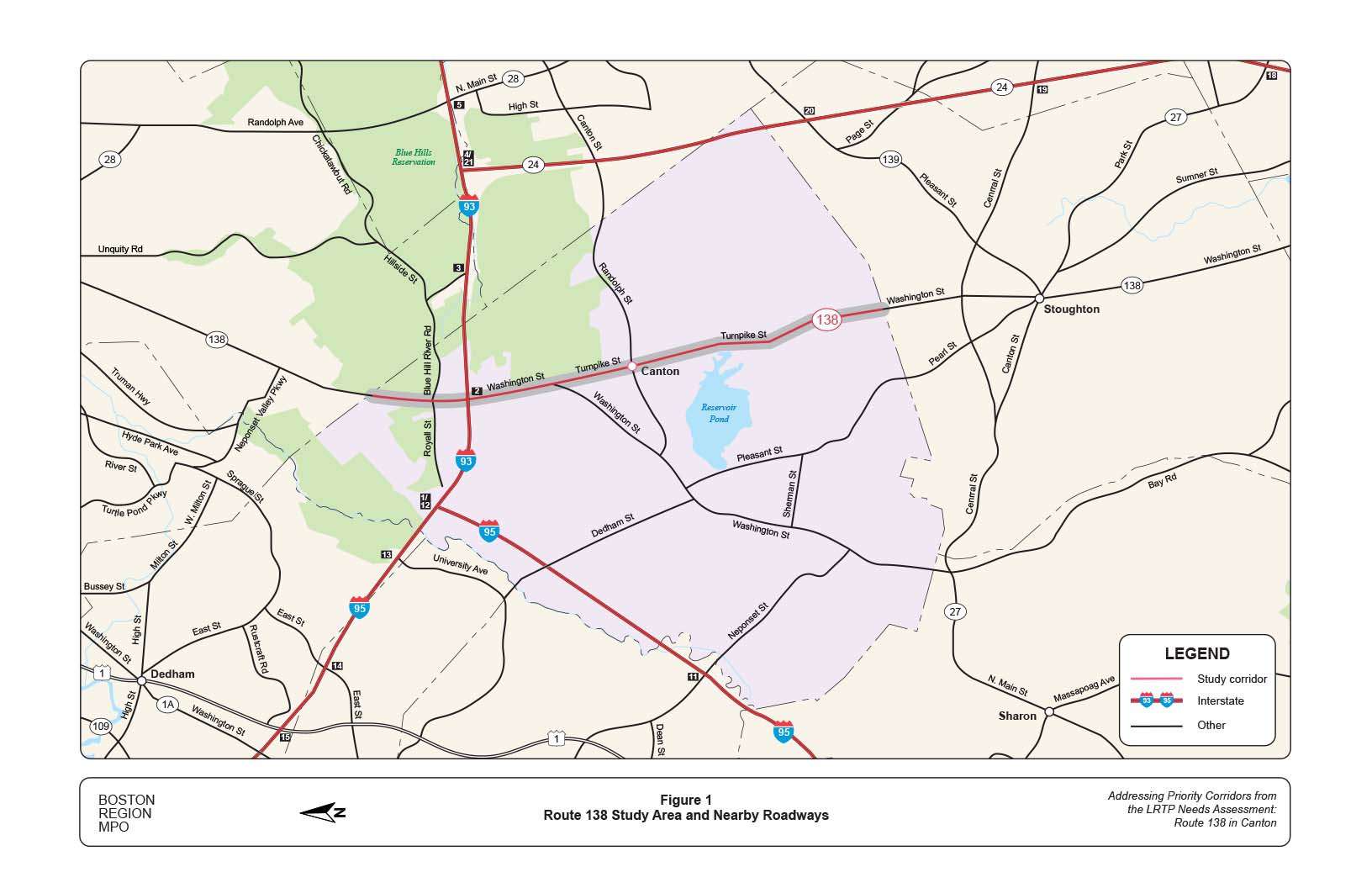
Figure 2.
Roadway Jurisdictions on Route 138 and Environs in Canton
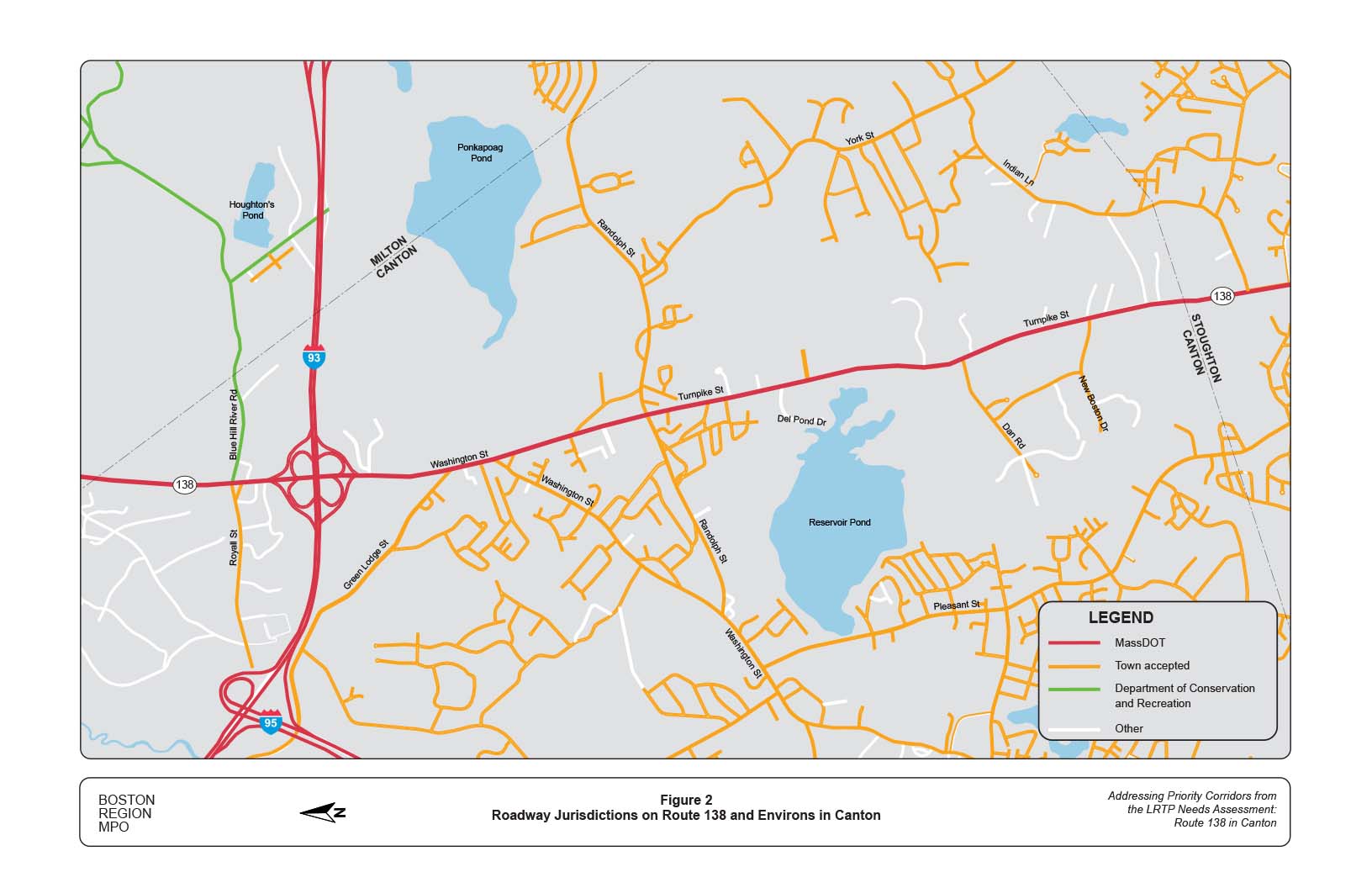
Figure 3.
Functional Classification of Roadways in the Route 138 Study Area
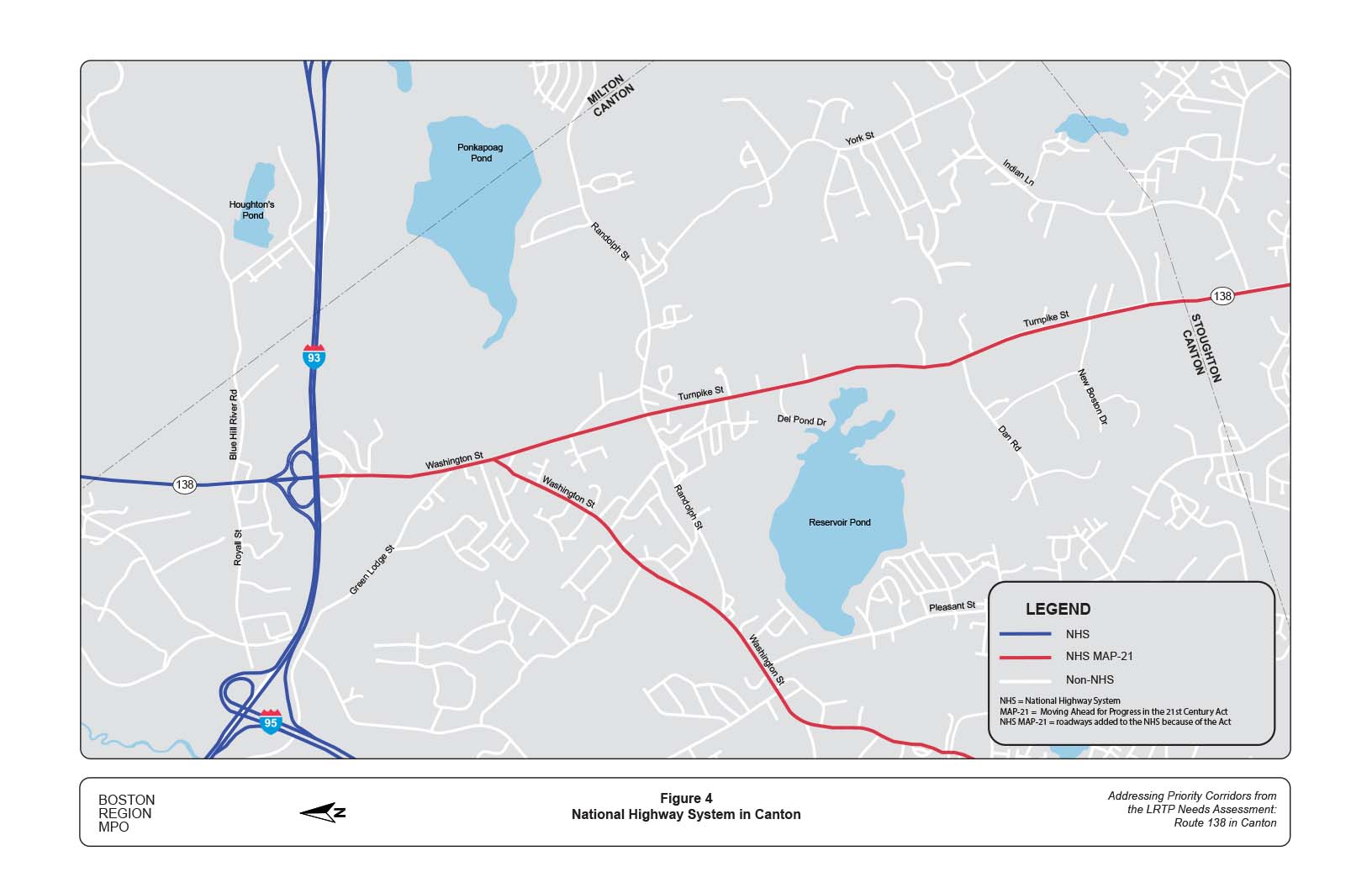
Figure 4.
National Highway System in Canton

Figure 5.
Width of Right-of-Way on Route 138 in Canton
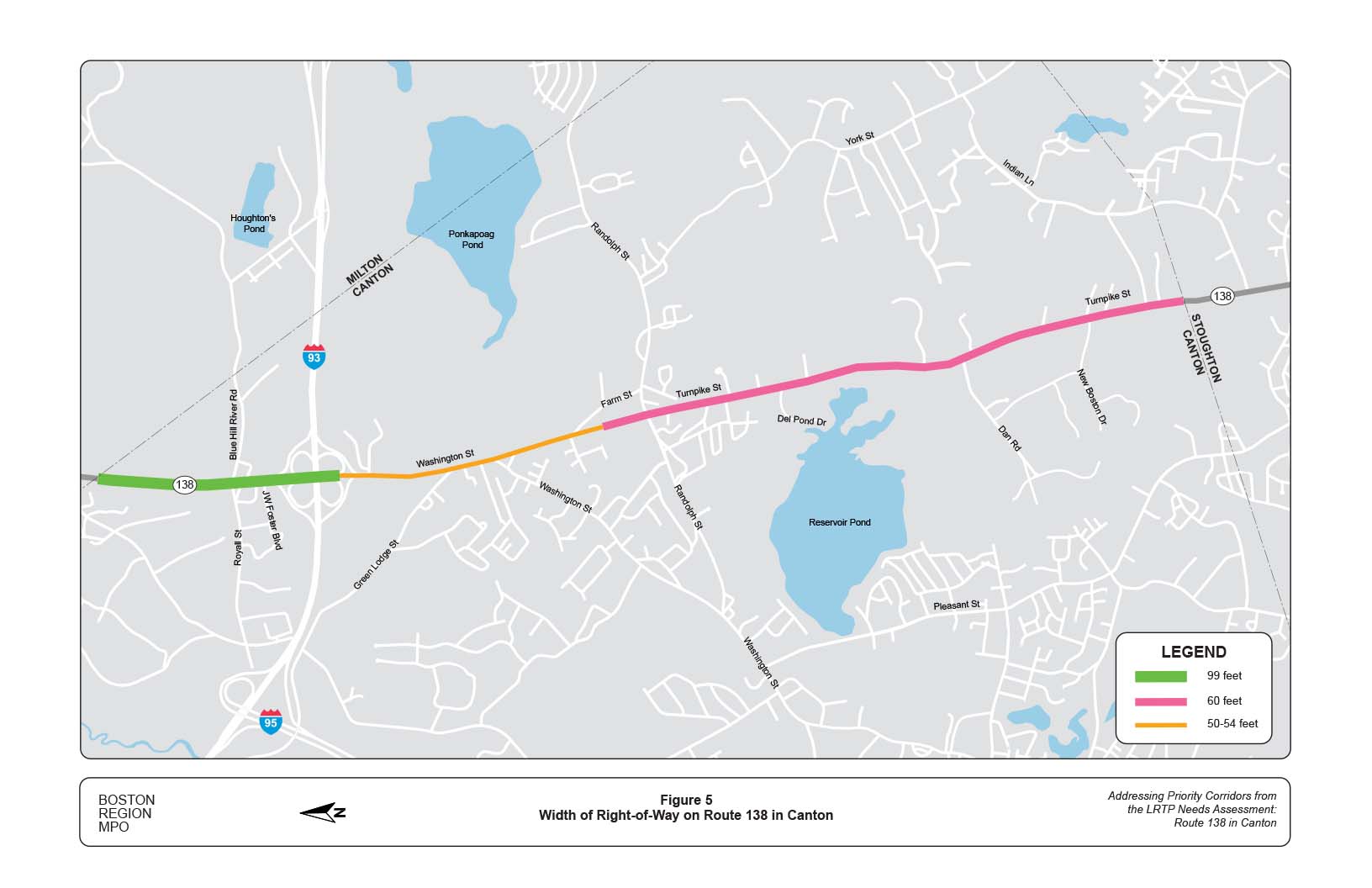
Figure 6.
Existing Roadway Shoulder Width on Route 138 in Canton
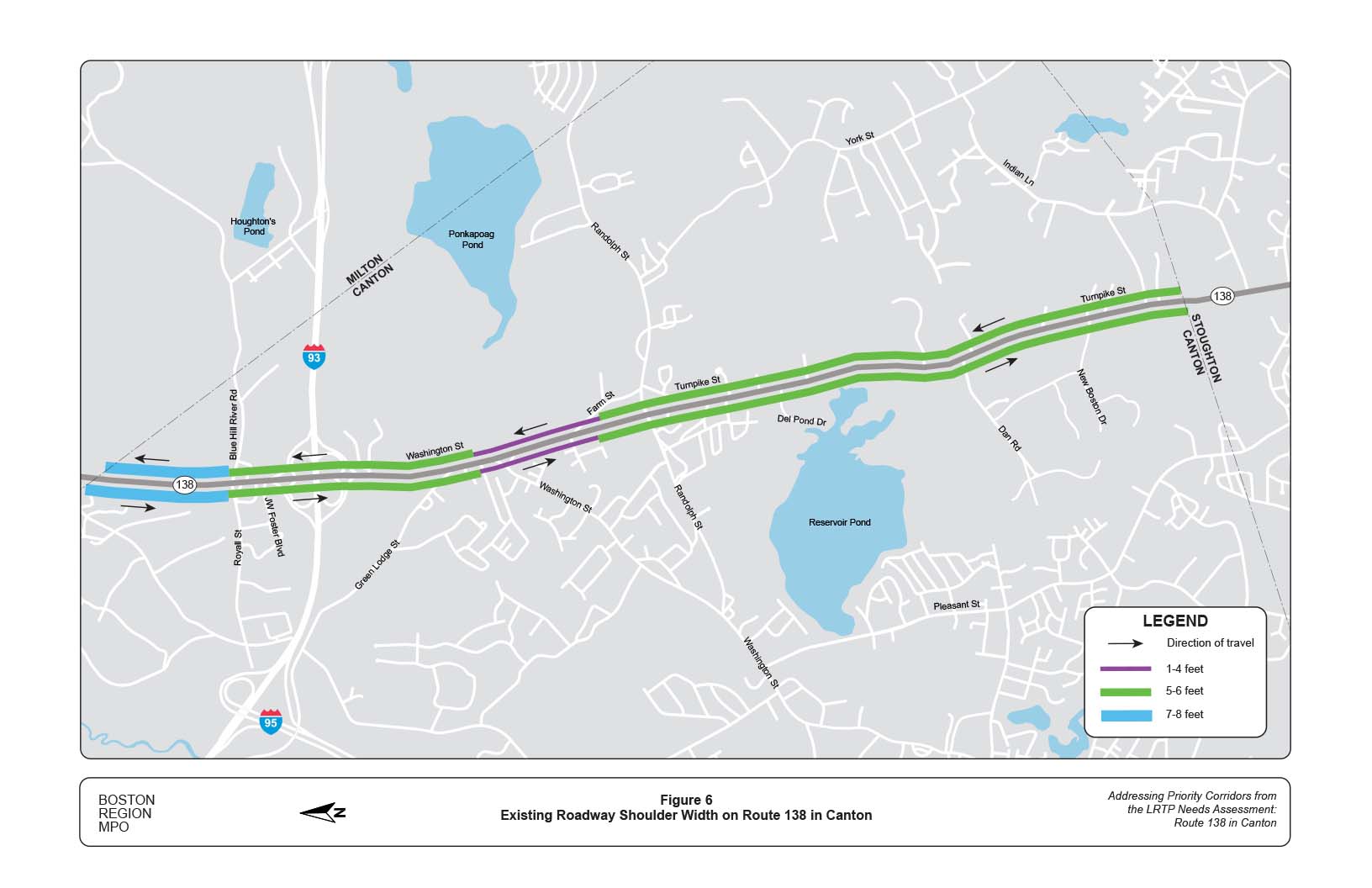
Figure 7.
Existing Sidewalks on Route 138 in Canton
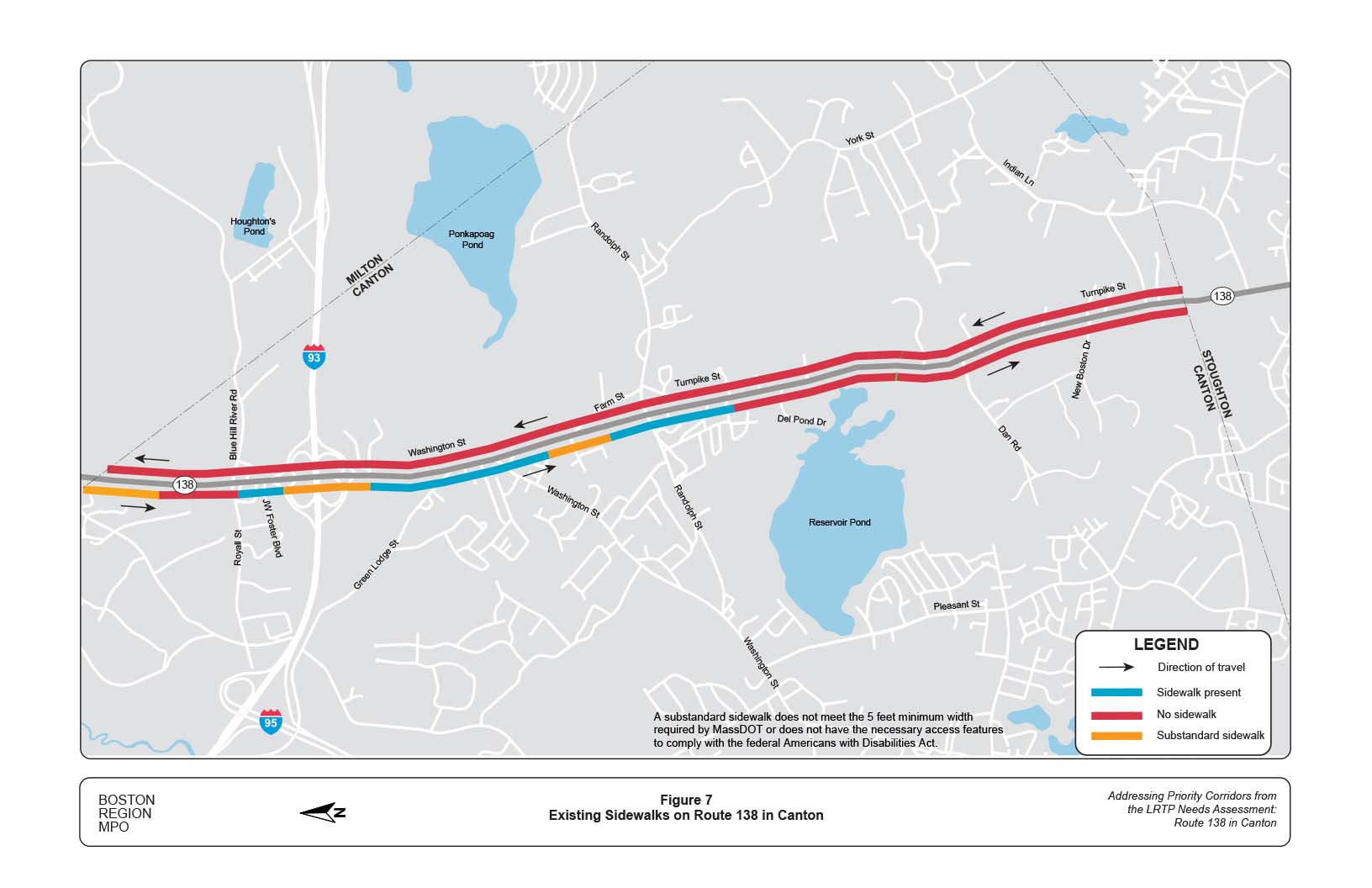
Figure 8.
Major Intersections on Route 138 in Canton
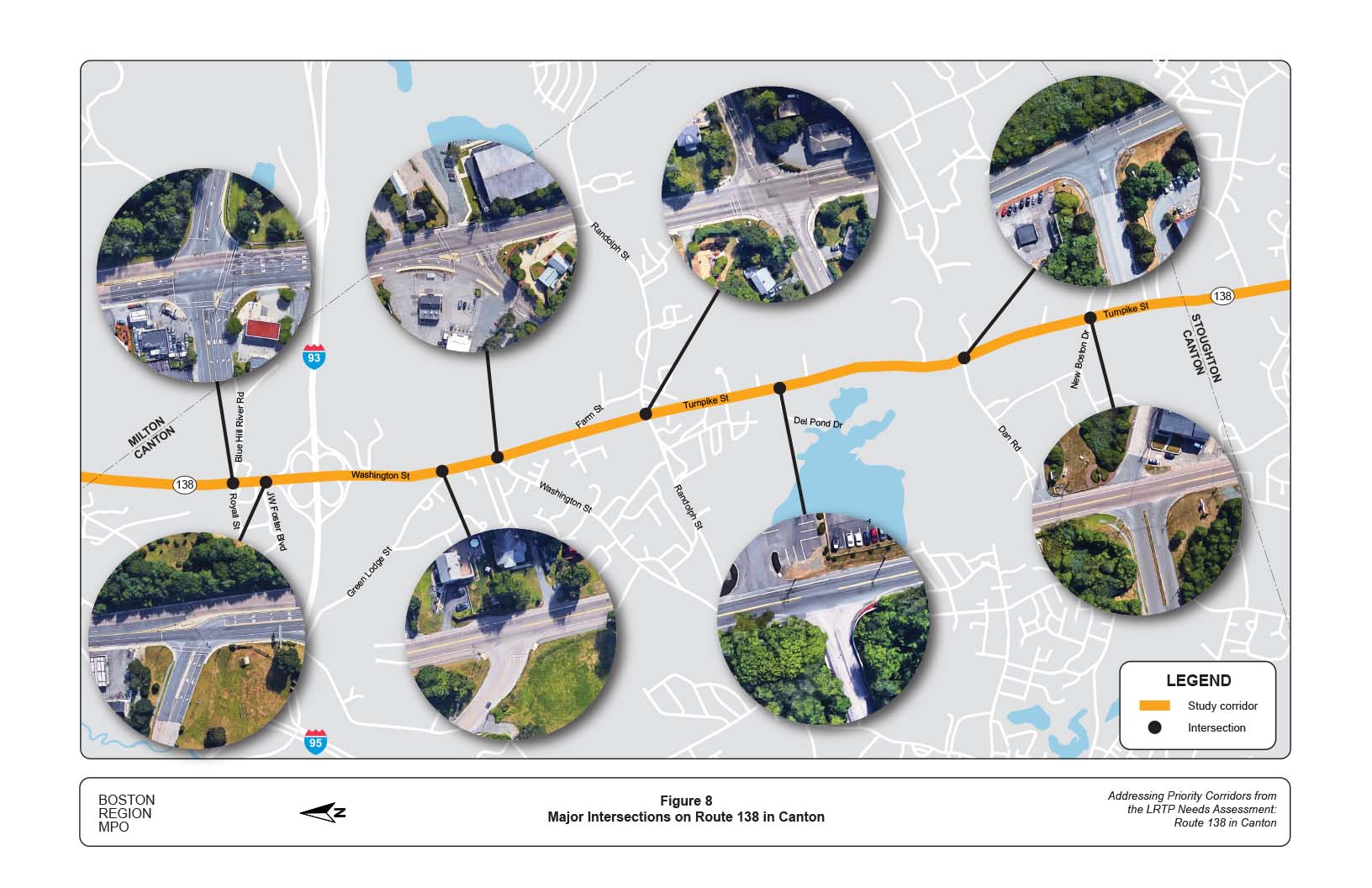
Figure 9.
Land Uses along Route 138 in Canton
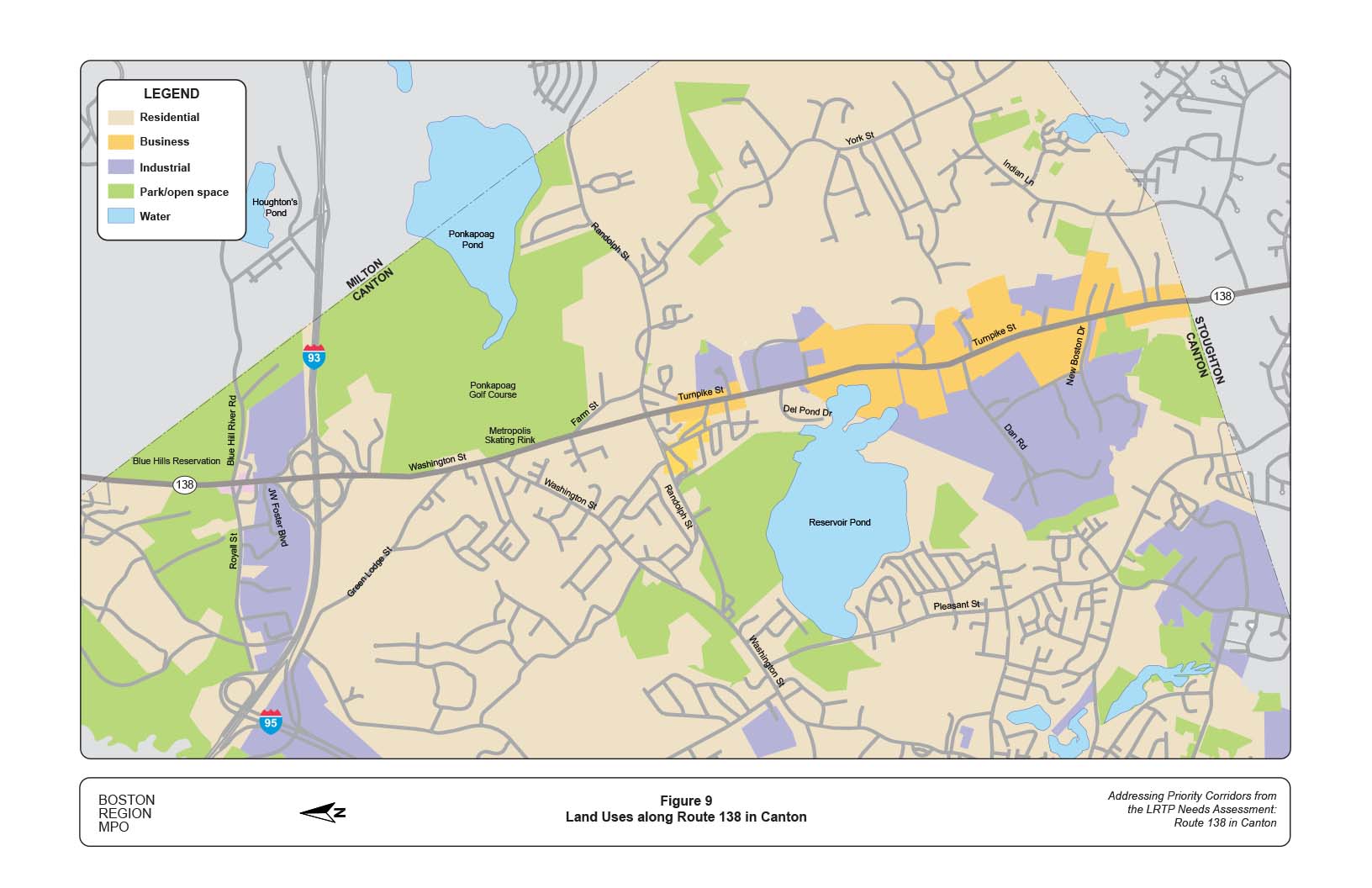
Figure 10.
Recent and Planned Developments along Route 138 in Canton
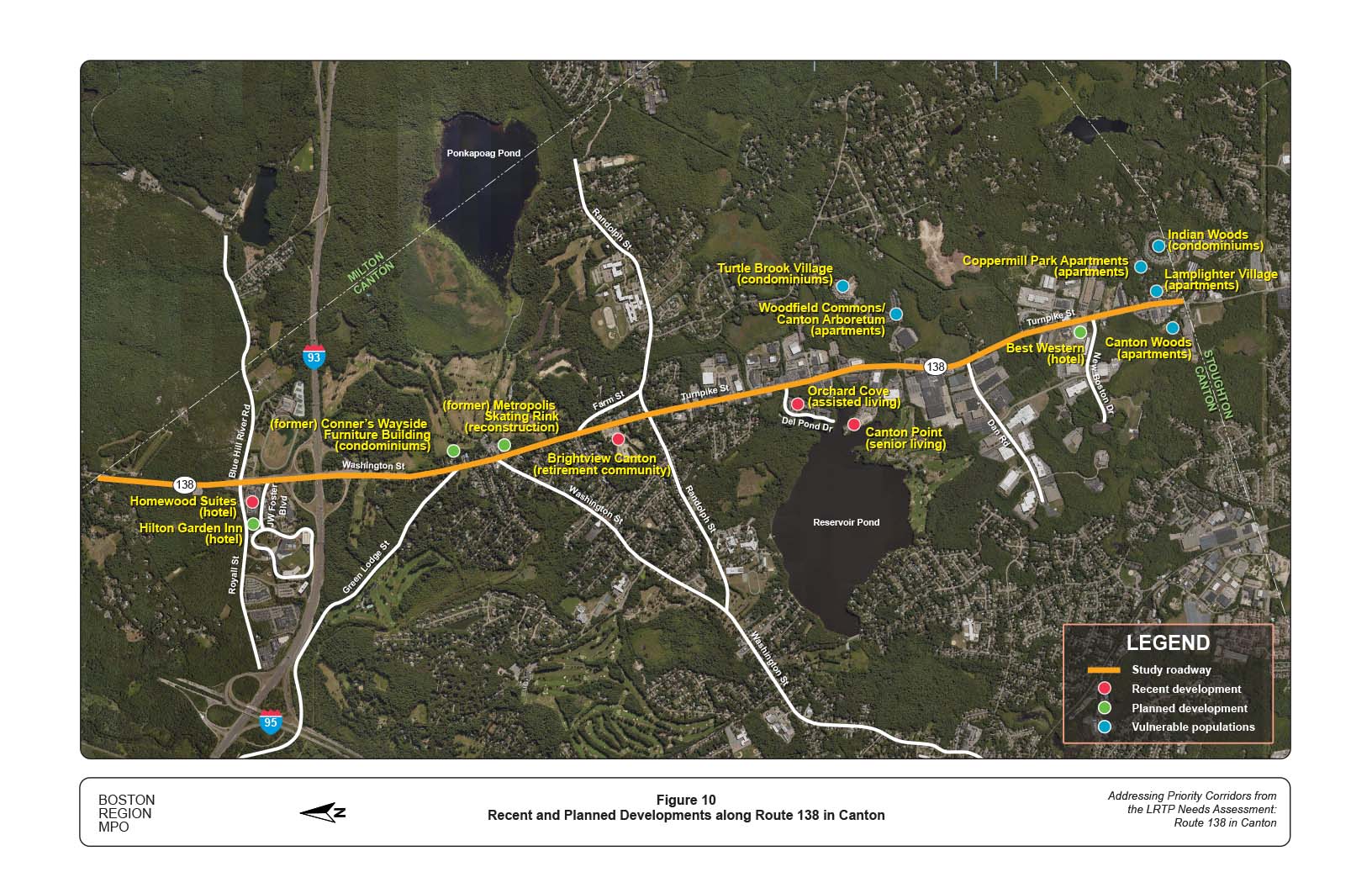
Figure 11.
Average Weekday Traffic Volumes on Route 138 in Canton

Figure 12.
Hourly Traffic-Volume Distribution on Route 138 in Canton
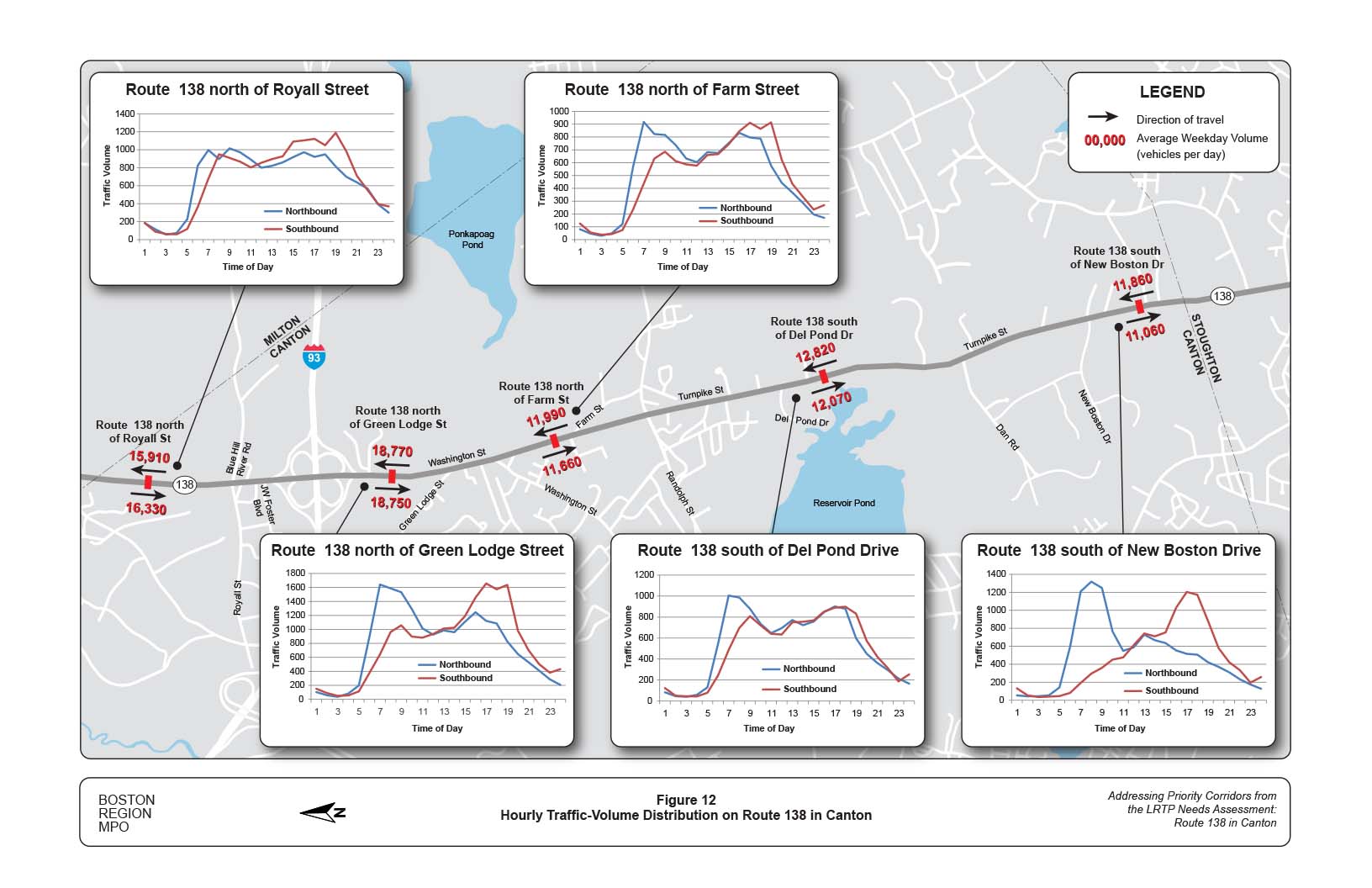
Figure 13.
Turning Movement Volumes on Route 138 in Canton
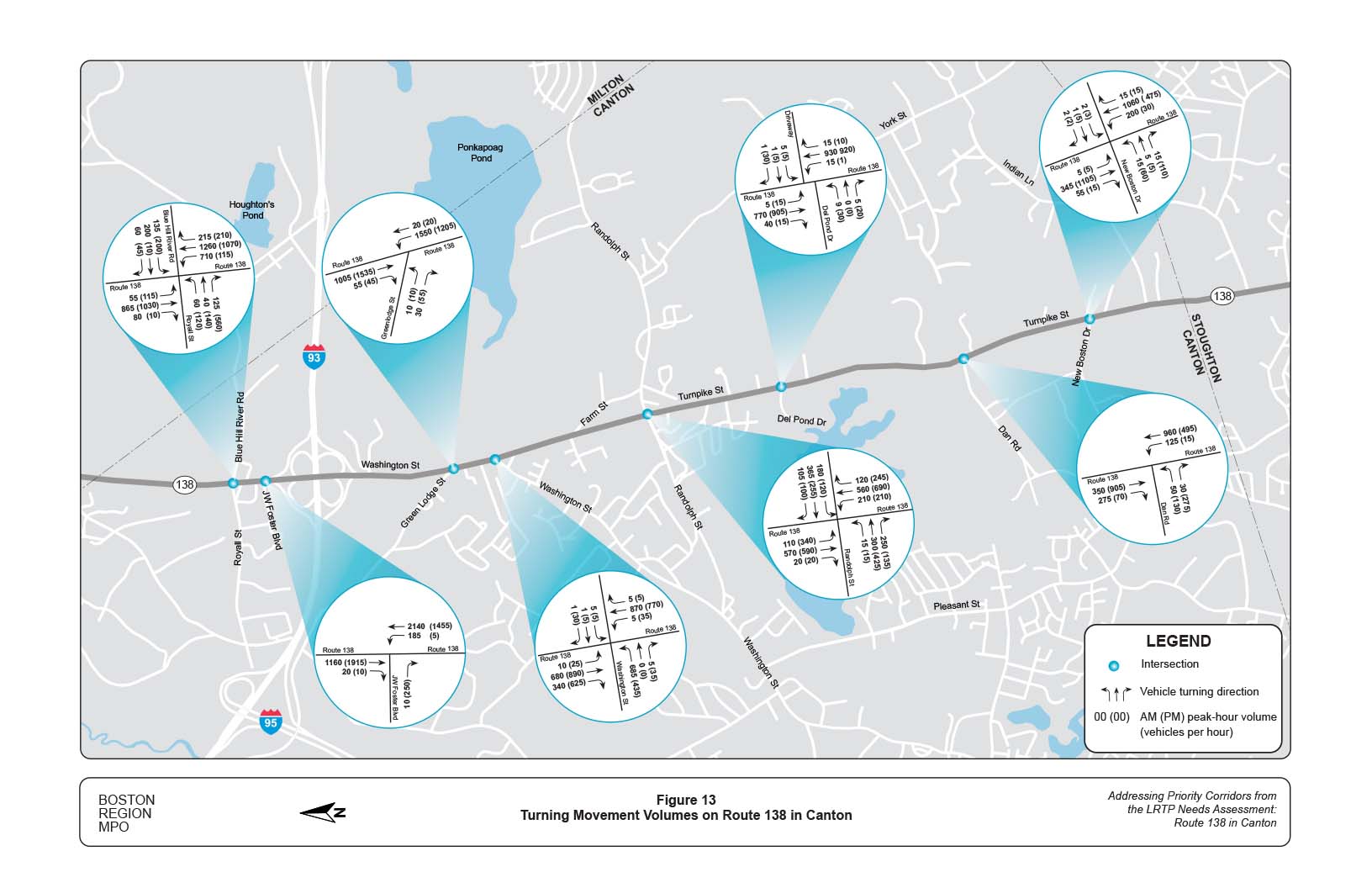
Figure 14.
Spot Speeds on Route 138 in Canton
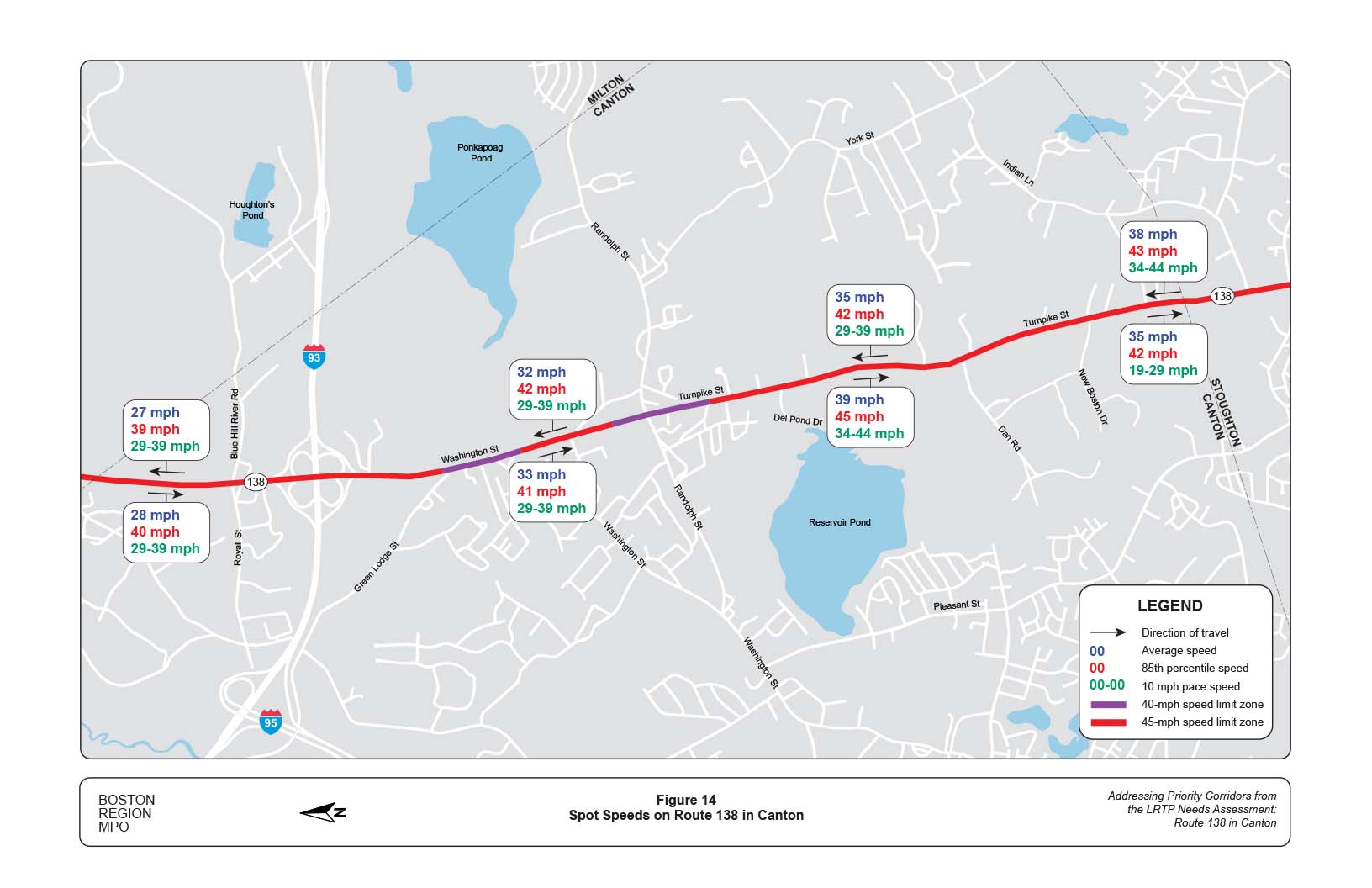
Figure 15.
Regional Transit Service in Canton
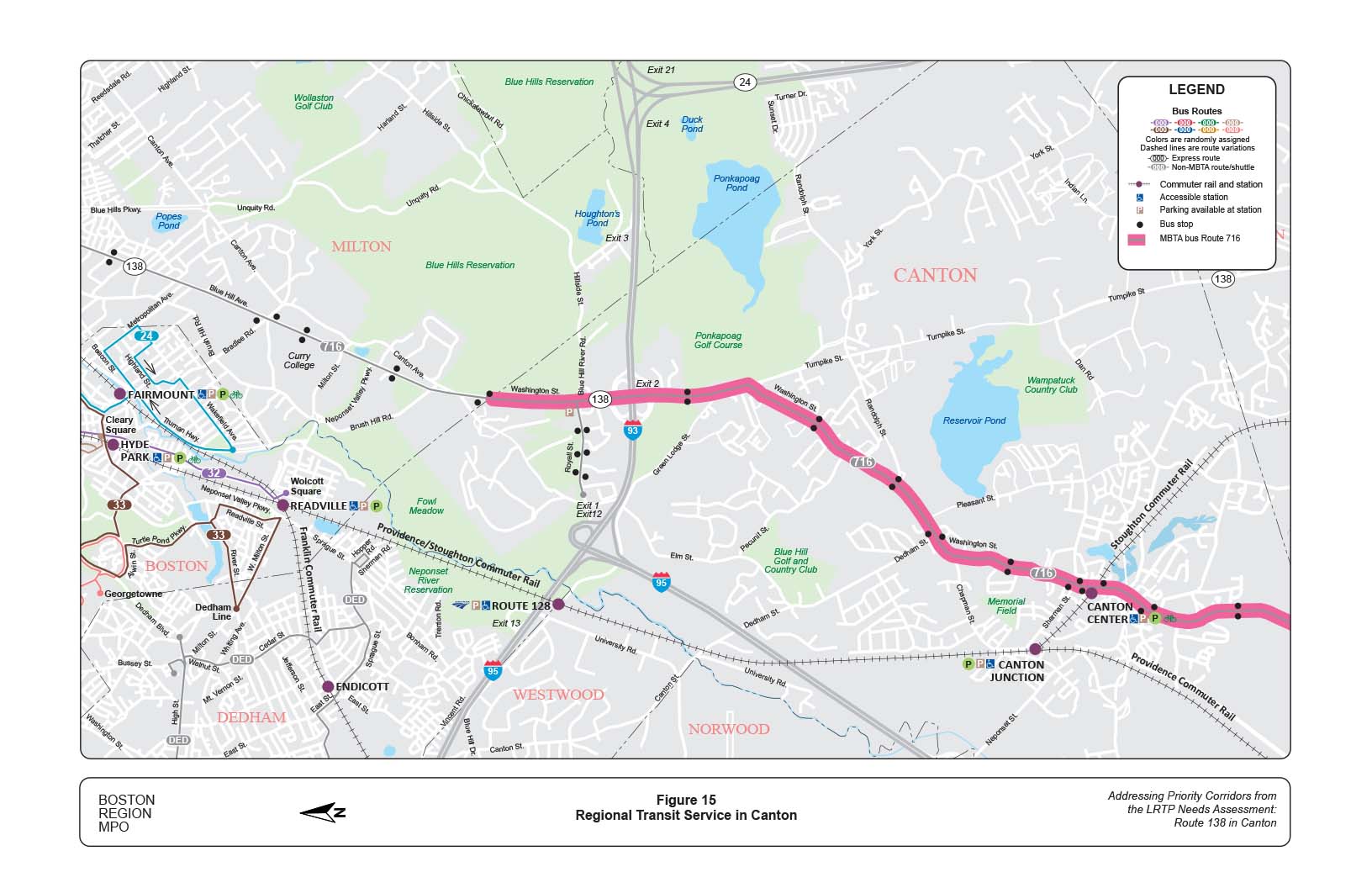
Figure 16.
Crashes on Route 138 in Canton (2010-14)
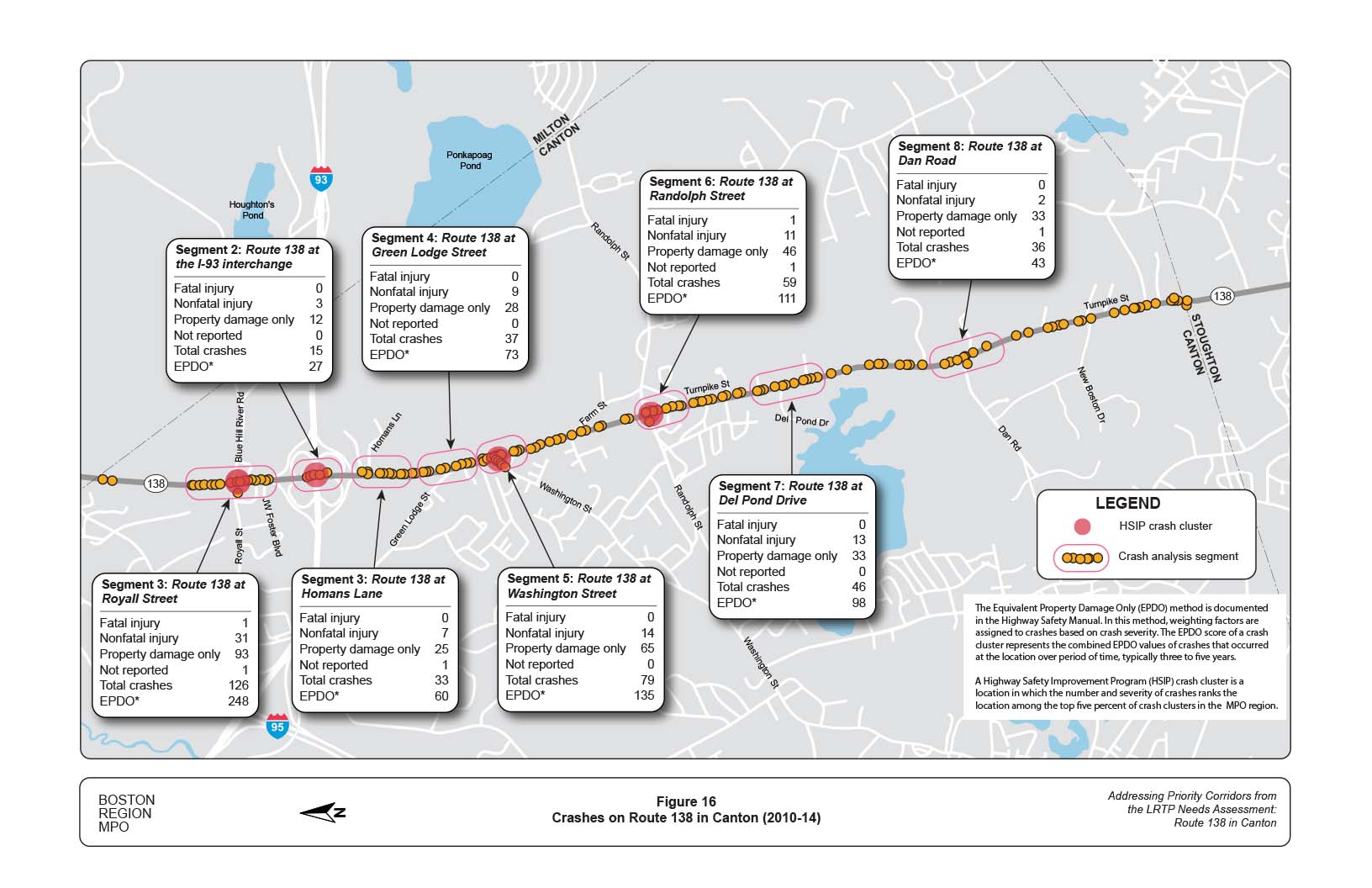
Figure 17.
Collision Diagram for Segment 1: Route 138 at Royall Street/Blue Hill River Road
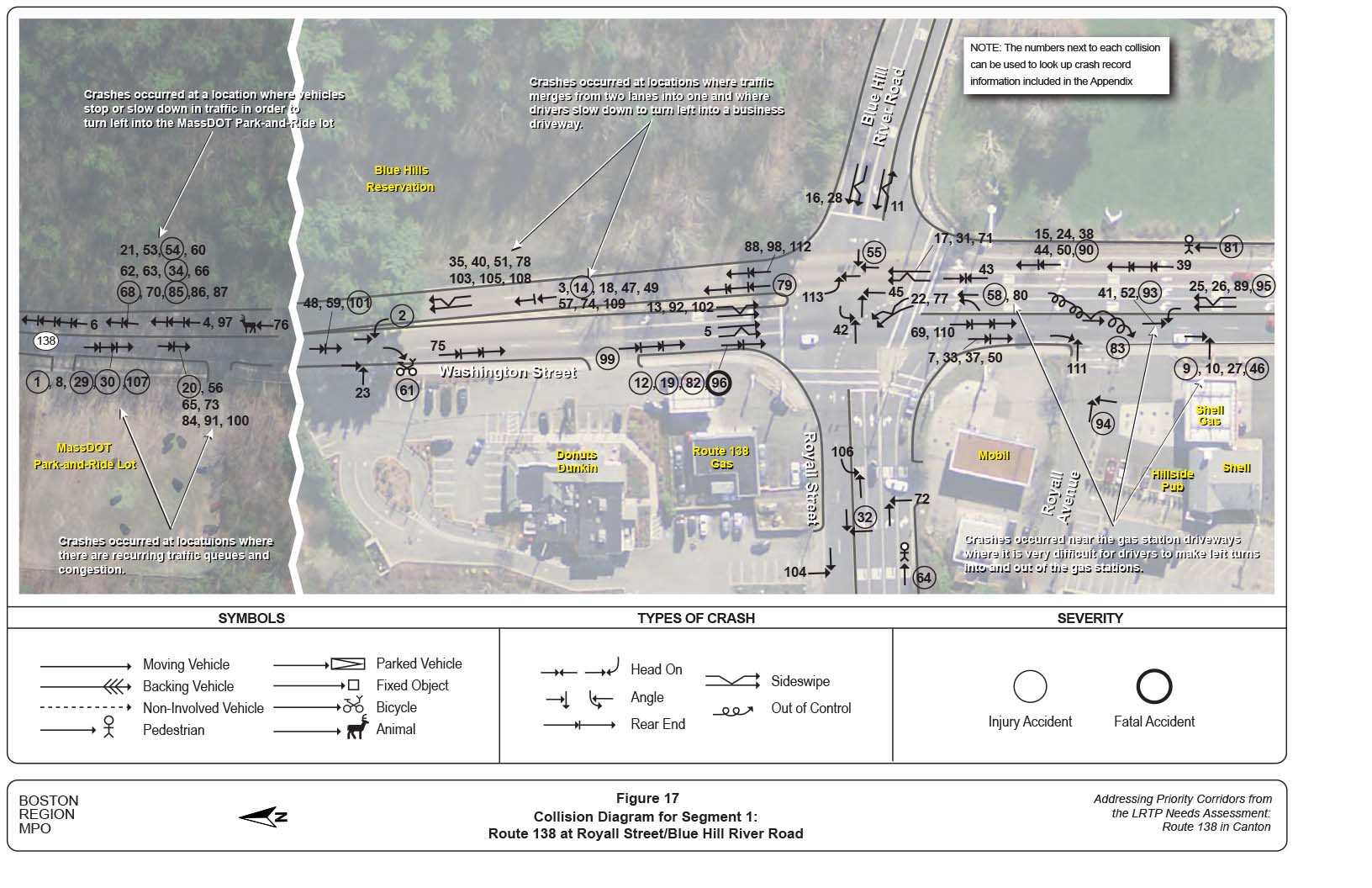
Figure 17 (cont.).
Collision Diagram for Segment 1: Route 138 at J.W. Foster Boulevard
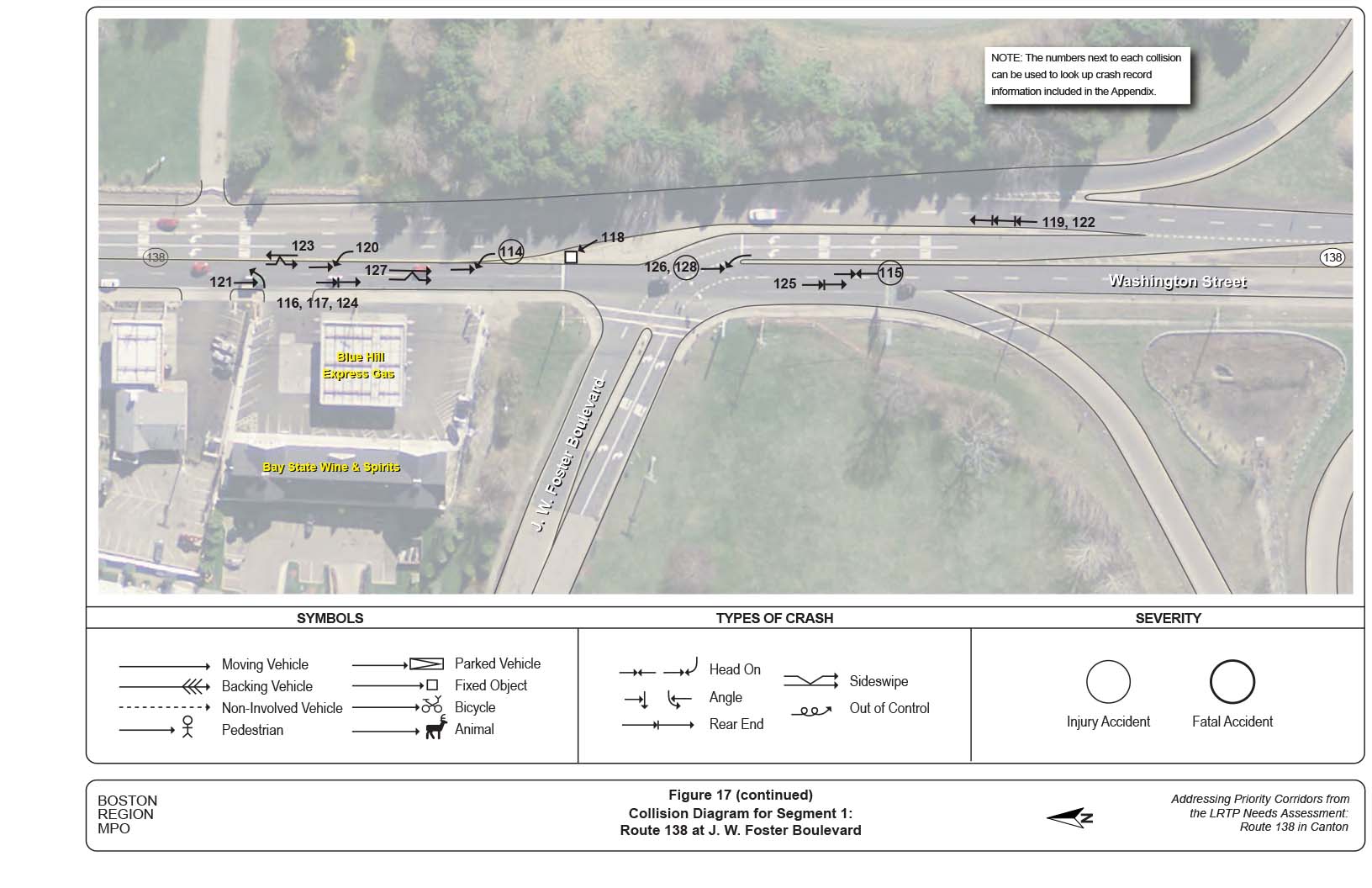
Figure 18.
Collision Diagram for Segment 2: Junction of Route 138 and Interstate 93
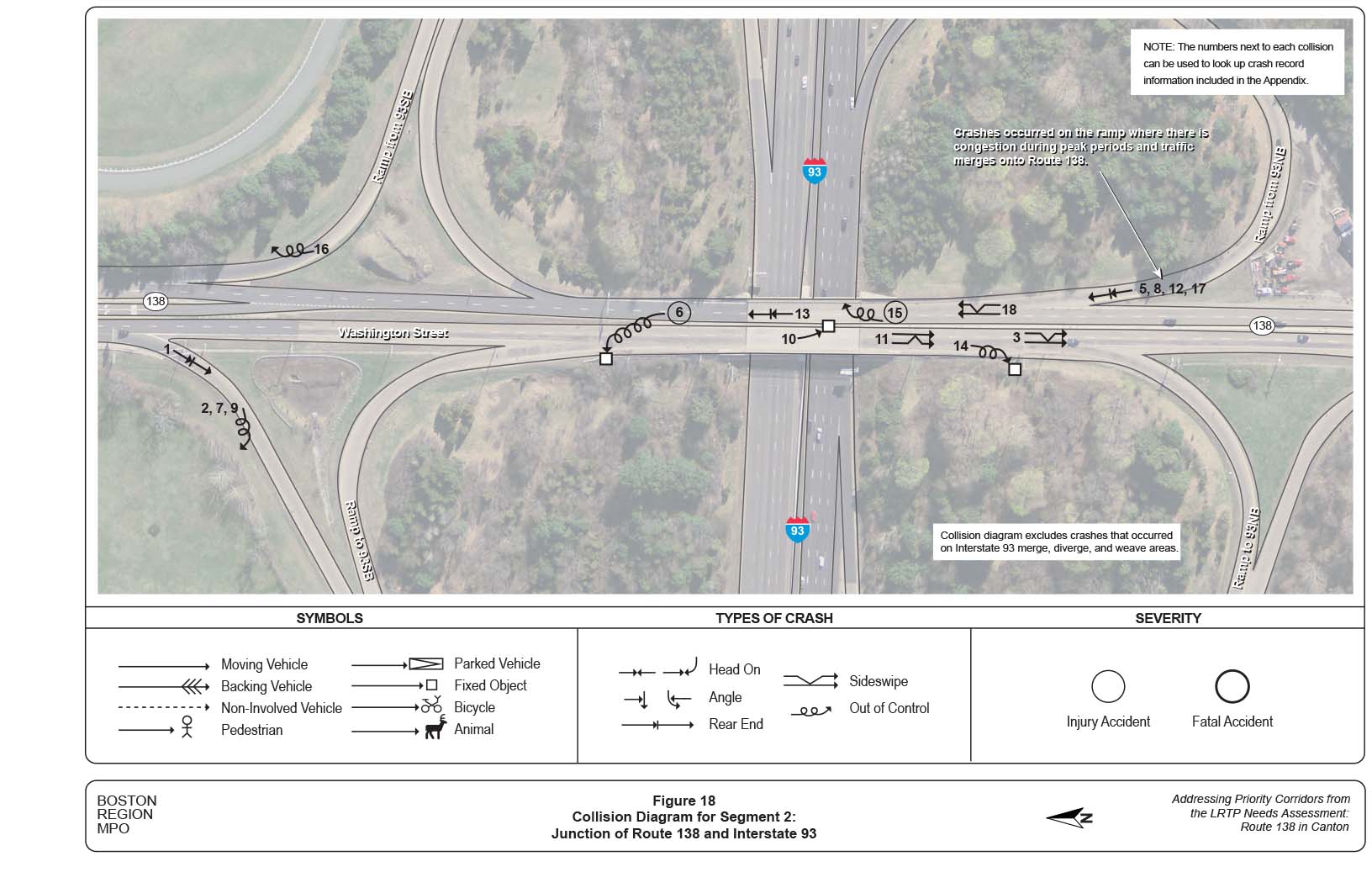
Figure 18 (cont.).
Collision Diagram for Segment 2: Route 138 at the Interstate 93 Ramps
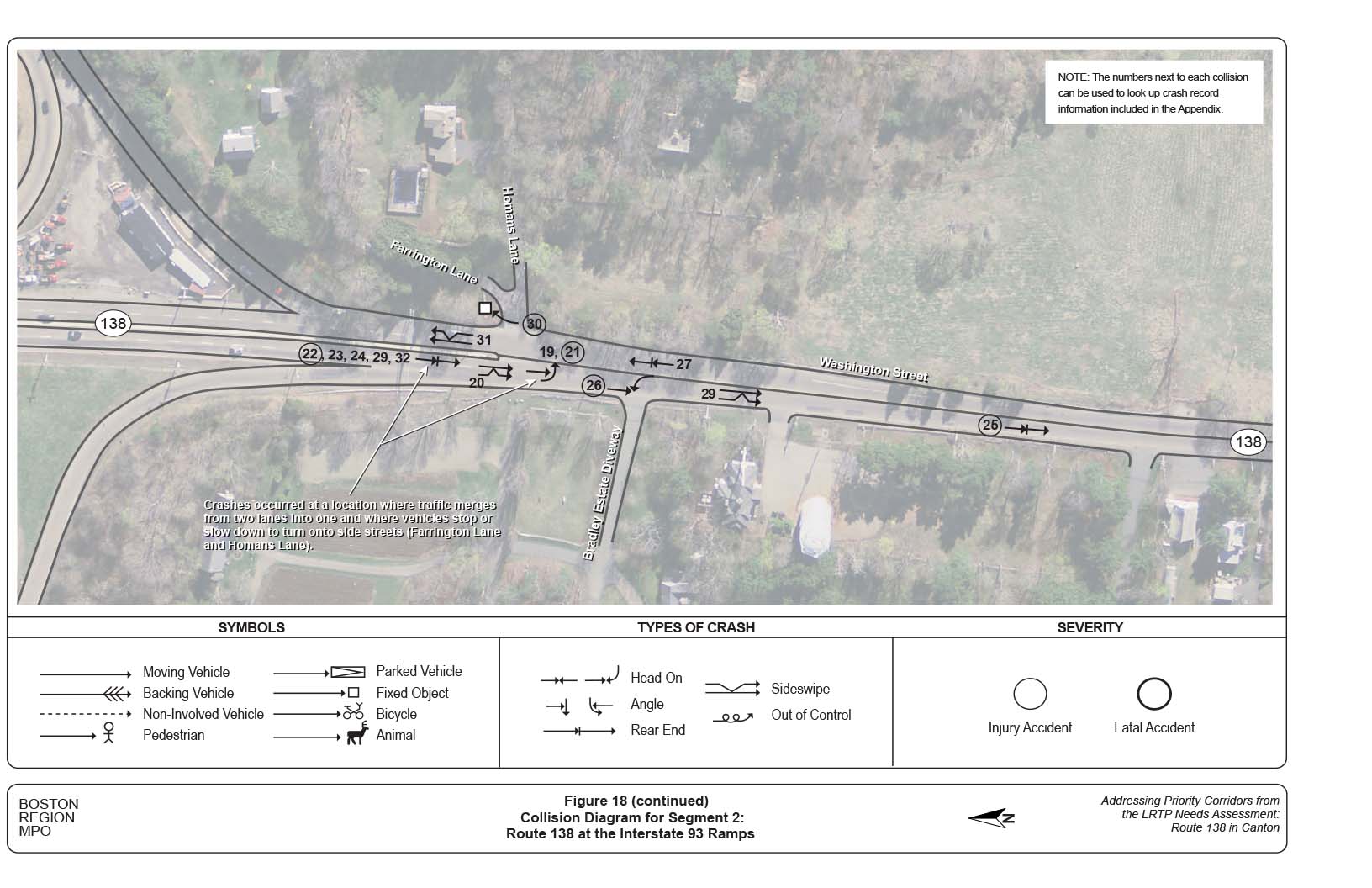
Figure 19.
Collision Diagram for Segment 3: Route 138 at Green Lodge Street
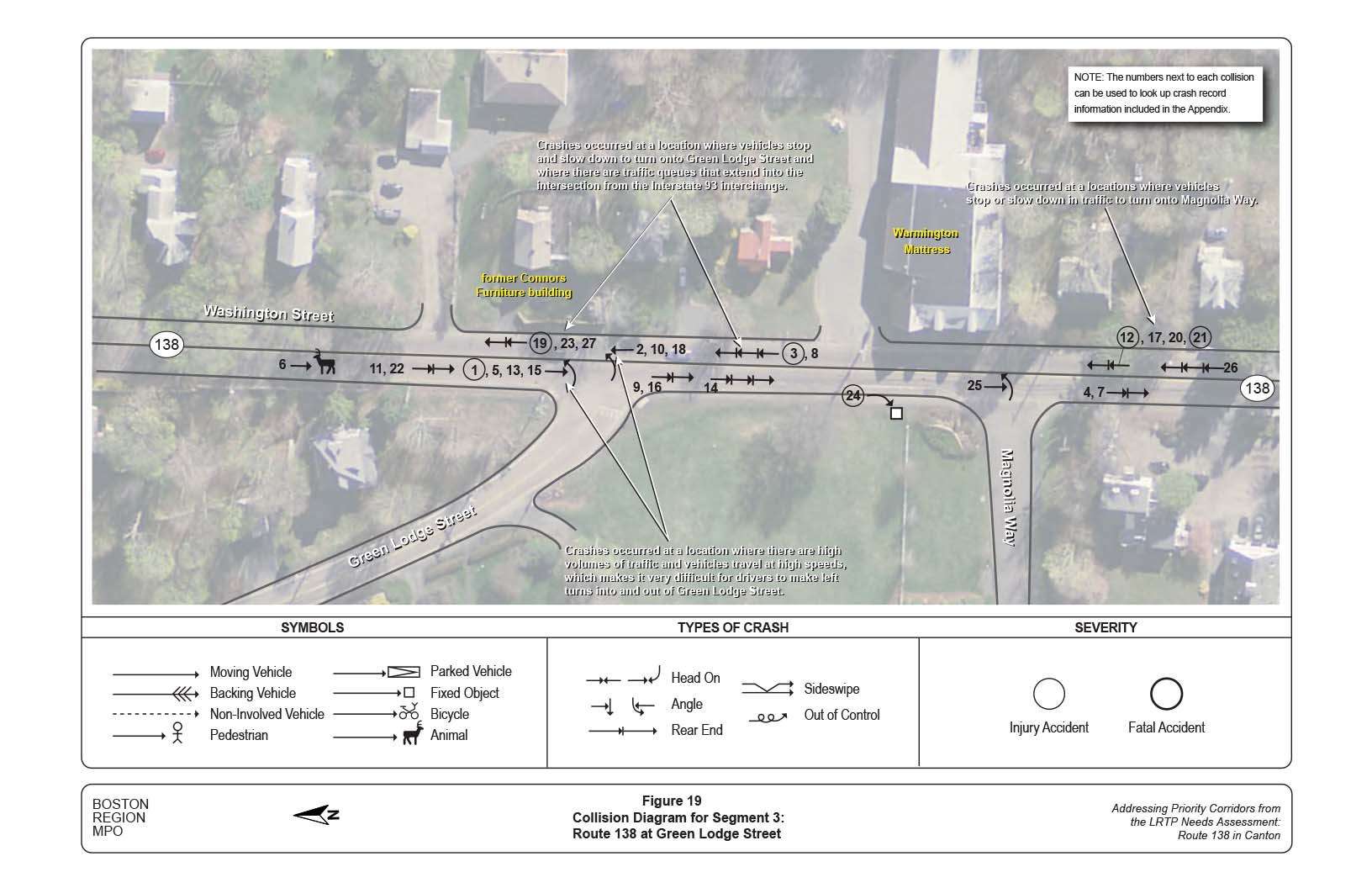
Figure 20.
Collision Diagram for Segment 4: Route 138 at Washington Street
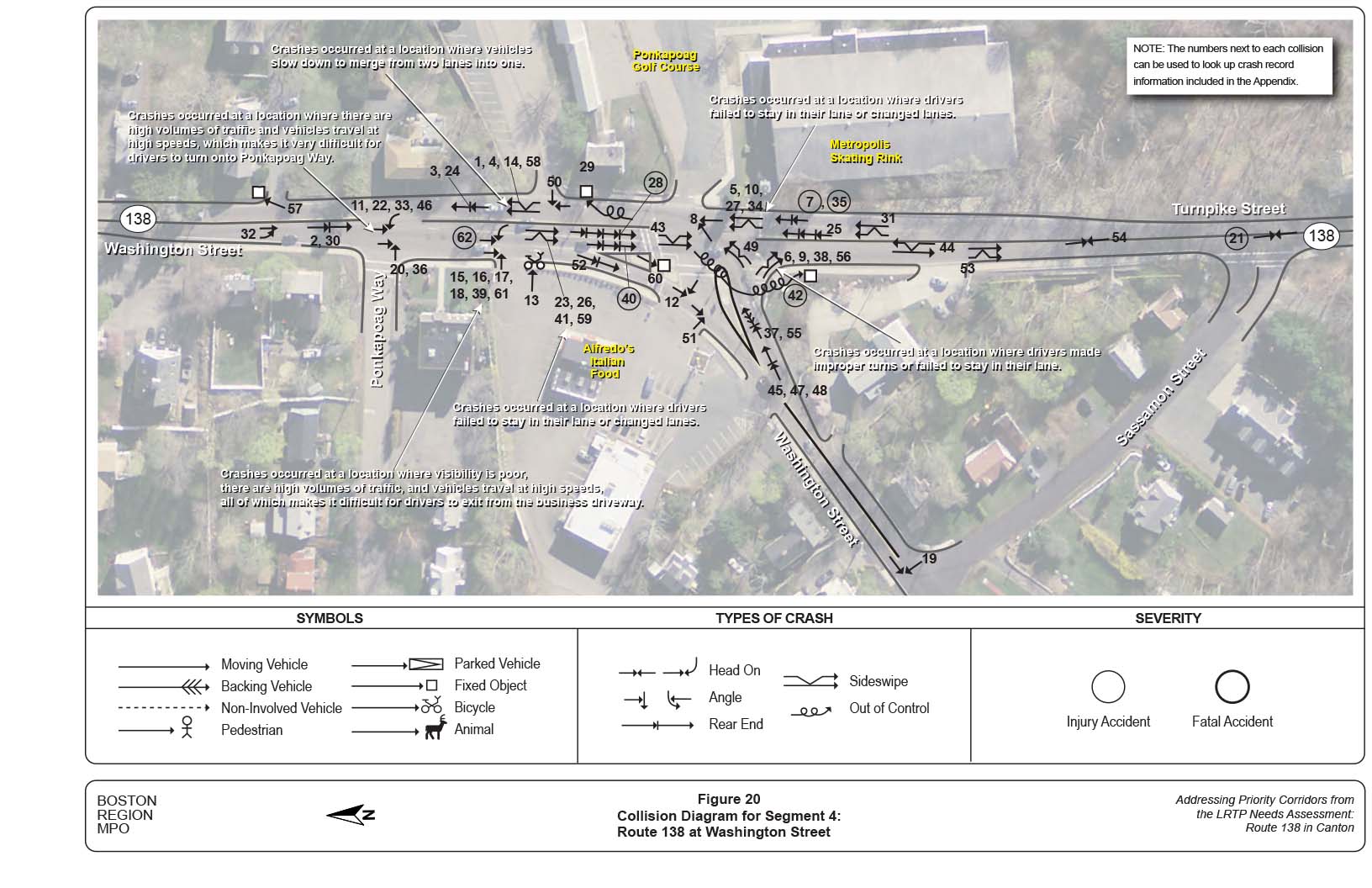
Figure 21.
Collision Diagram for Segment 5: Route 138 at Randolph Street
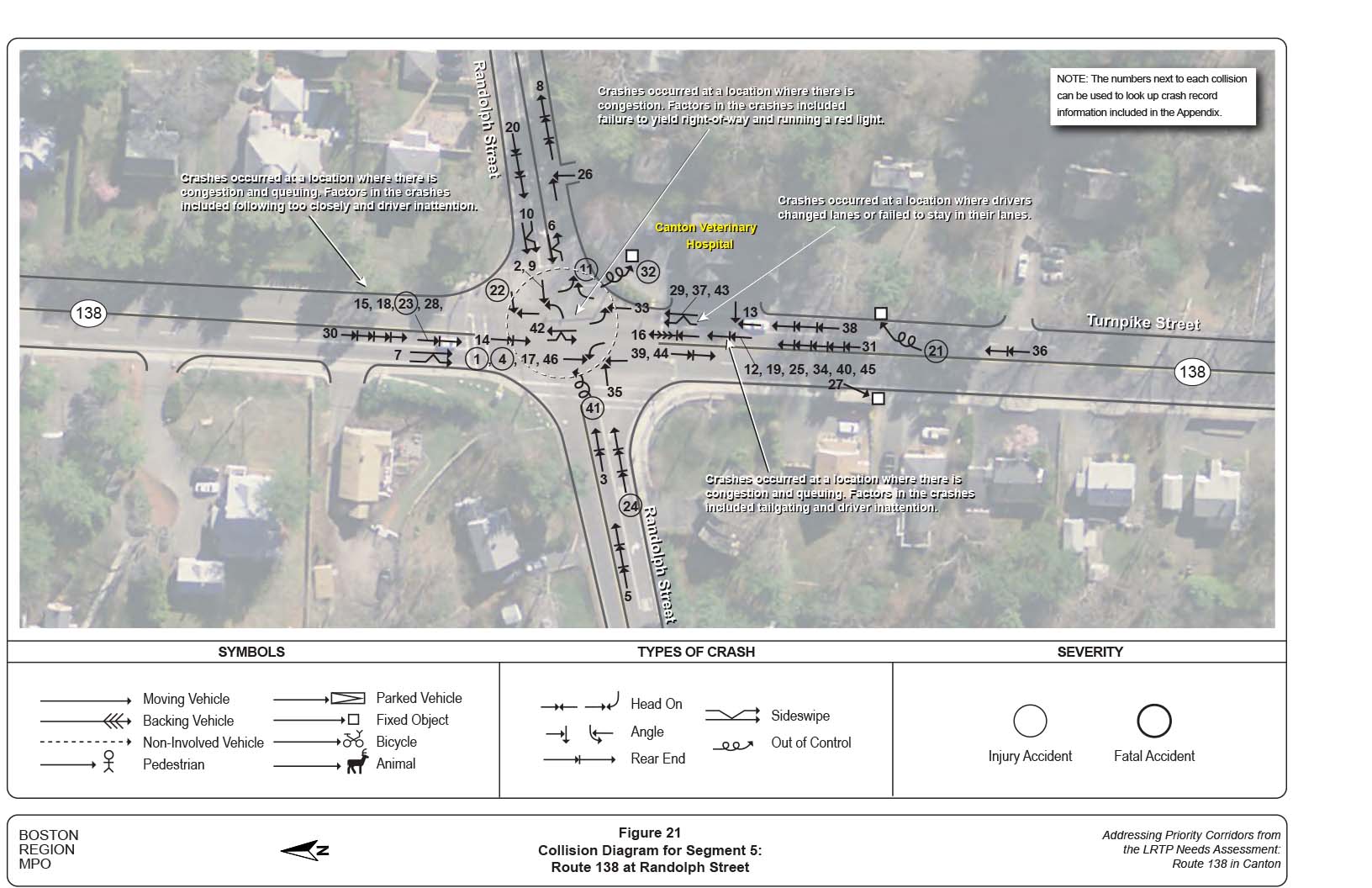
Figure 22.
Collision Diagram for Segment 6: Route 138 at Del Pond Drive
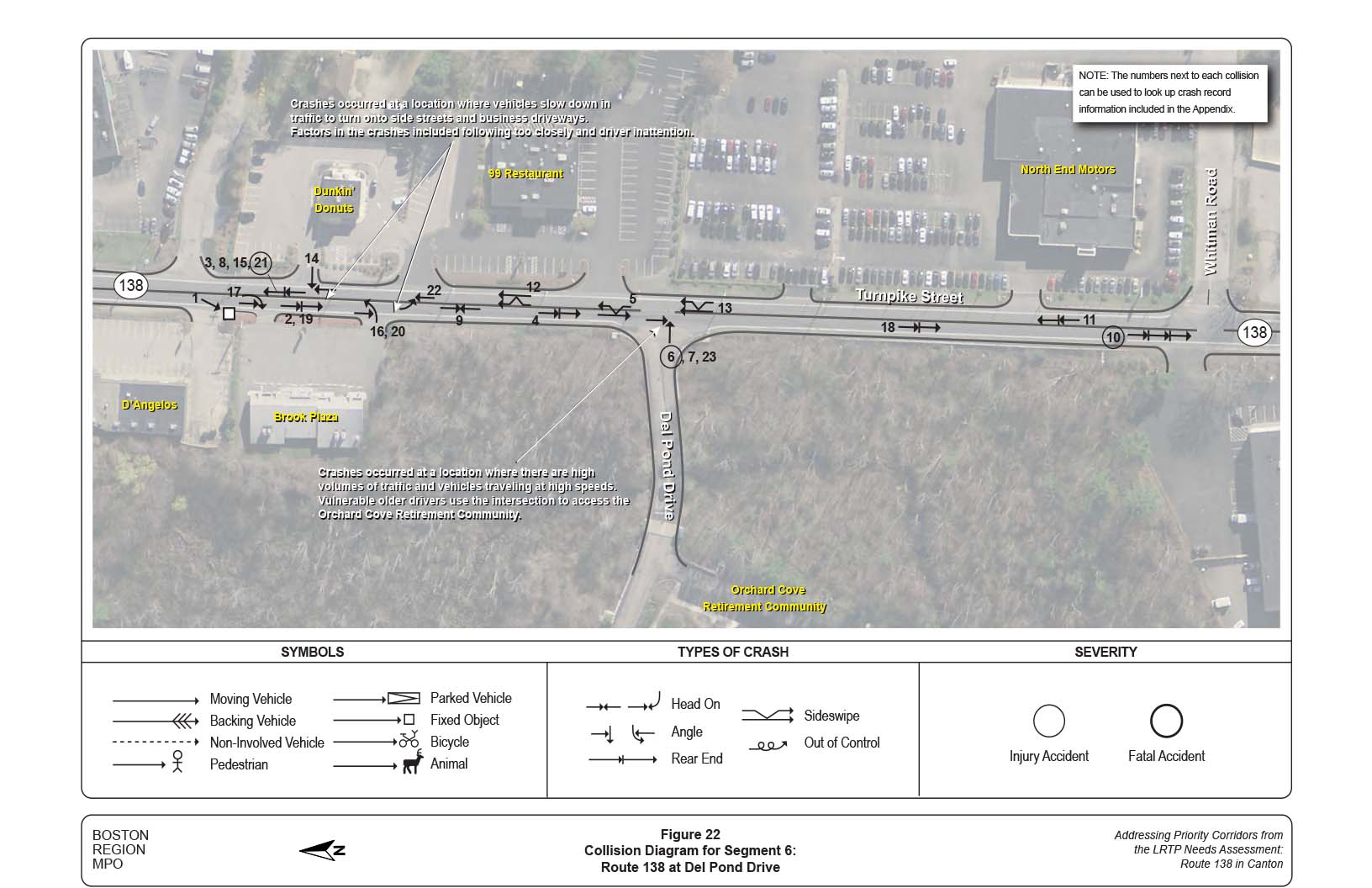
Figure 23.
Collision Diagram for Segment 7: Route 138 at Dan Road
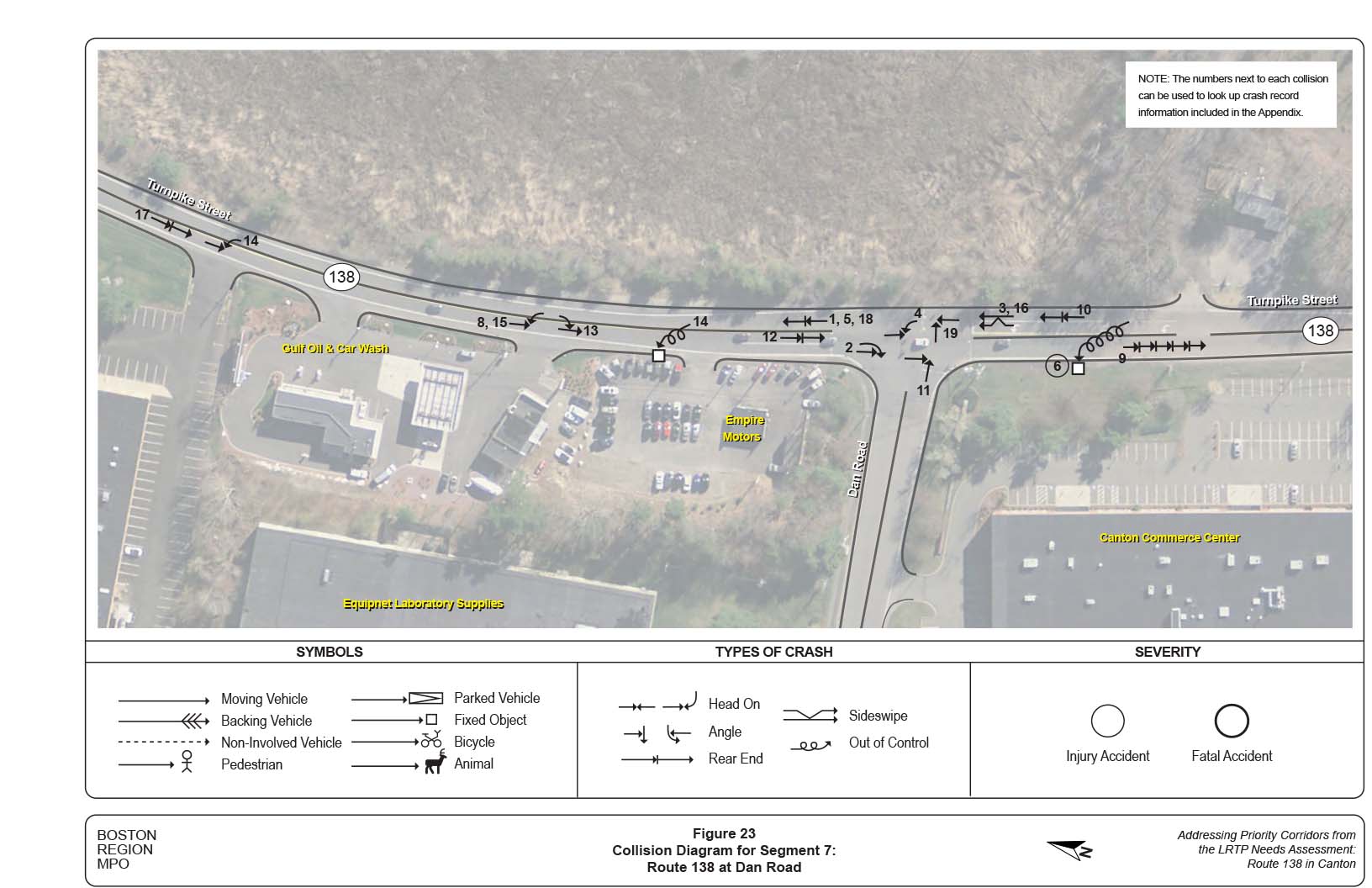
Figure 24.
Existing Level of Service on Route 138 in Canton: Weekday AM Peak Period

Figure 25.
Existing Level of Service on Route 138 in Canton: Weekday PM Peak Period
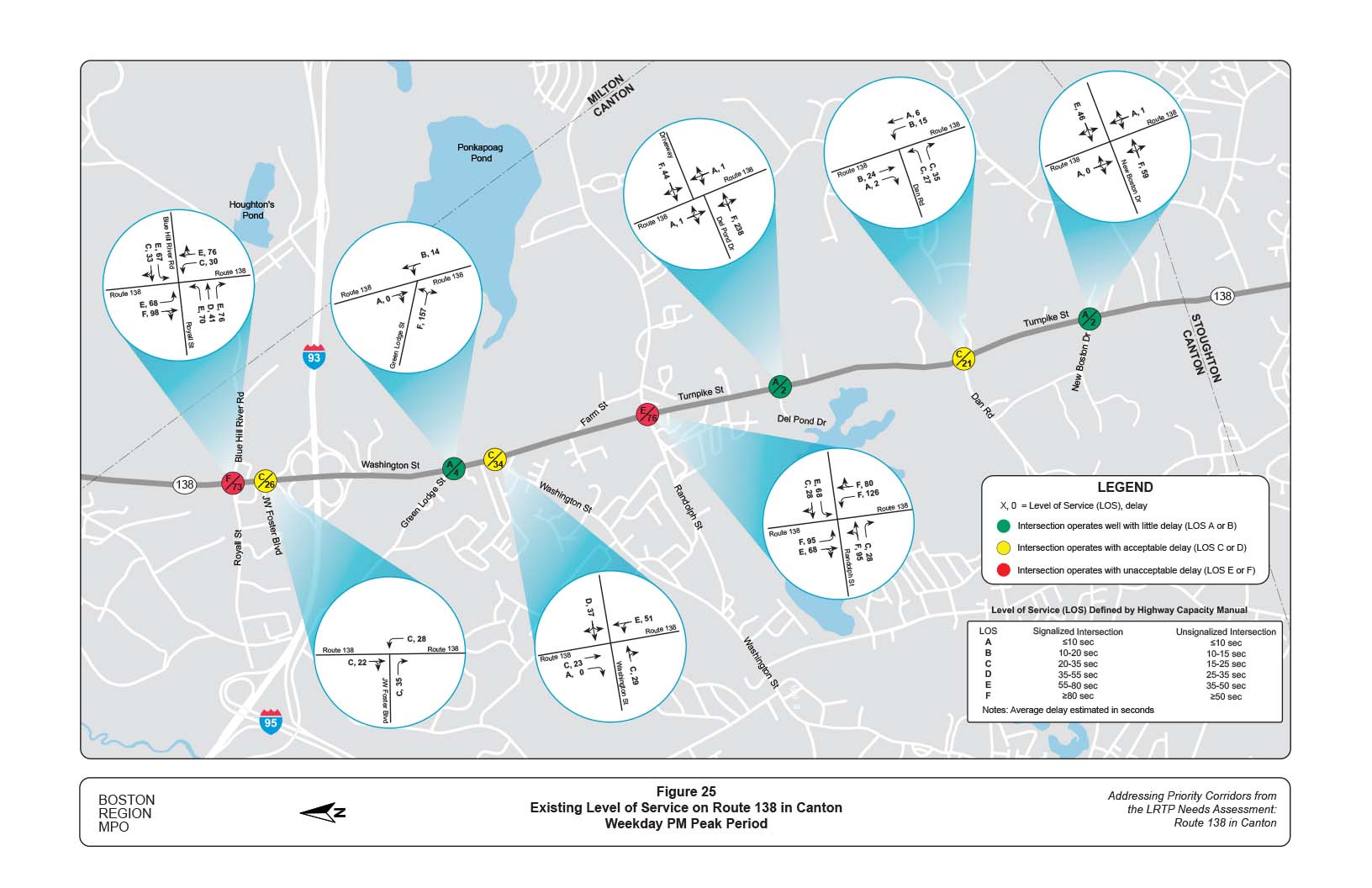
Figure 26.
Survey Questions and Number of Respondents
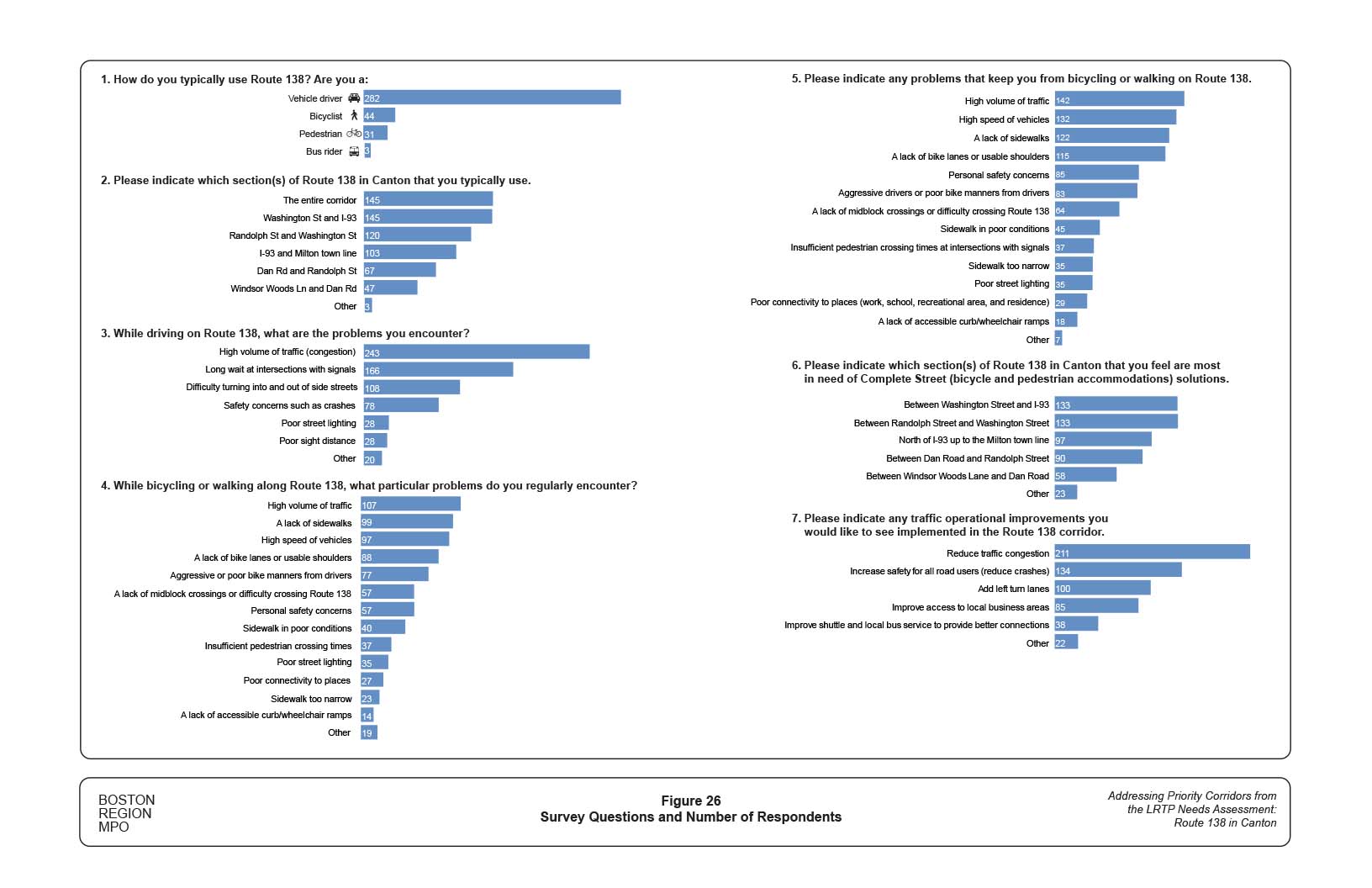
Figure 27.
Priority Assigned to Route 138 Segments in Need of Complete Street Solutions
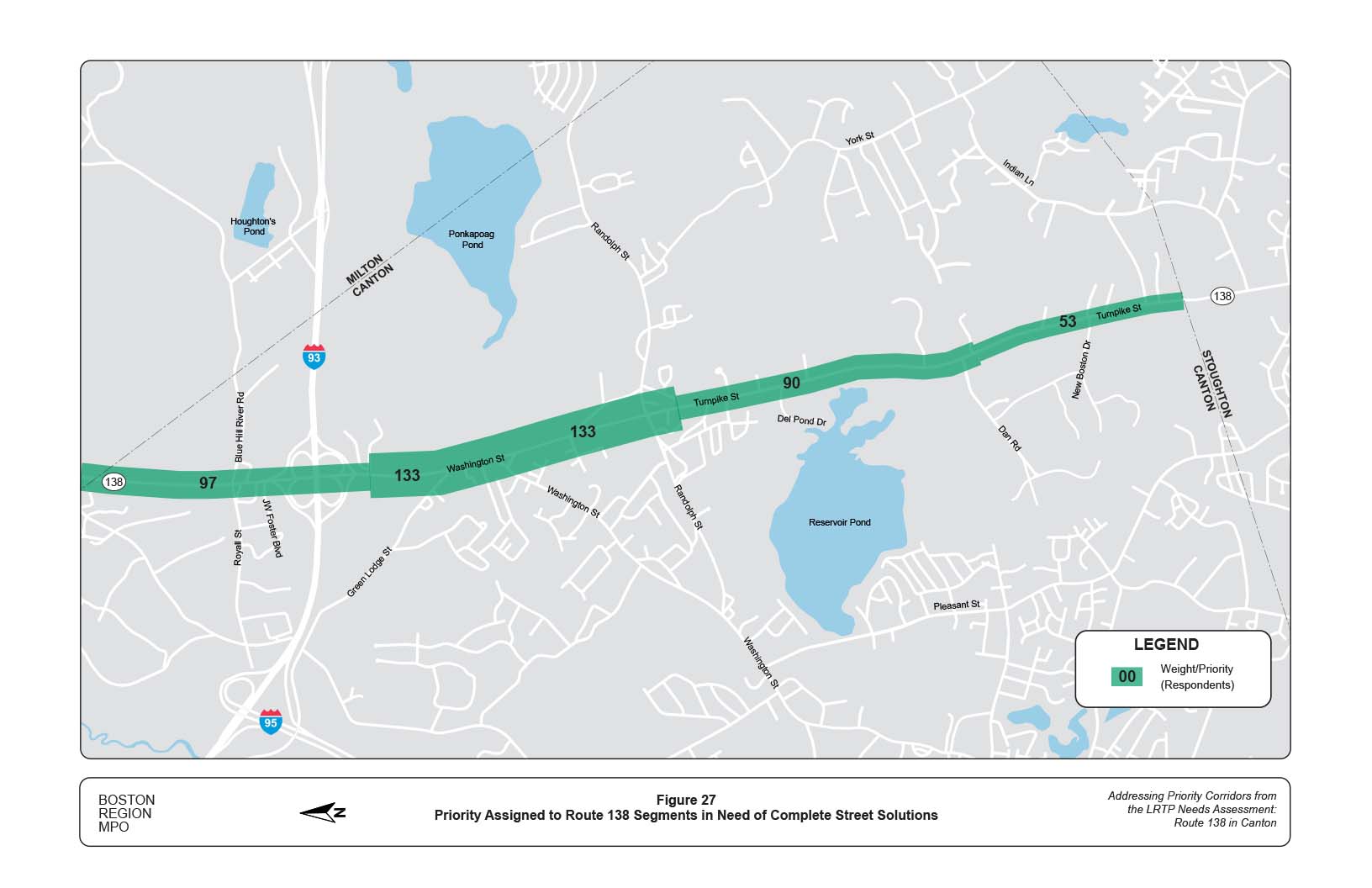
Figure 28.
Existing Conditions: Route 138 in the Blue Hills Ski Area
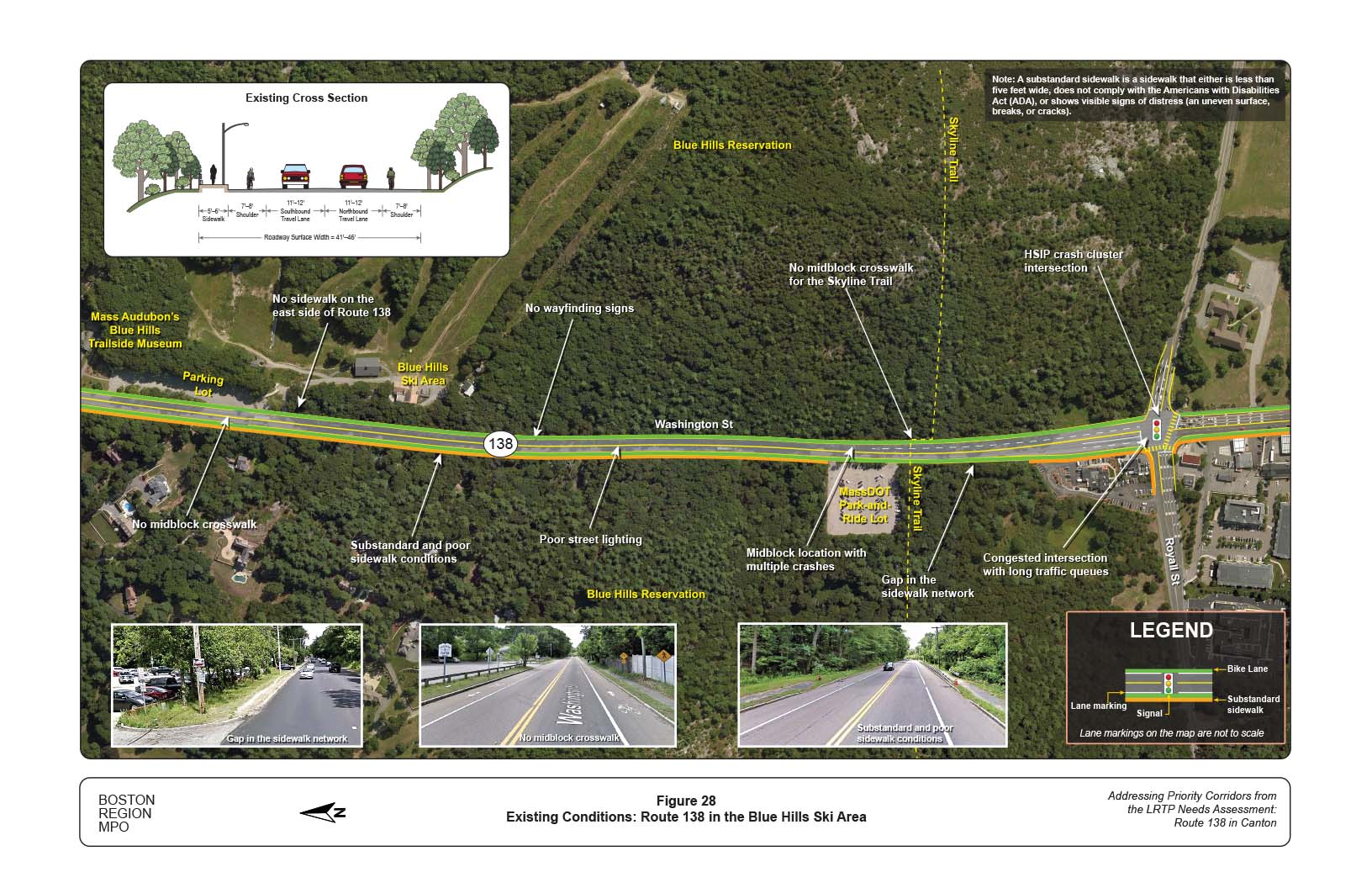
Figure 29.
Existing Conditions: Route 138 at Royall Street and the Interstate 93 Interchange

Figure 30.
Existing Conditions: Route 138 from Green Lodge Street to Washington Street
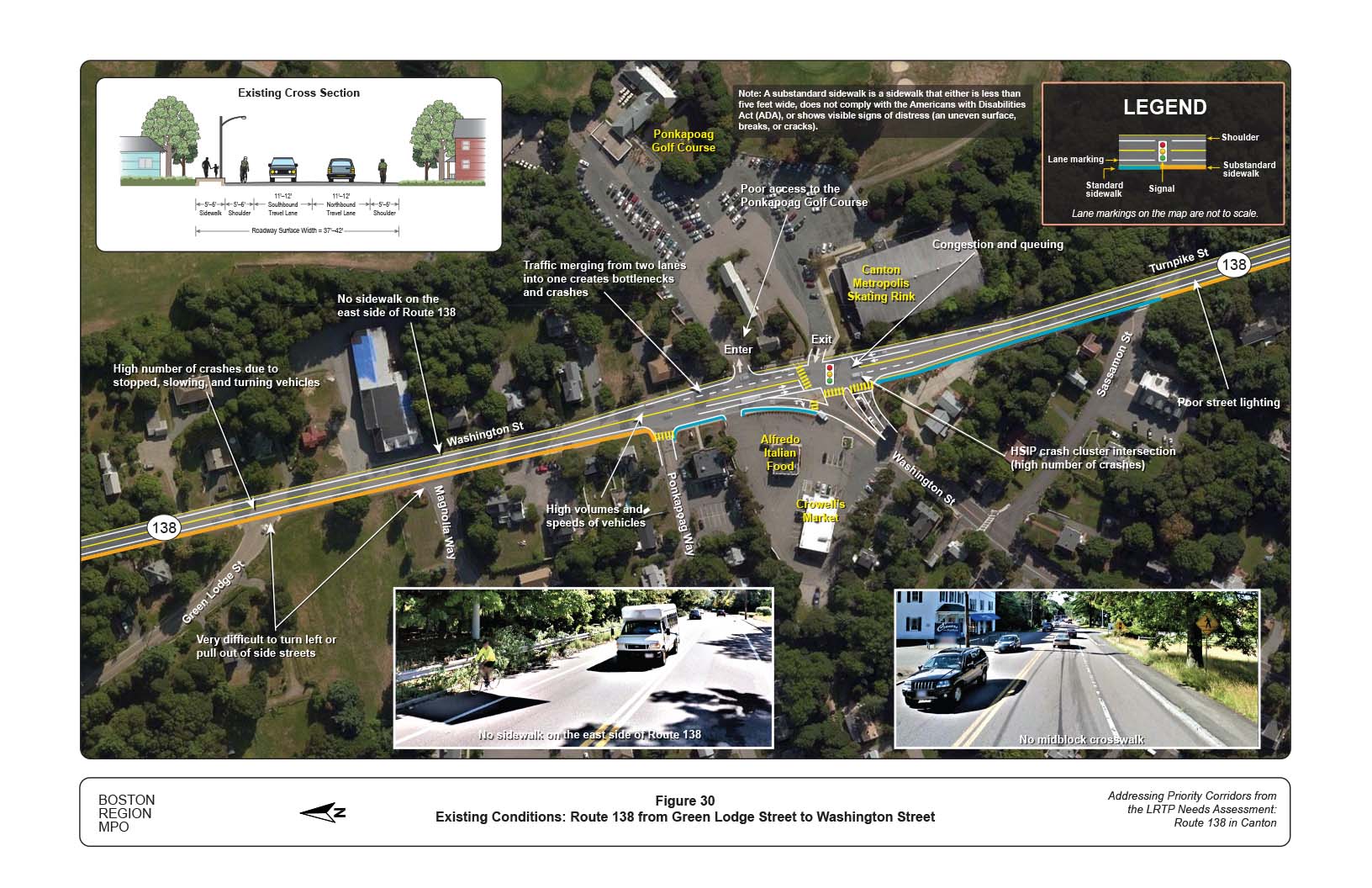
Figure 31.
Existing Conditions: Route 138 from Sunnybrook Lane to Meetinghouse Road
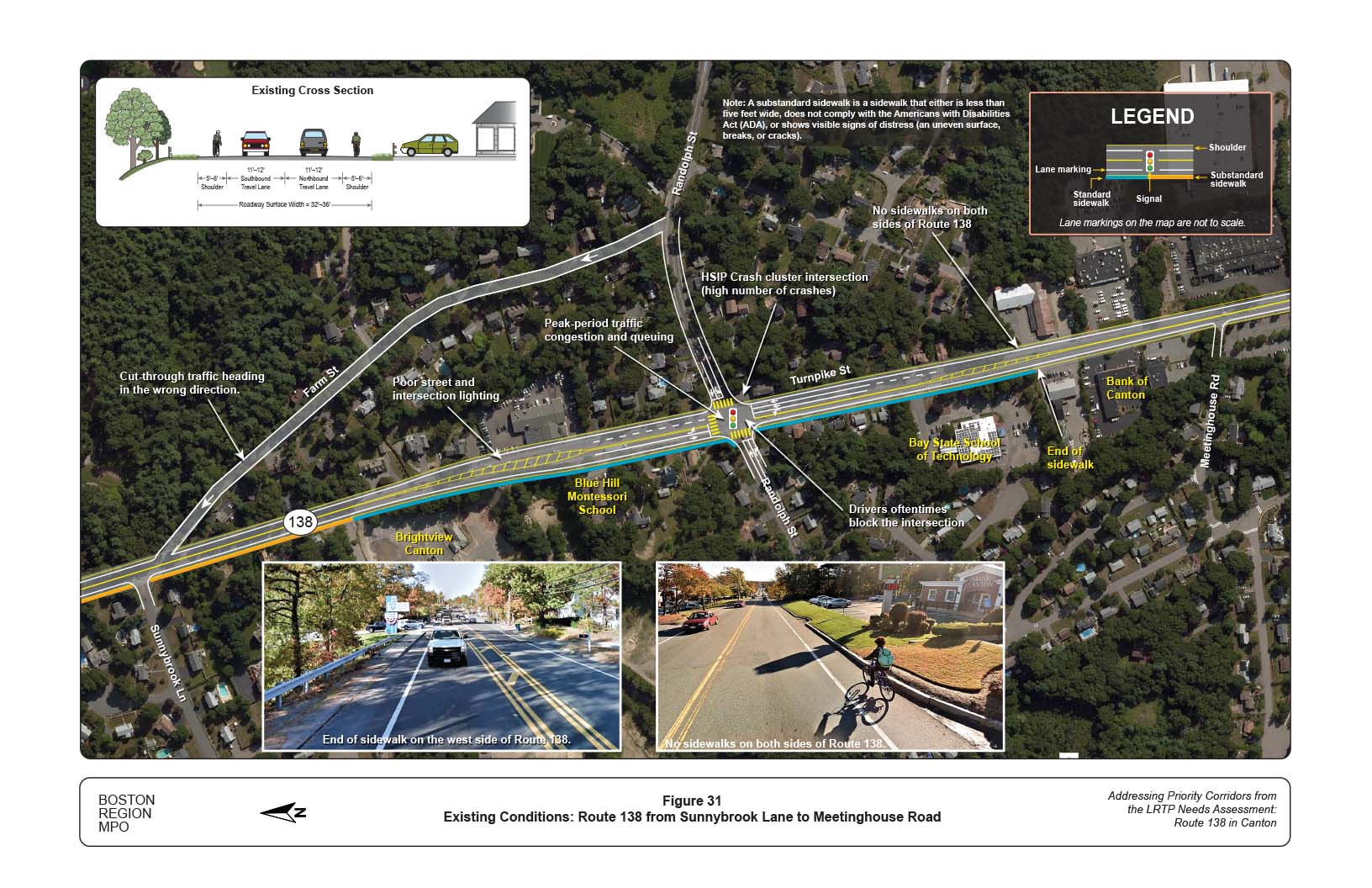
Figure 32.
Existing Conditions: Route 138 from Meetinghouse Road to Canton Point Road
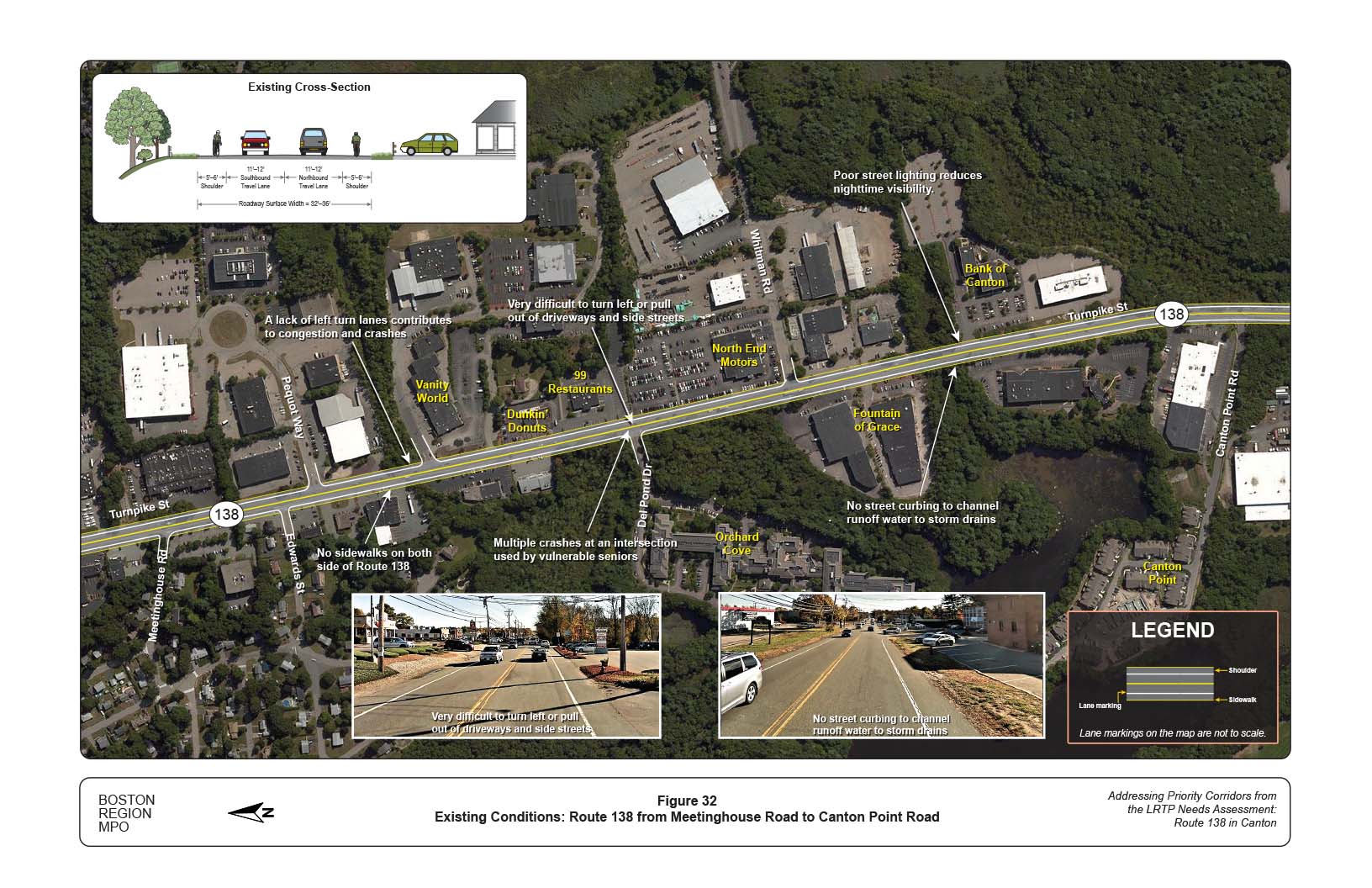
Figure 33.
Existing Conditions: Route 138 from Canton Point Road to Industrial Drive
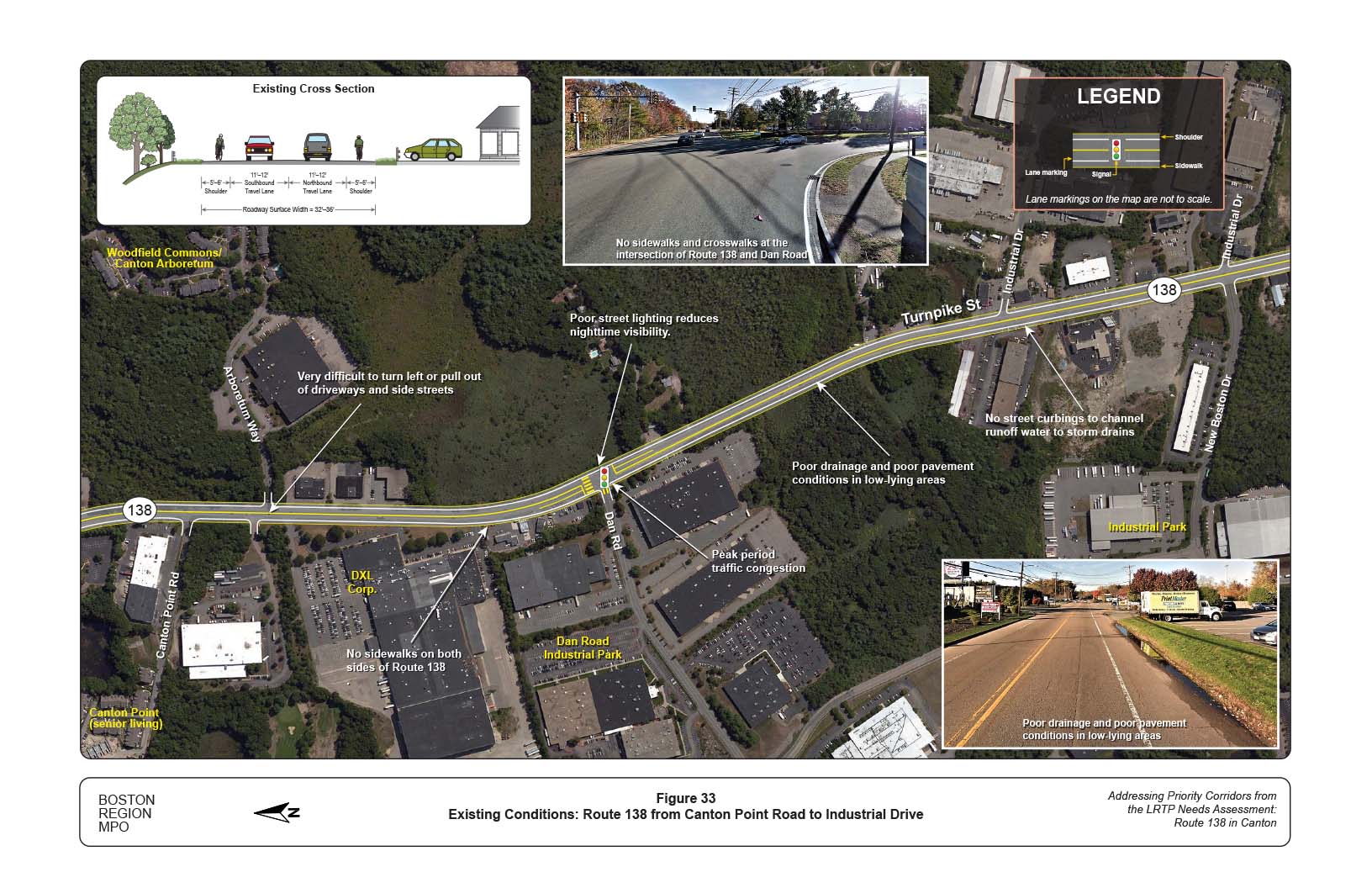
Figure 34.
Existing Conditions: Route 138 from Industrial Drive to Windsor Woods Lane
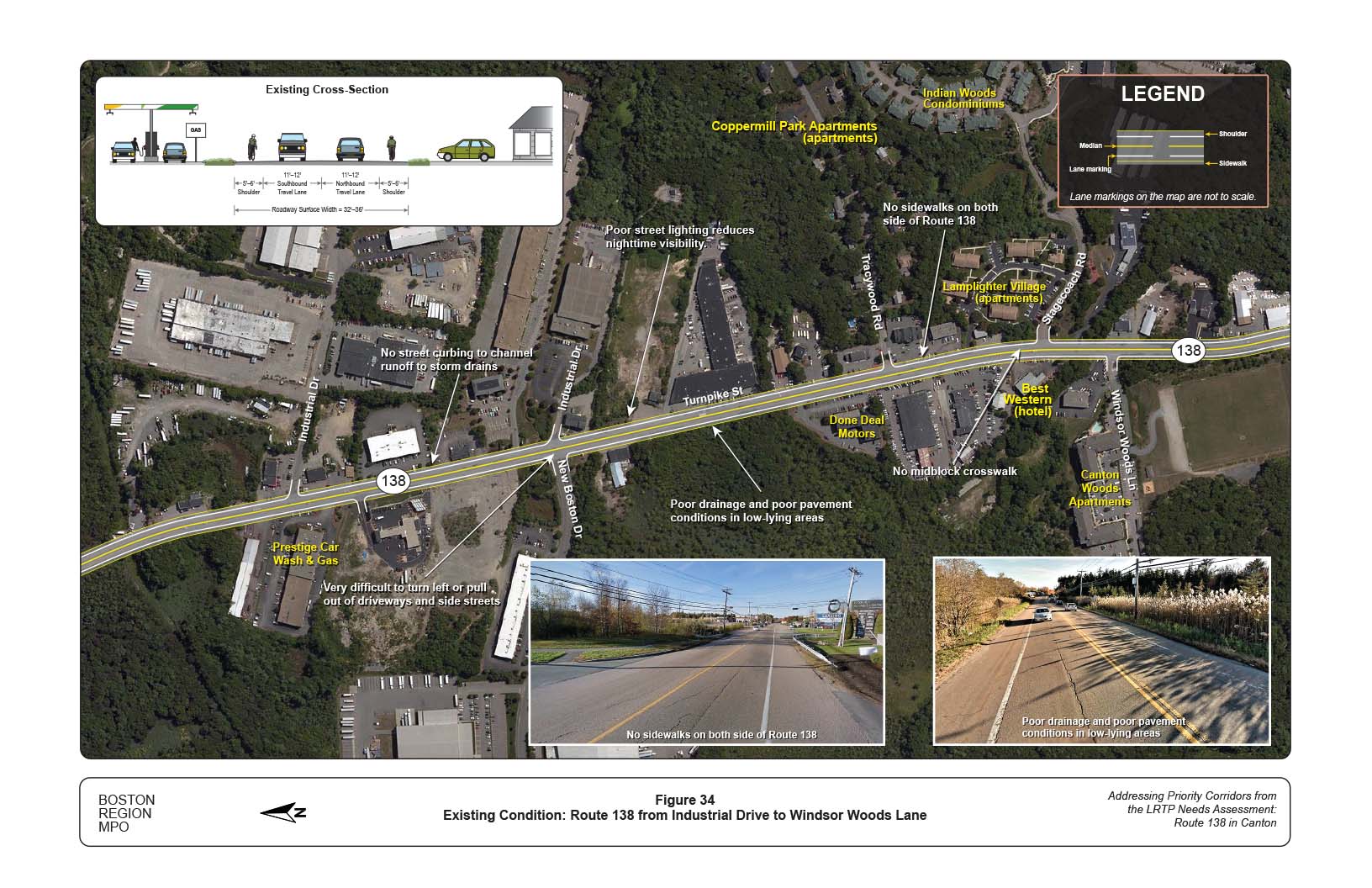
Figure 35.
Proposed Improvements: Route 138 in the Blue Hills Ski Area
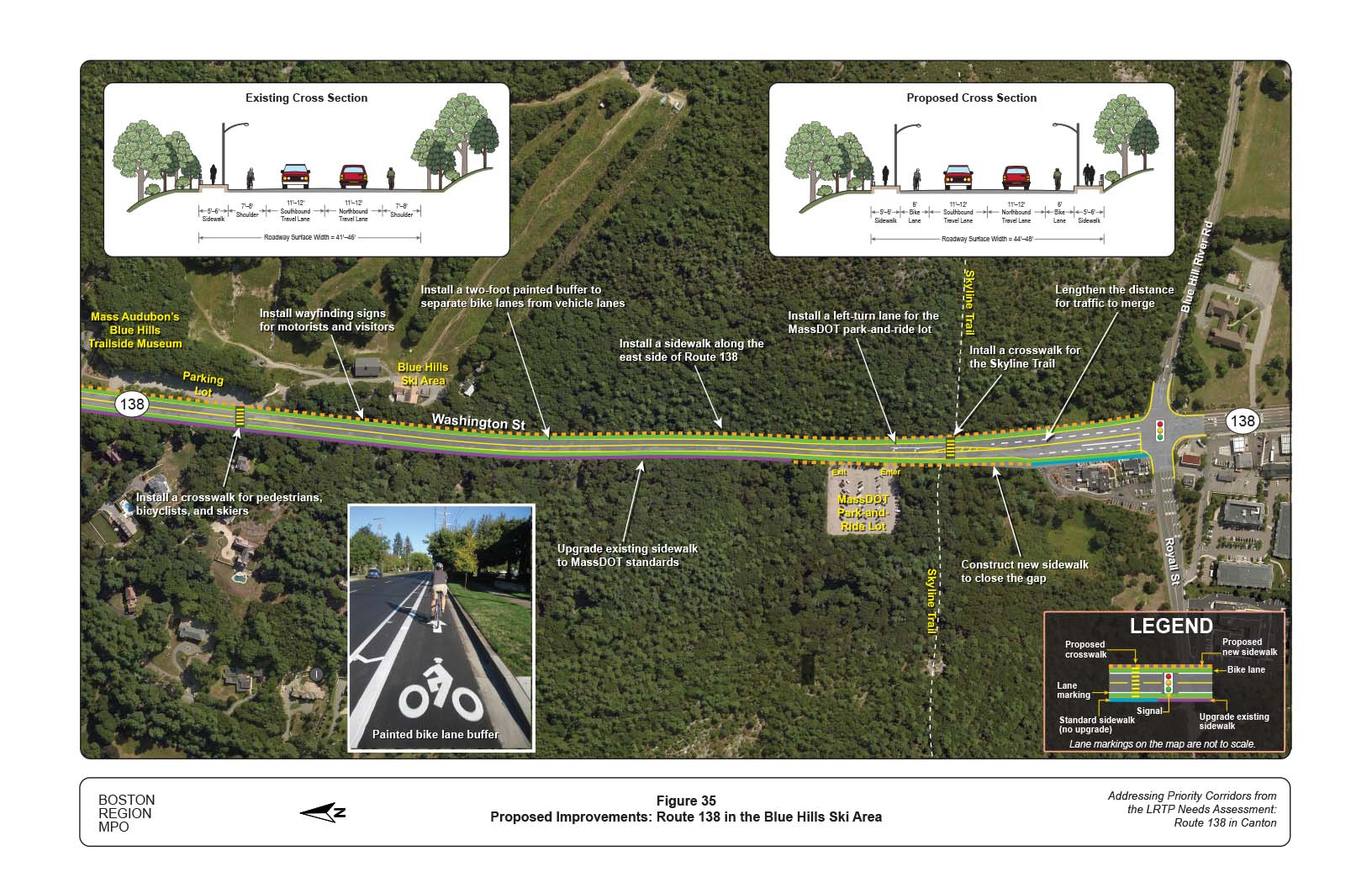
Figure 36.
Proposed Improvements: Intersection of Route 138 and Royall Street
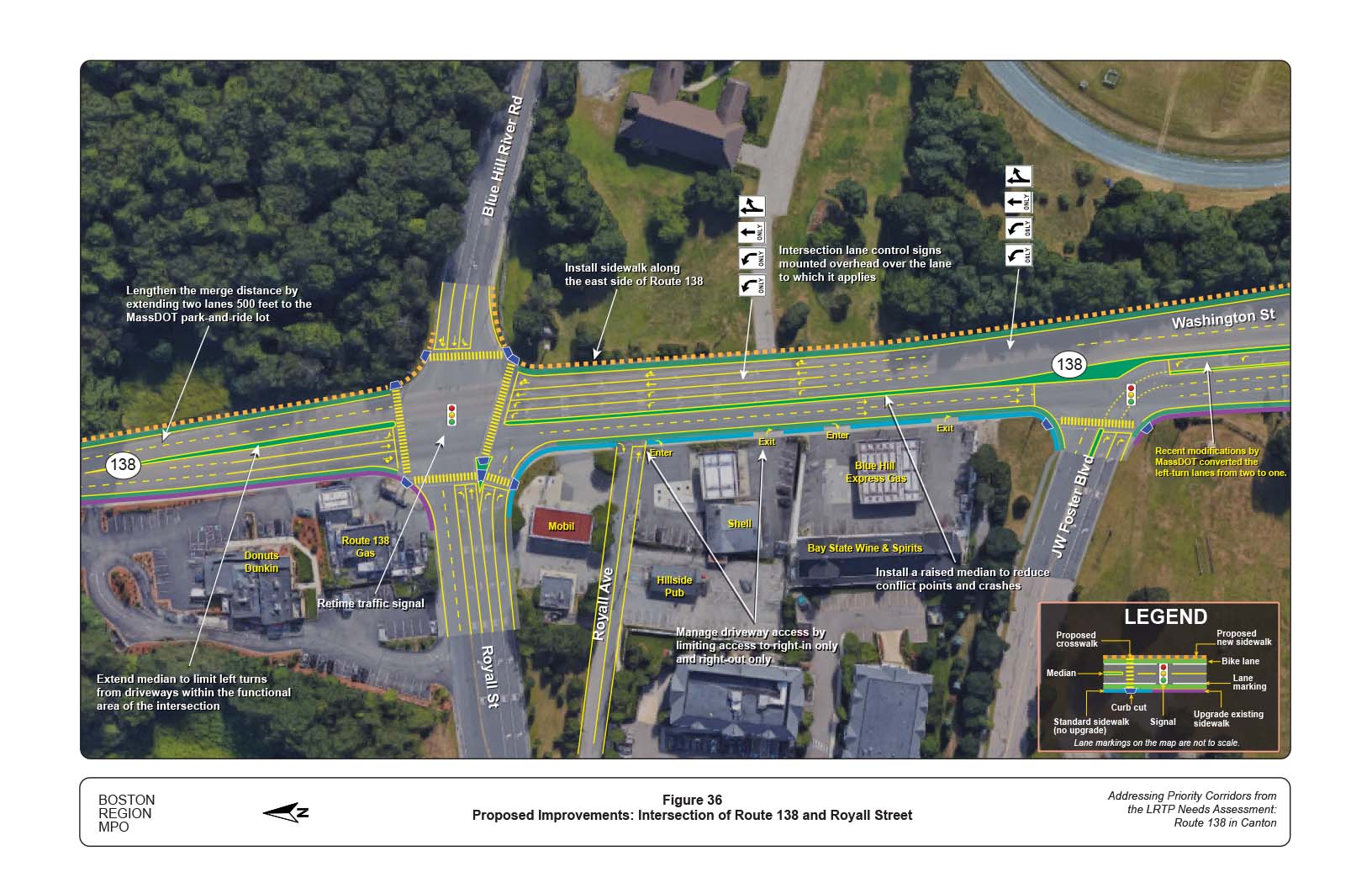
Figure 37.
Proposed Improvements: Route 138 at Royall Street and the Interstate 93 Interchange
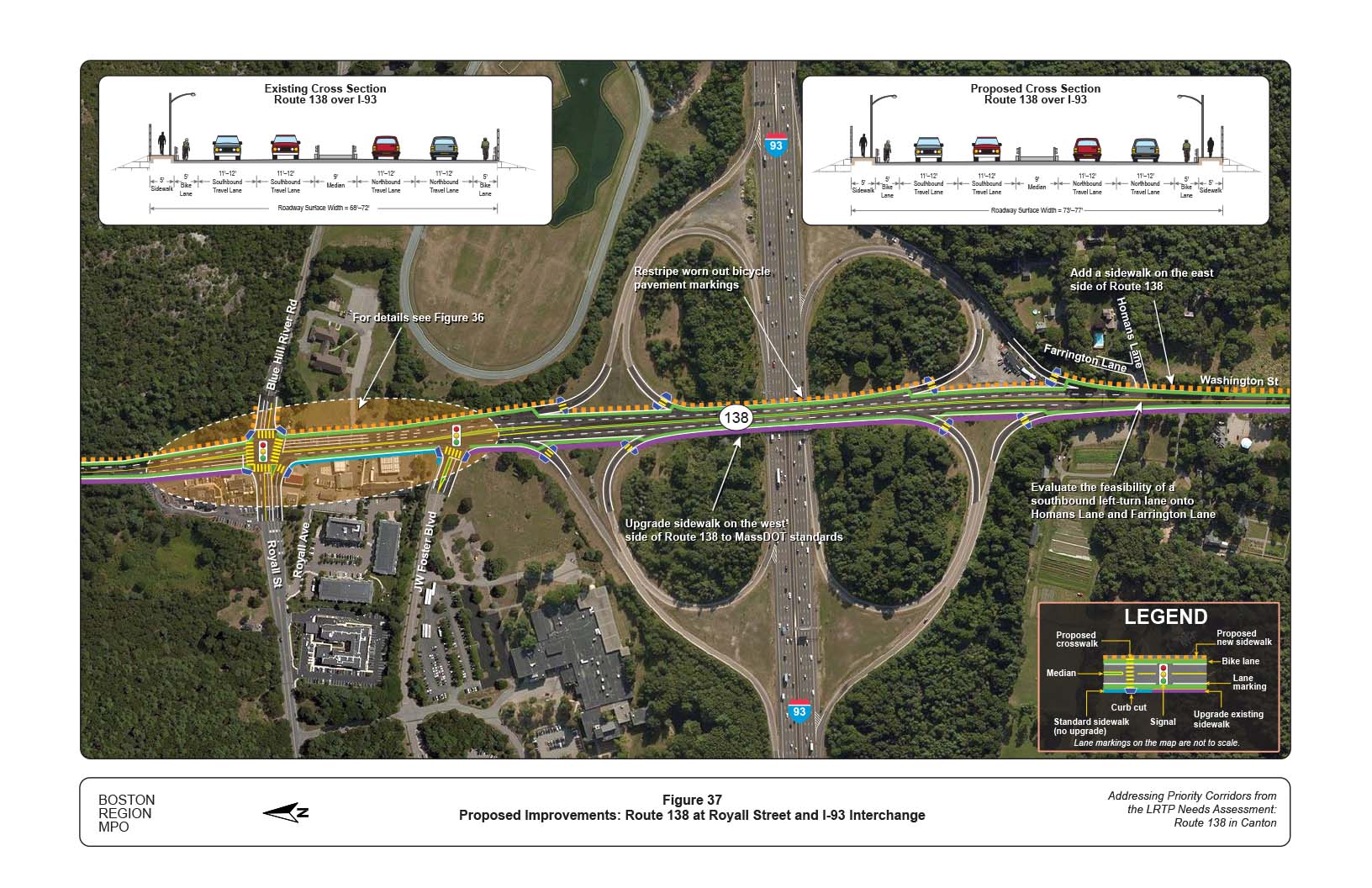
Figure 38.
Proposed Improvements: Route 138 from Green Lodge Street to Washington Street
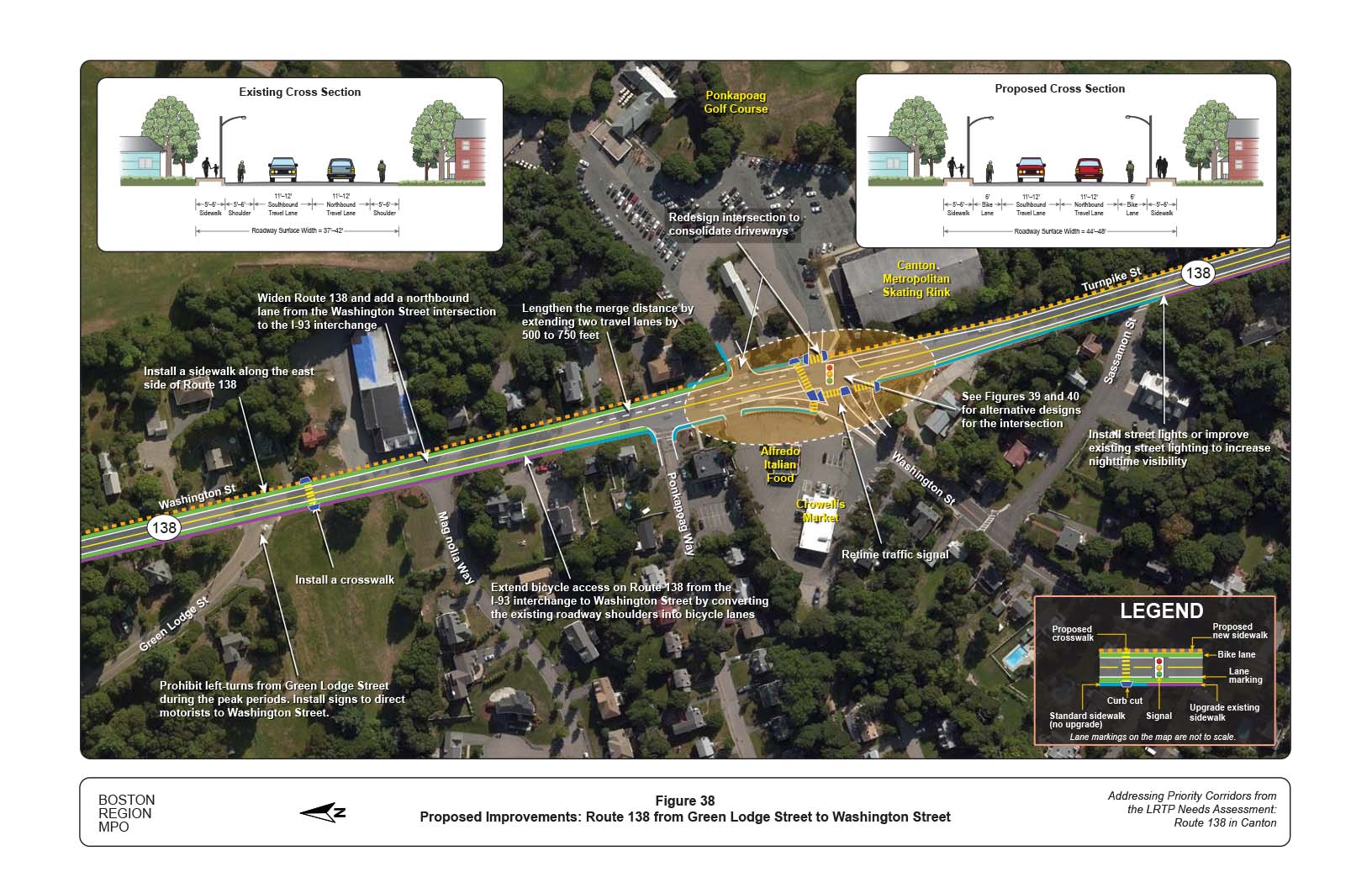
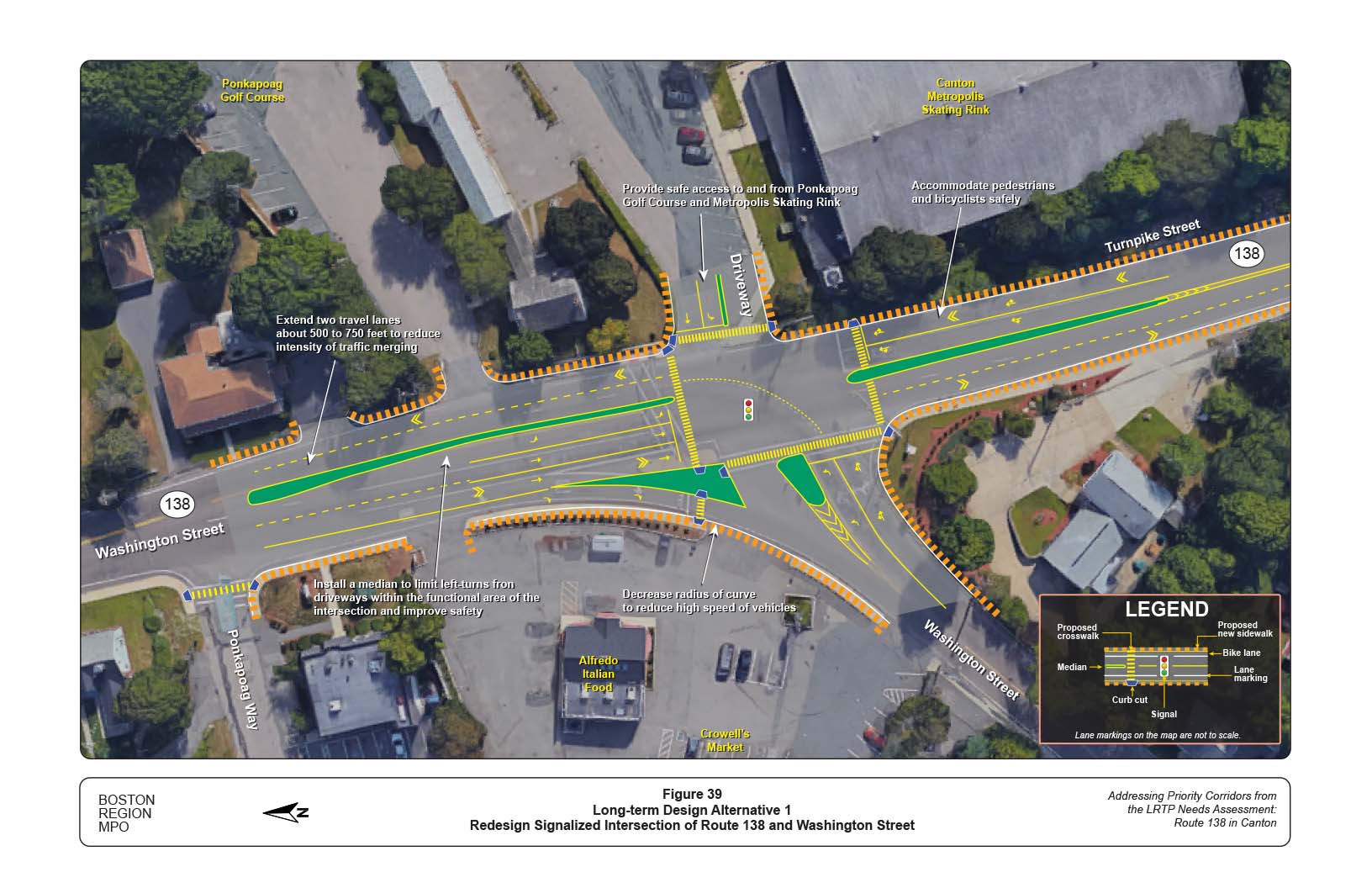
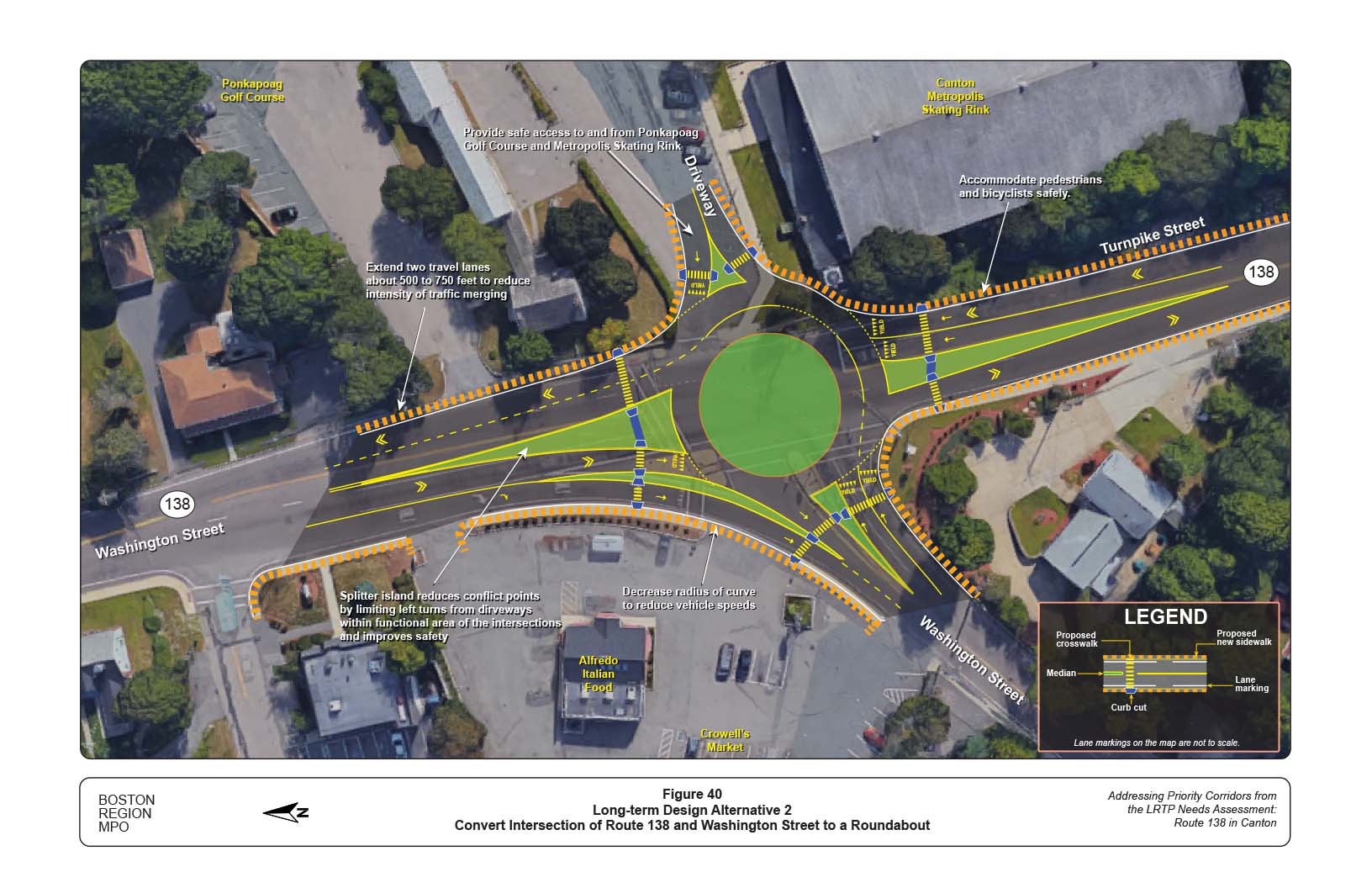
Figure 41.
Proposed Improvements: Route 138 from Sunnybrook Lane to Meetinghouse Road
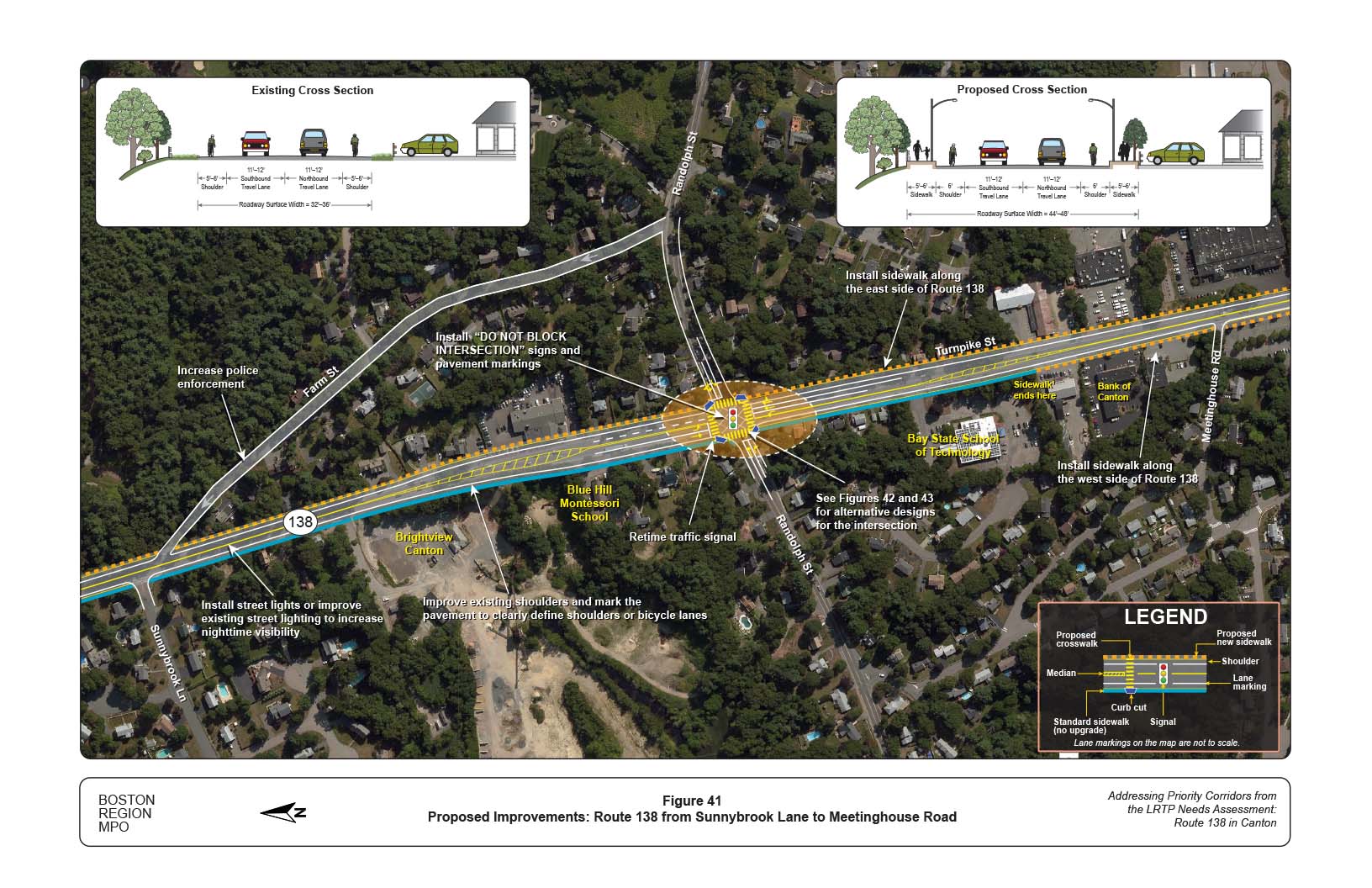


Figure 44.
Proposed Improvements: Route 138 from Meetinghouse Road to Canton Point Road
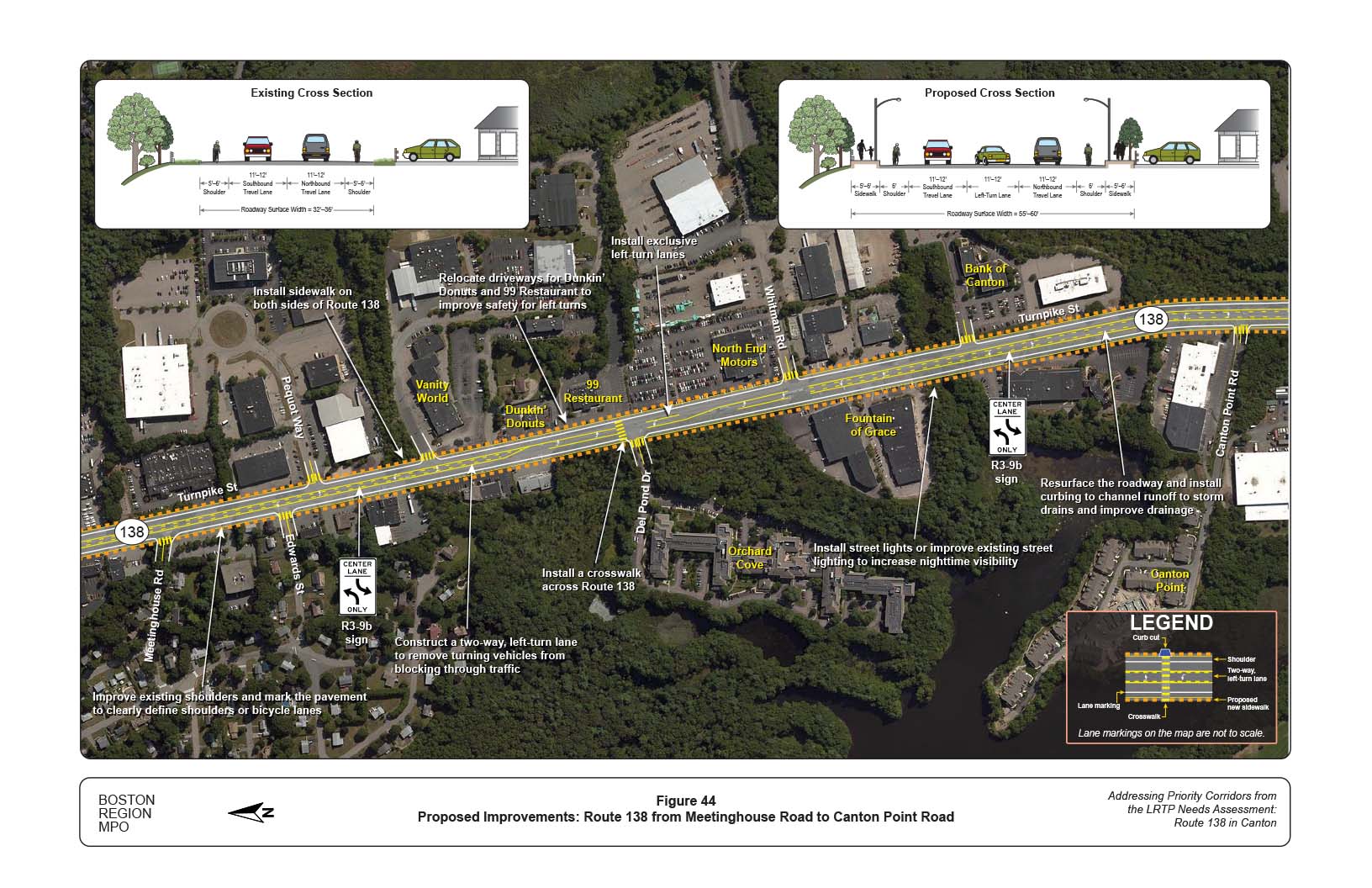
Figure 45.
Proposed Improvements: Route 138 from Canton Point Road to Industrial Drive
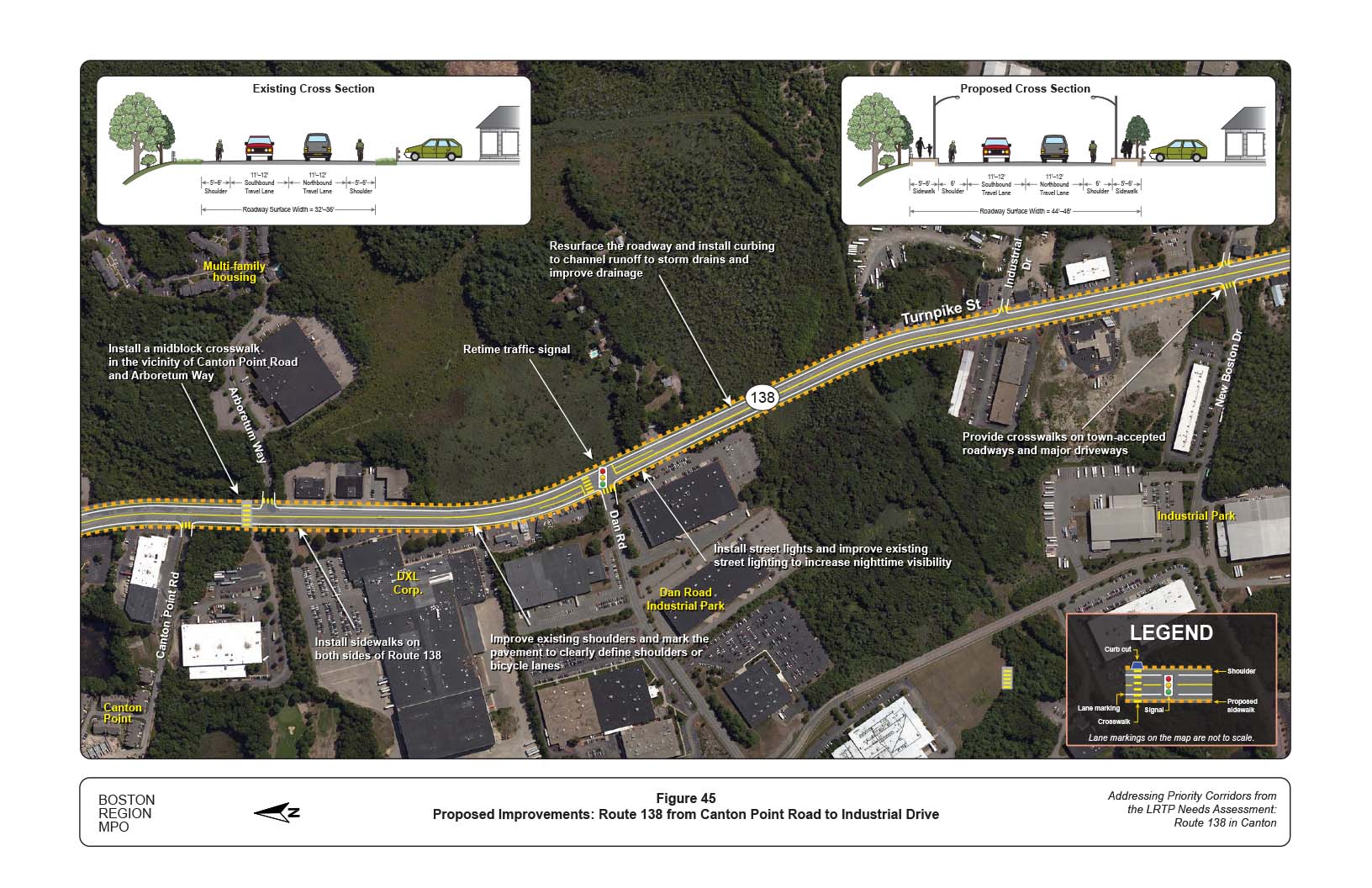
Figure 46.
Proposed Improvements: Route 138 from Industrial Drive to Windsor Woods Lane

Figure 47.
2040 Level of Service for Route 138 Intersections: Weekday AM Peak Period

Figure 48.
2040 Level of Service for Route 138 Intersections: Weekday PM Peak Period
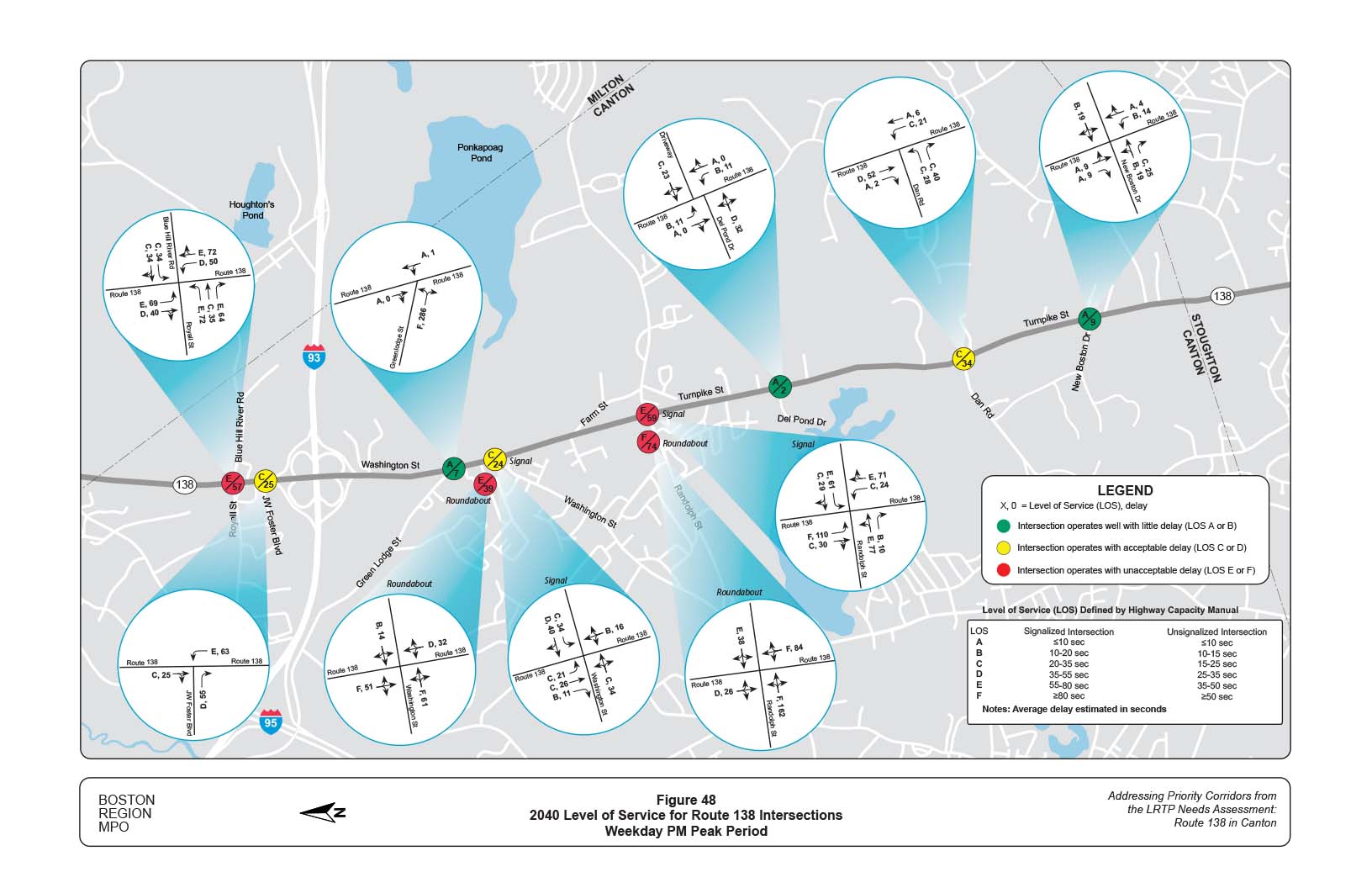
Figure 49.
Examples of Accessible Curb Ramps and High Visibility Crosswalks
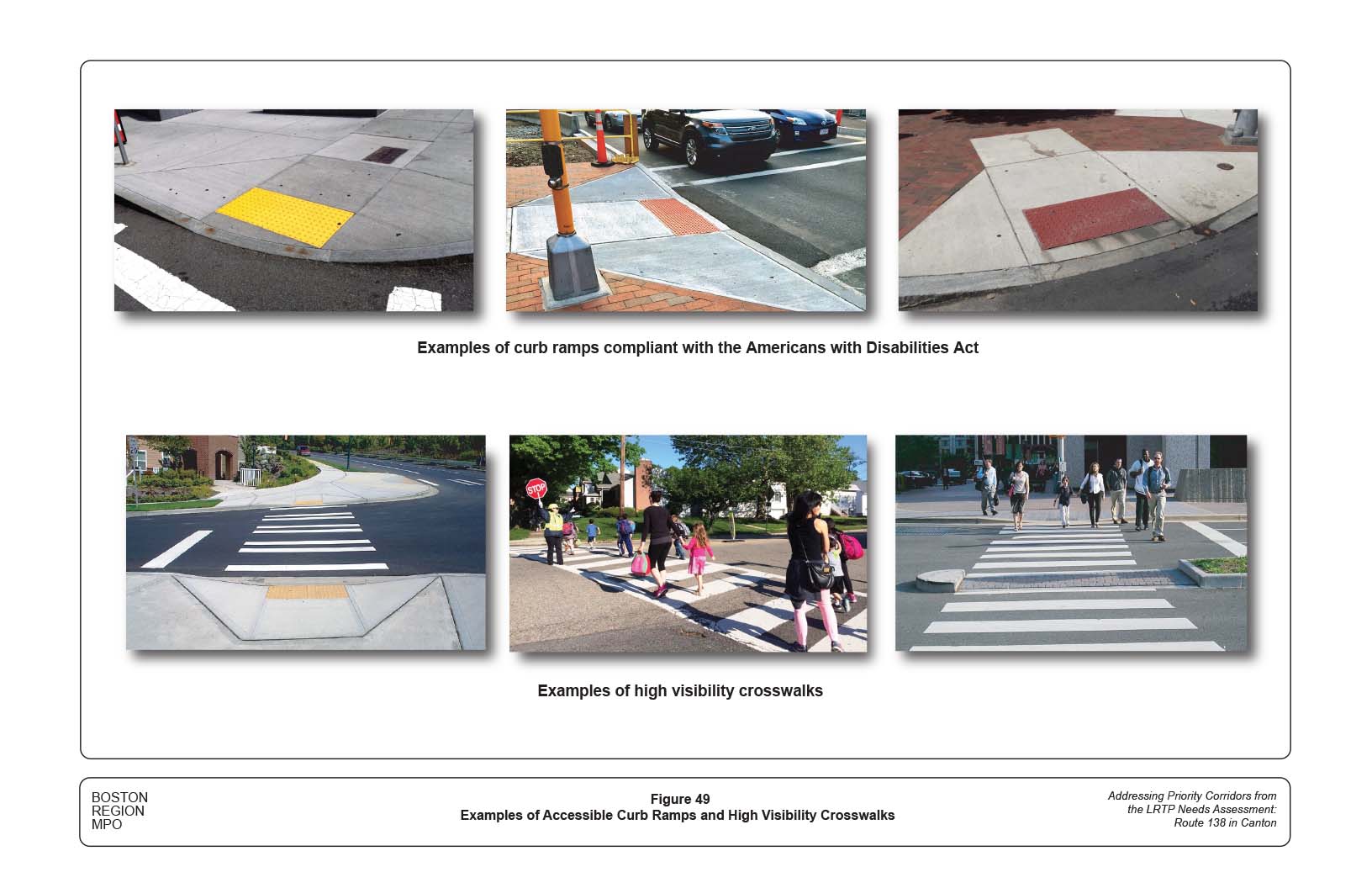
Figure 50.
Examples of Sidewalk Designs and Median and Pedestrian Refuge Areas
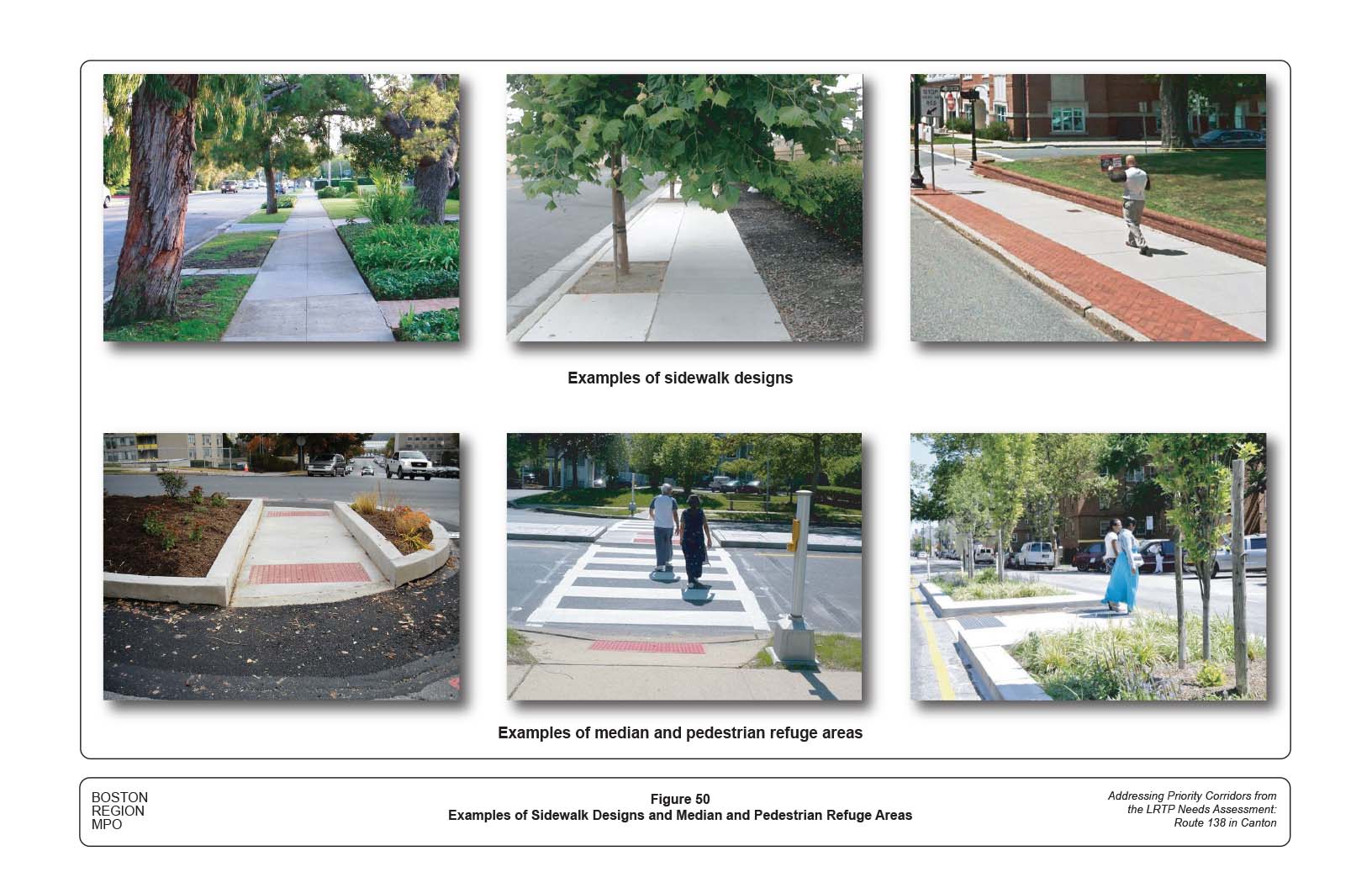
Figure 51.
Examples of Pedestrian Crossing Signals
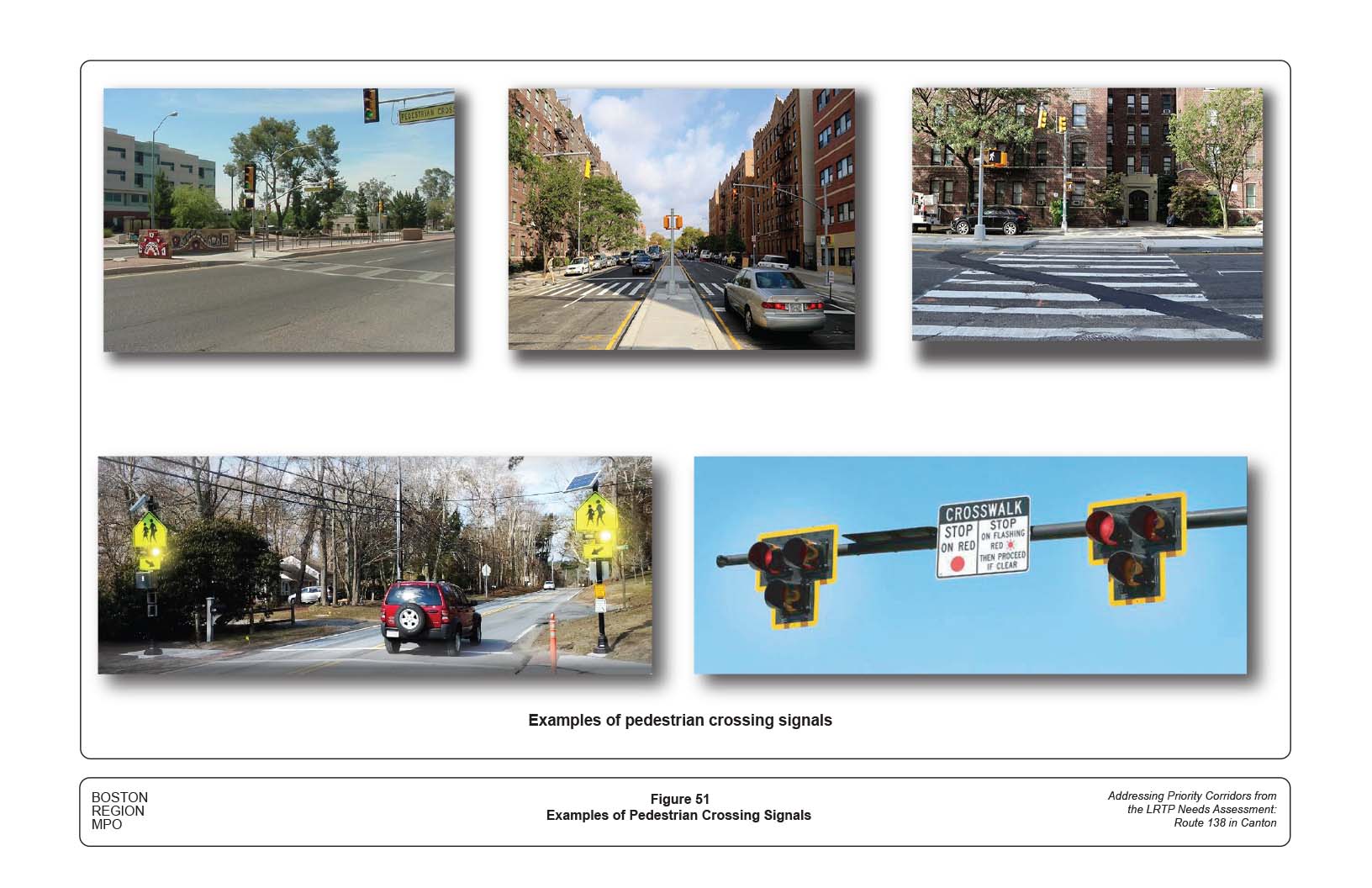
Figure 52.
Examples of Roadway Types Proposed in this Study

Appendices